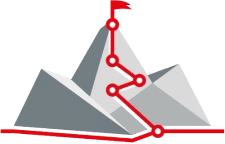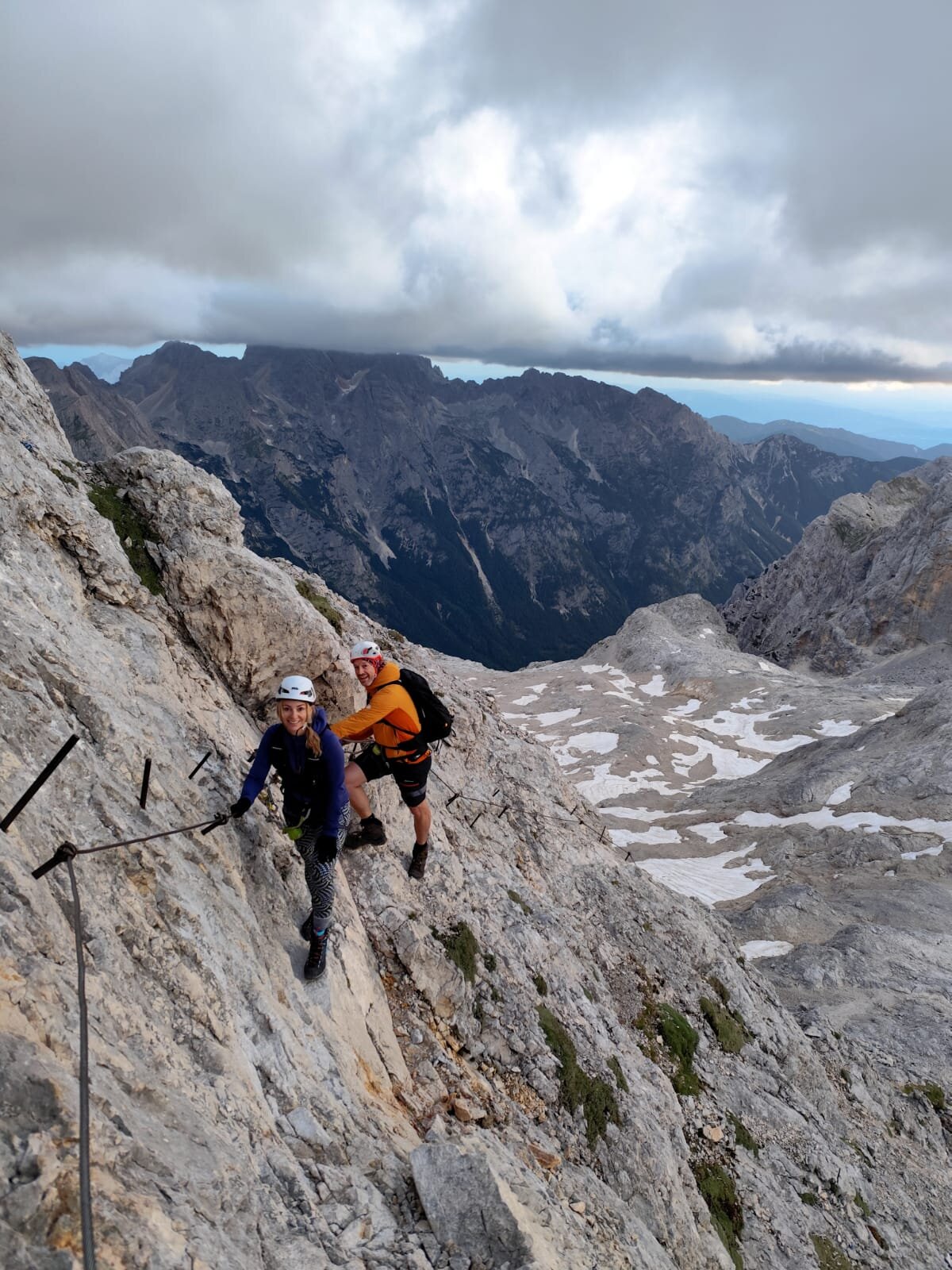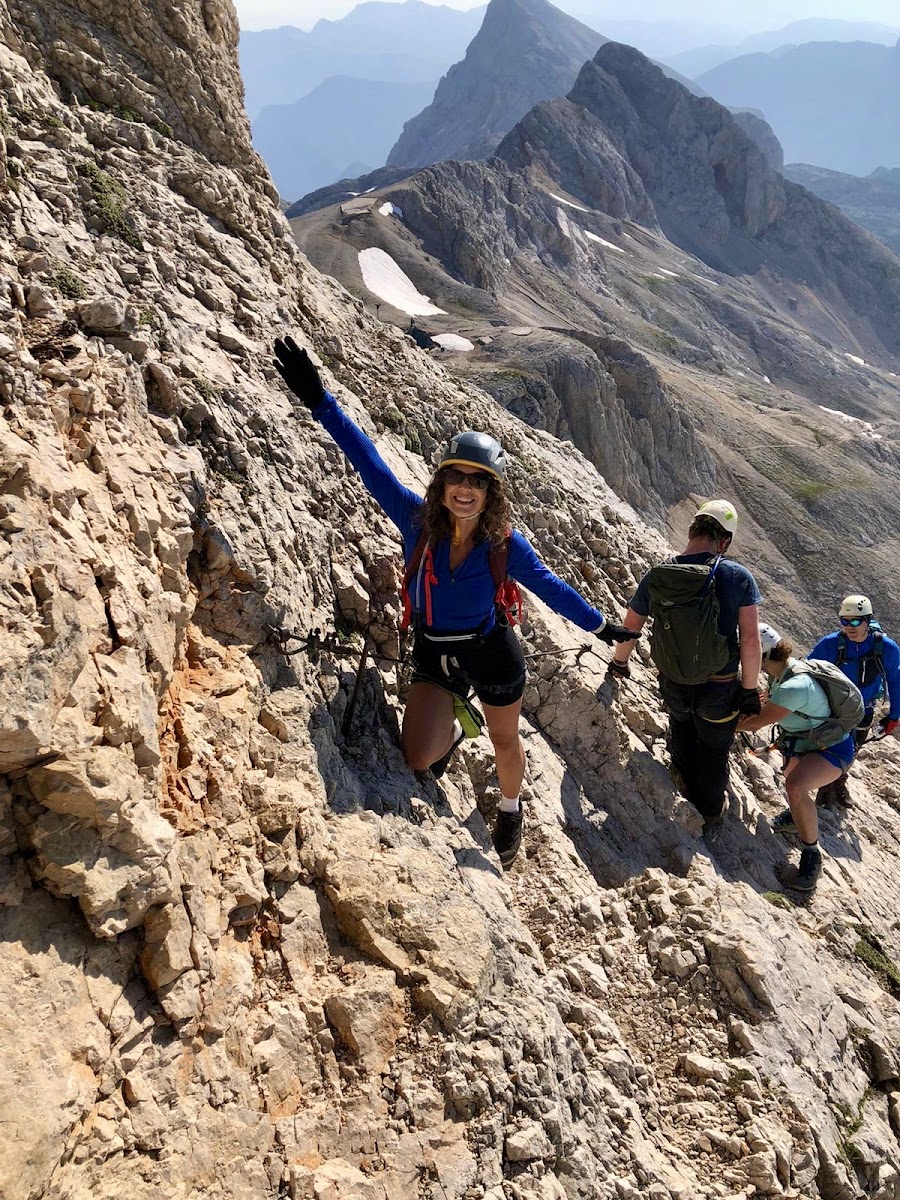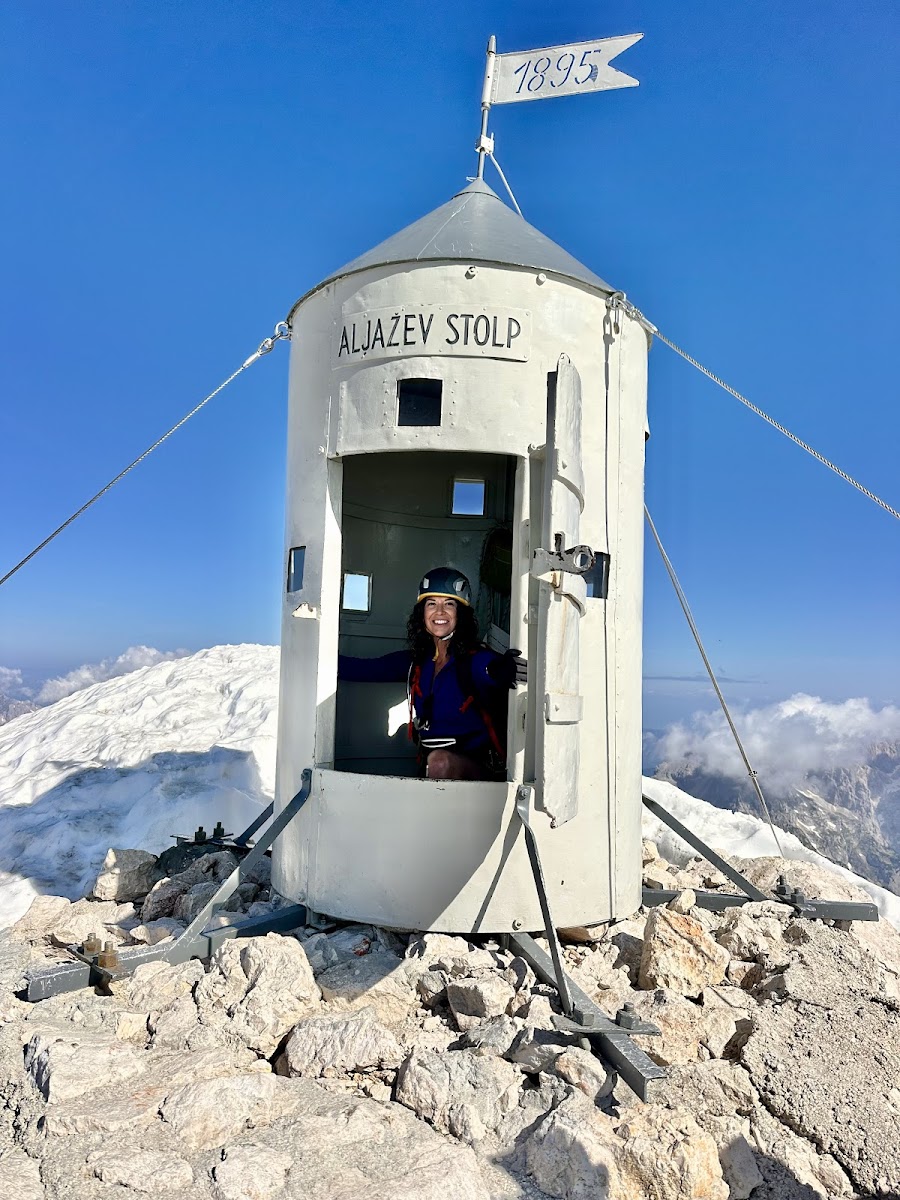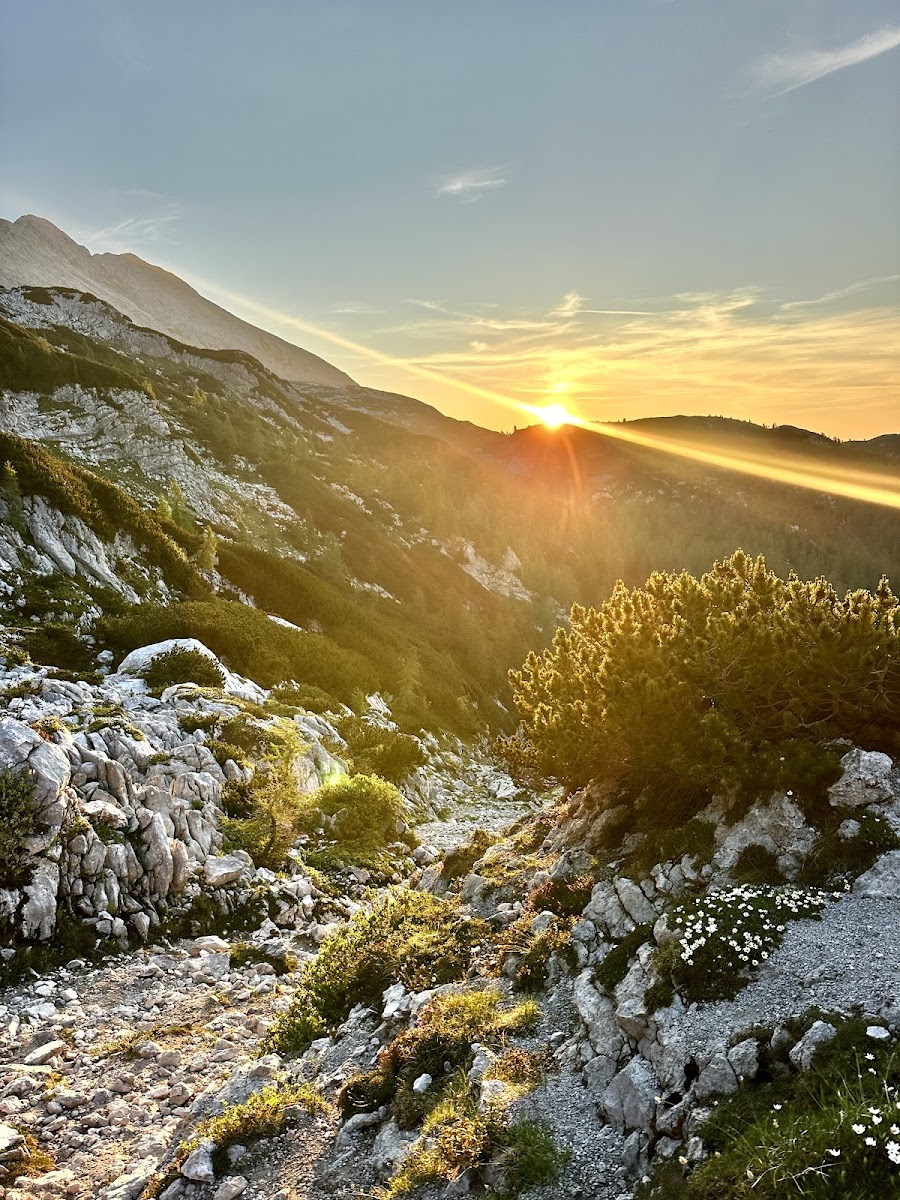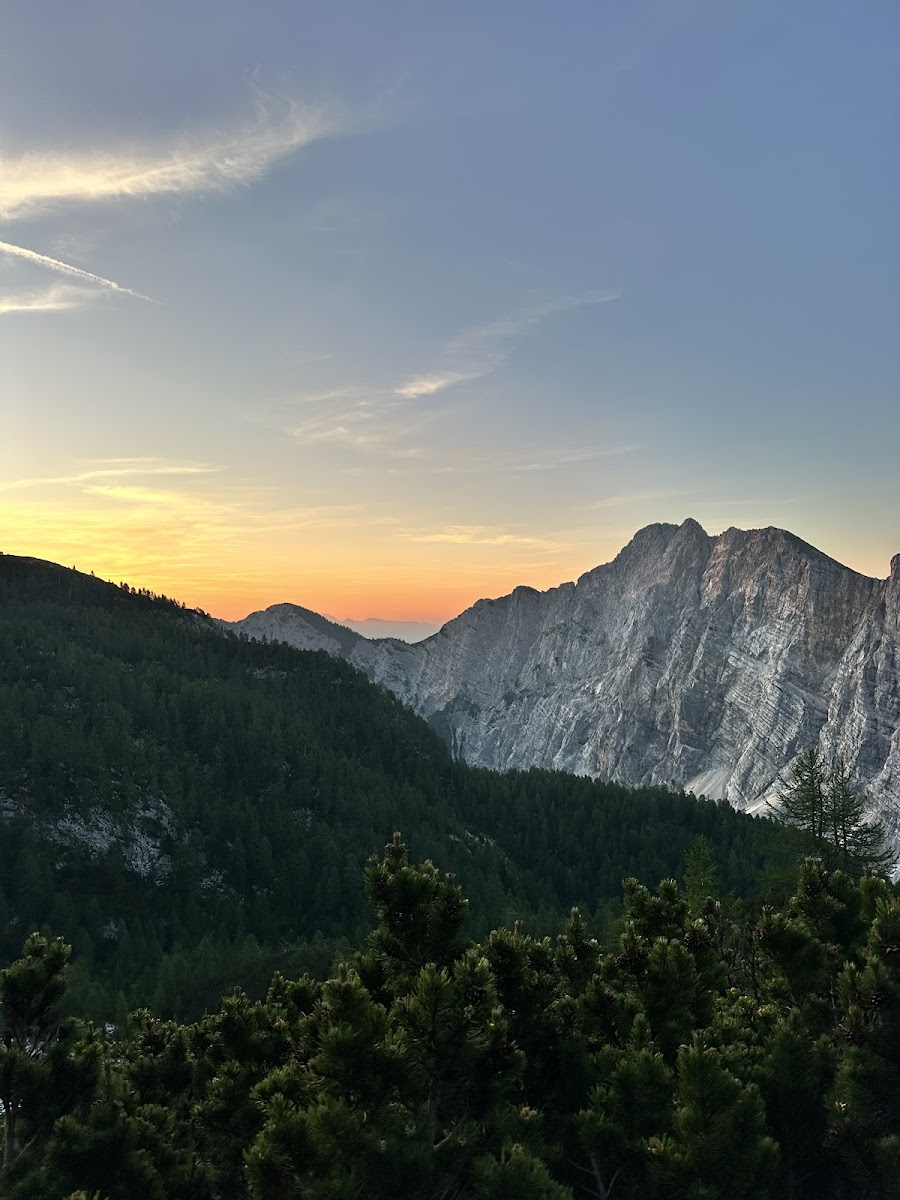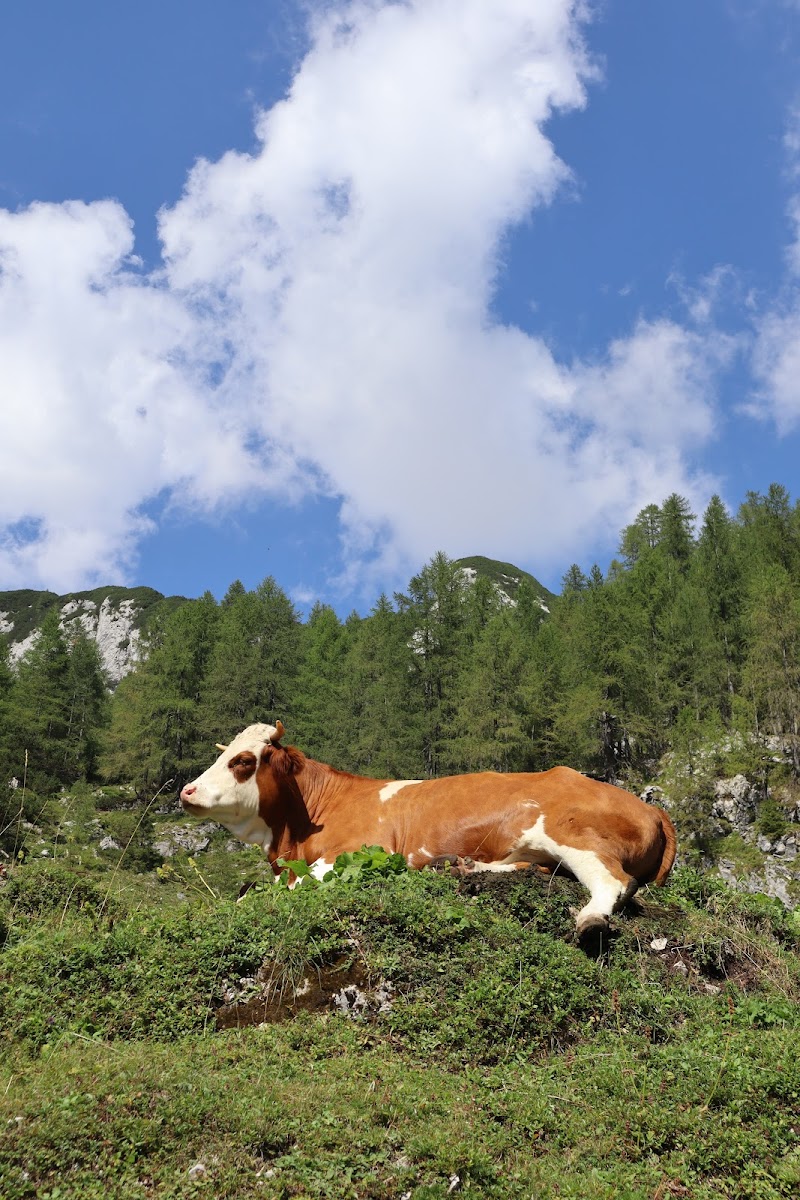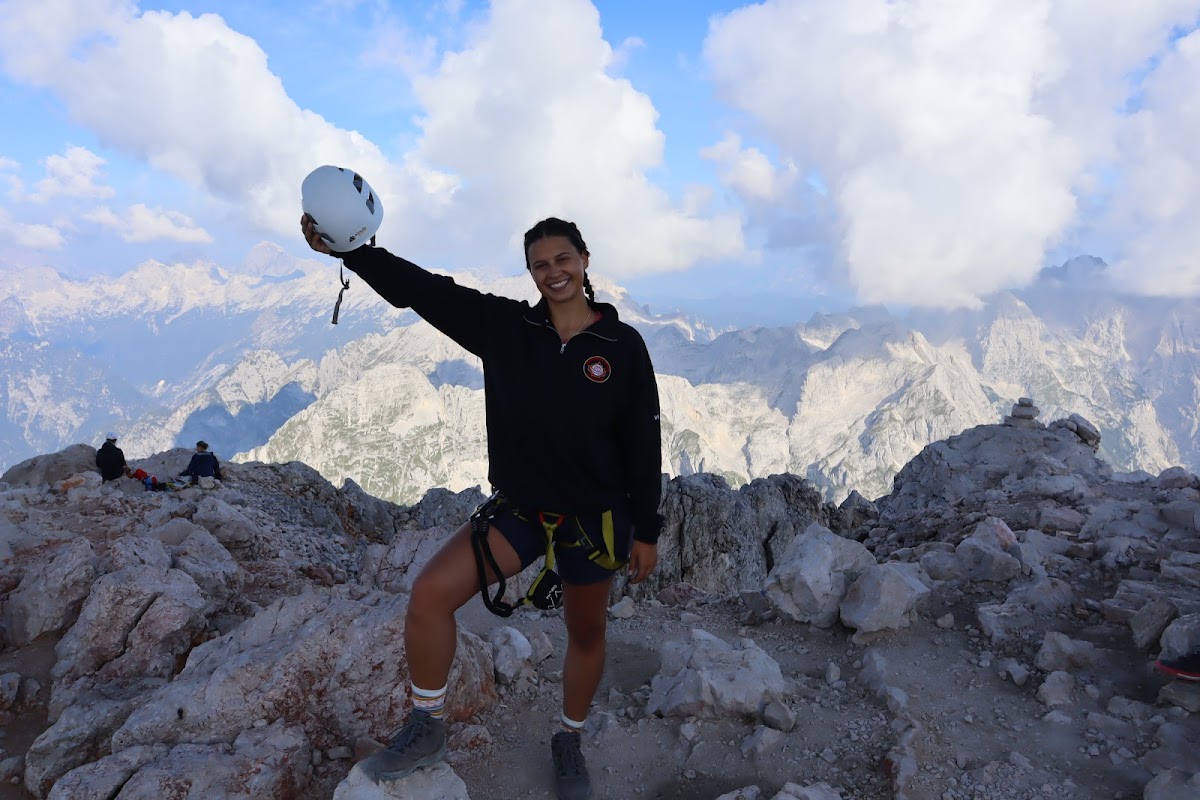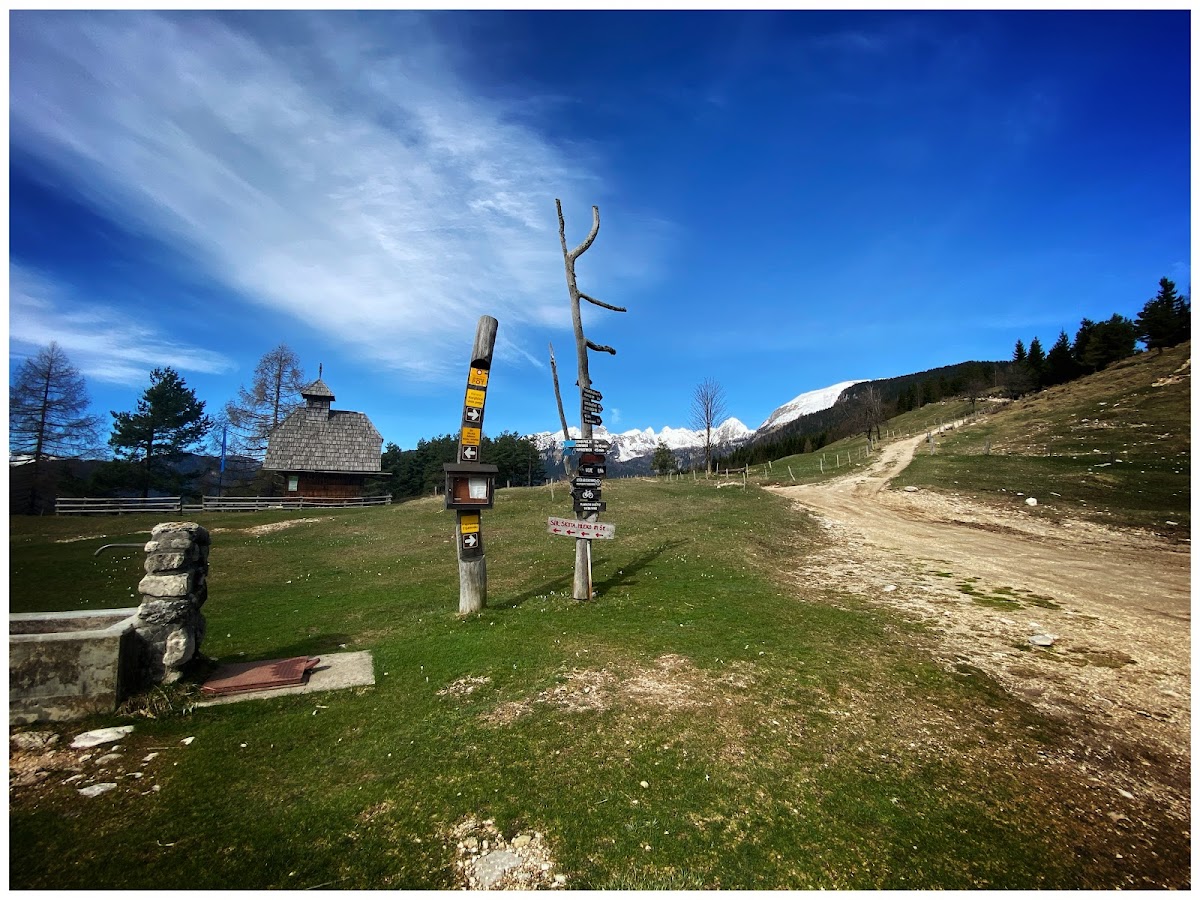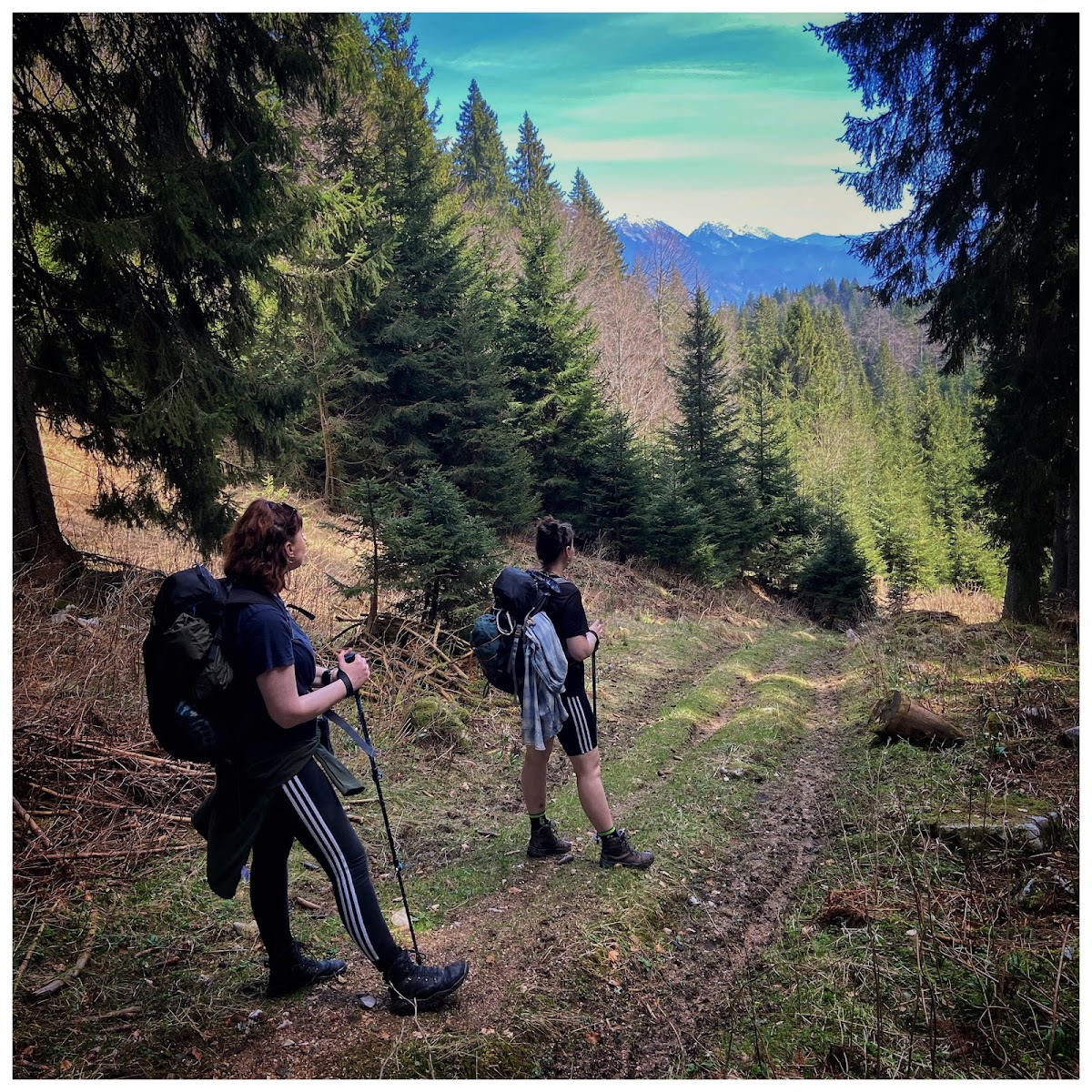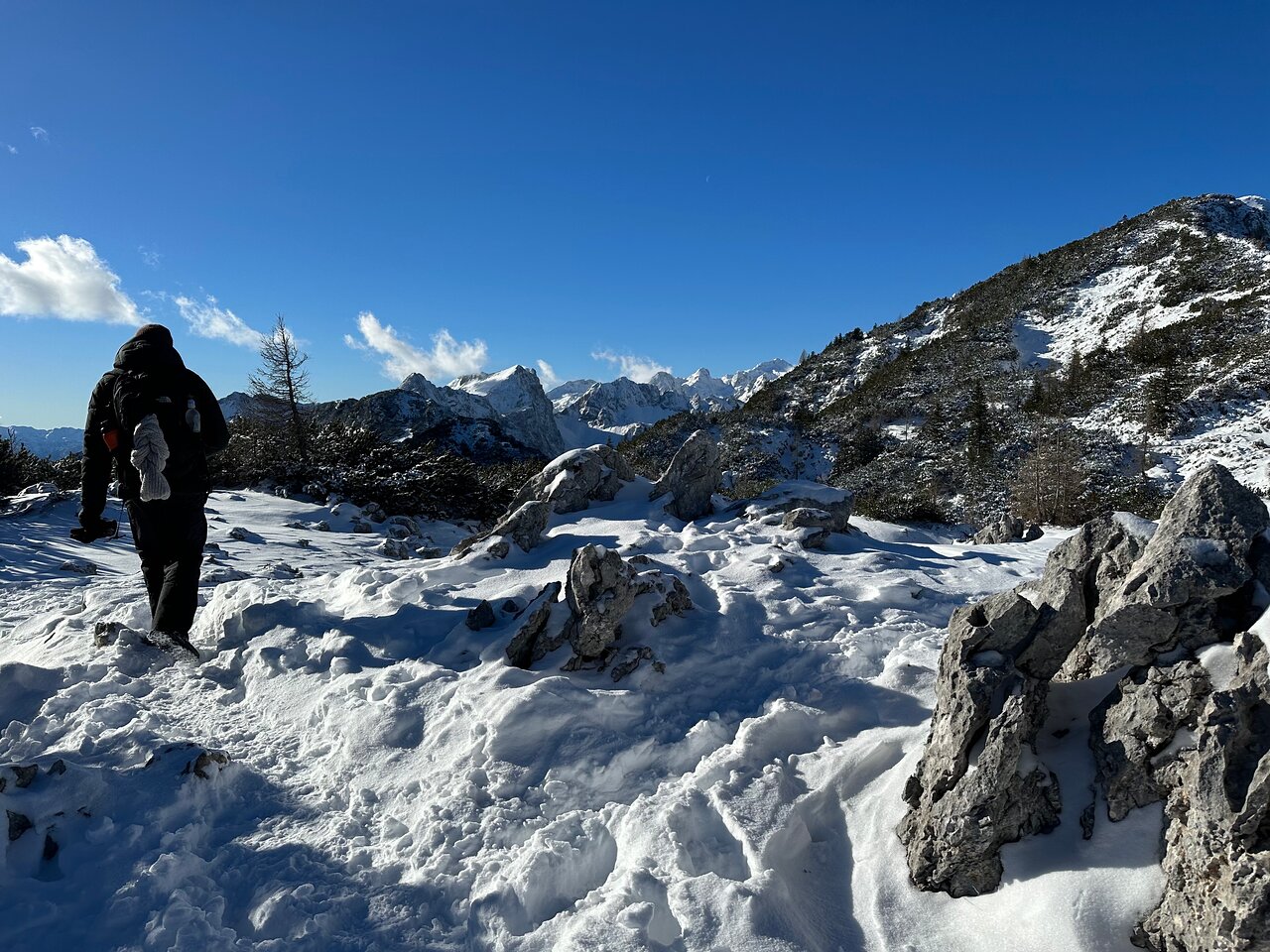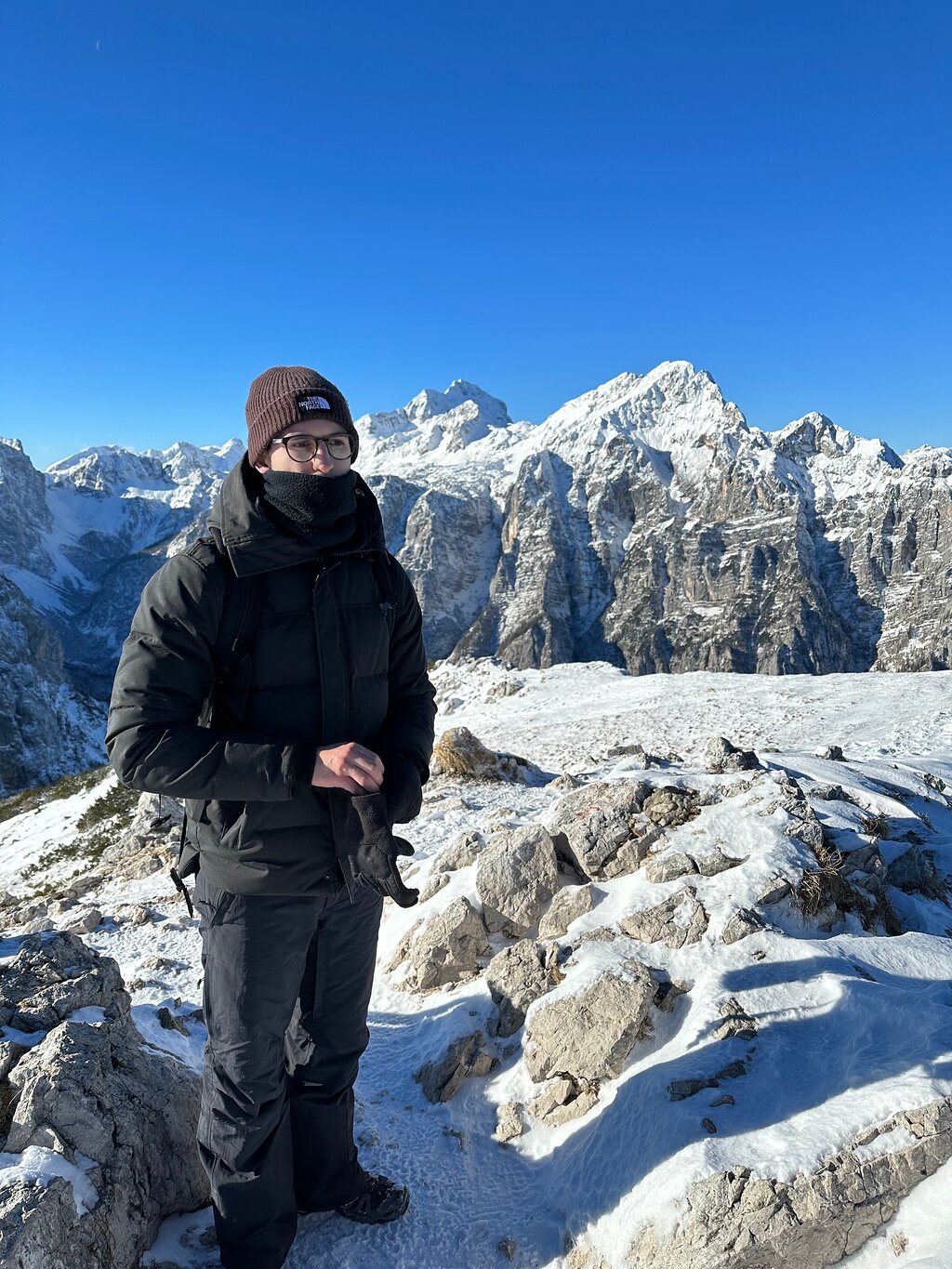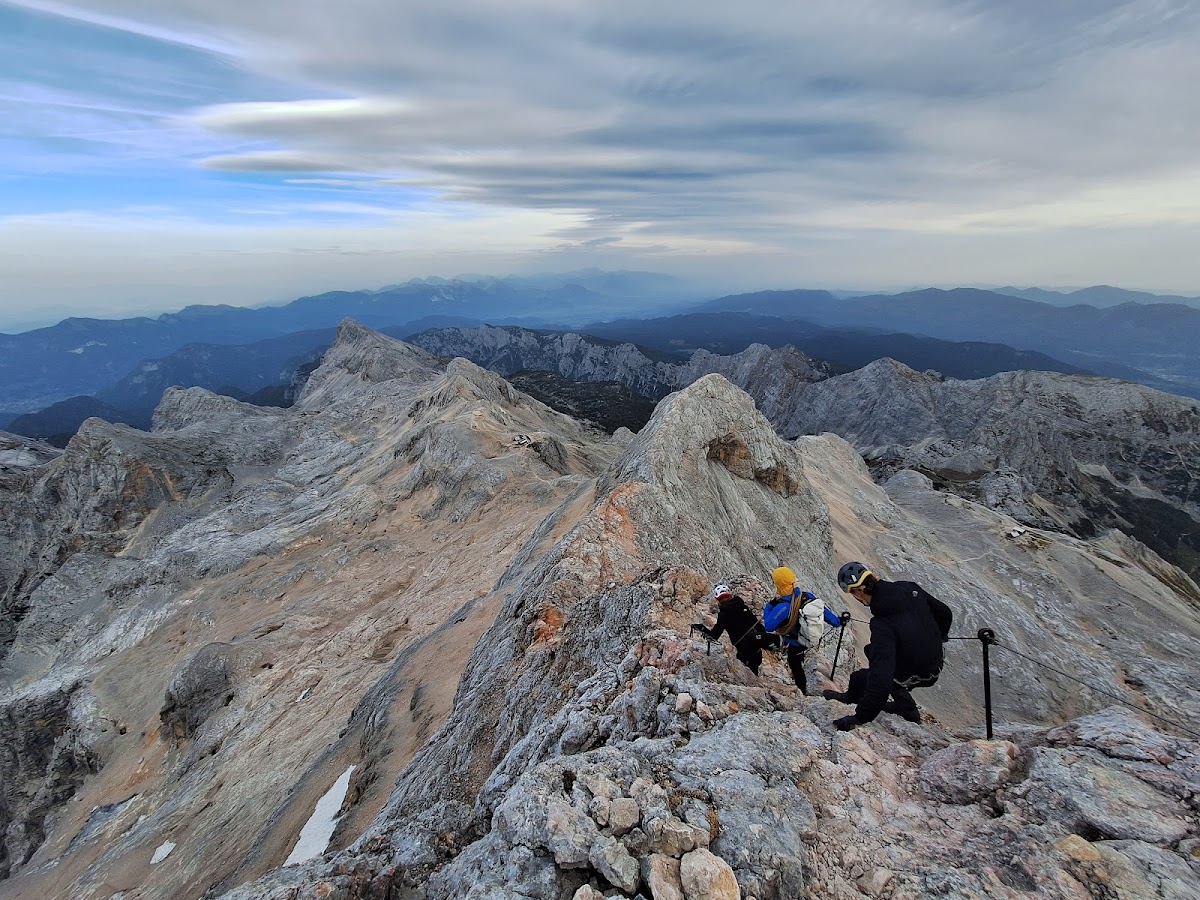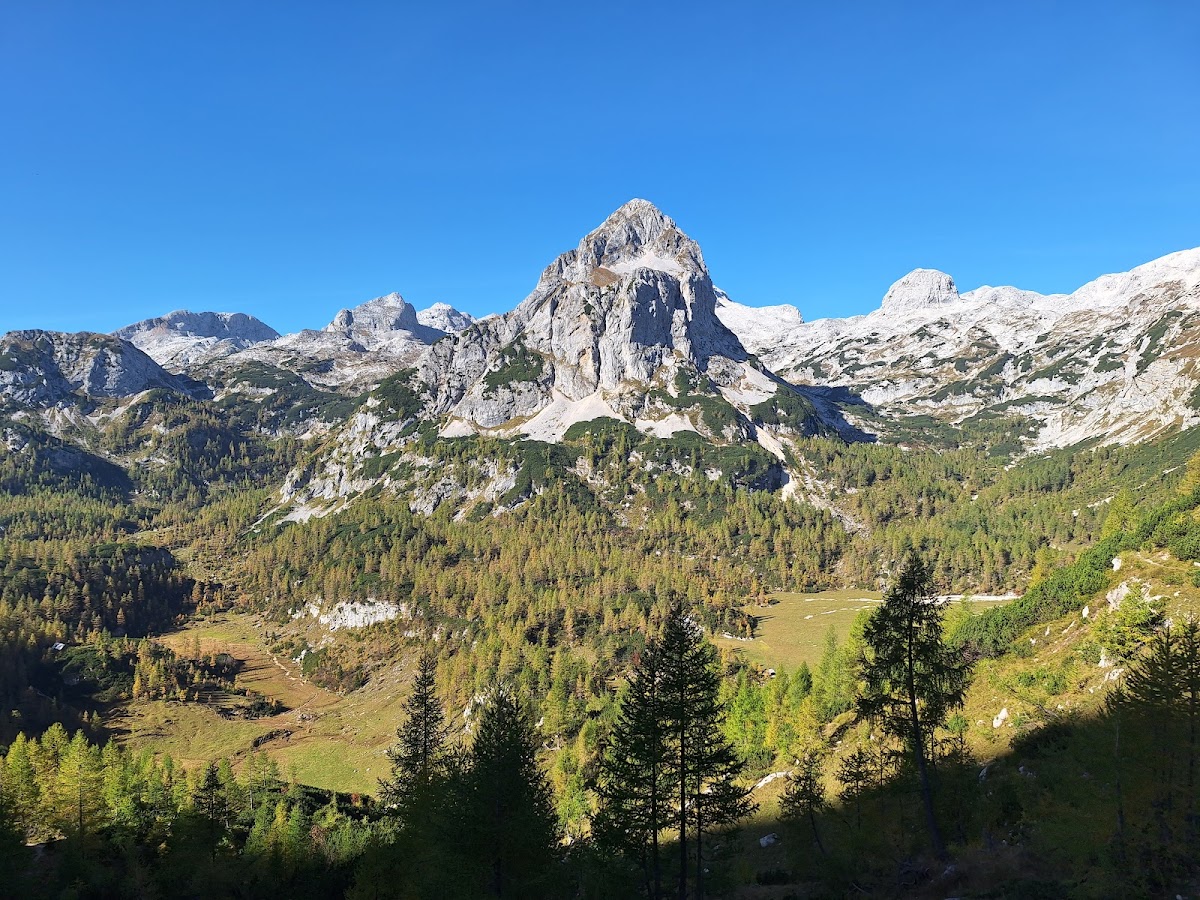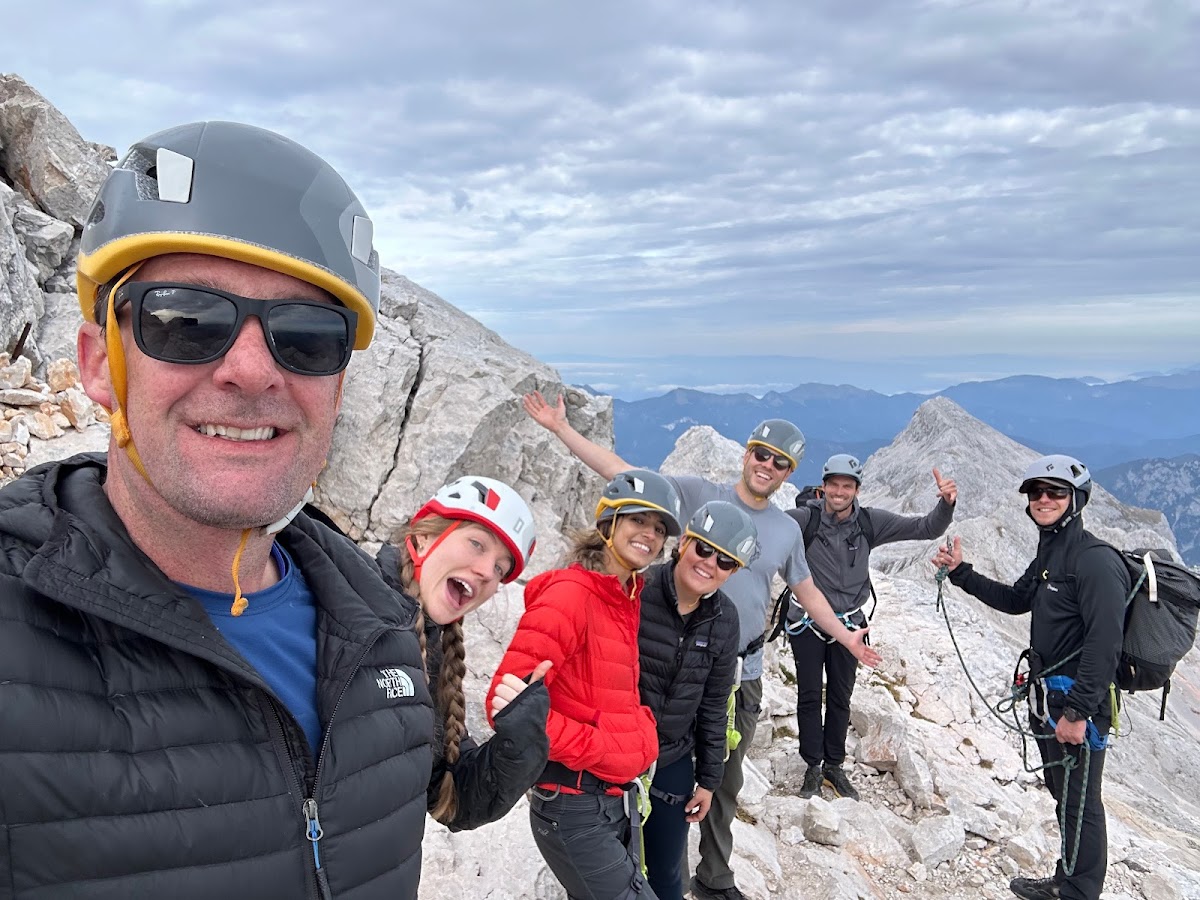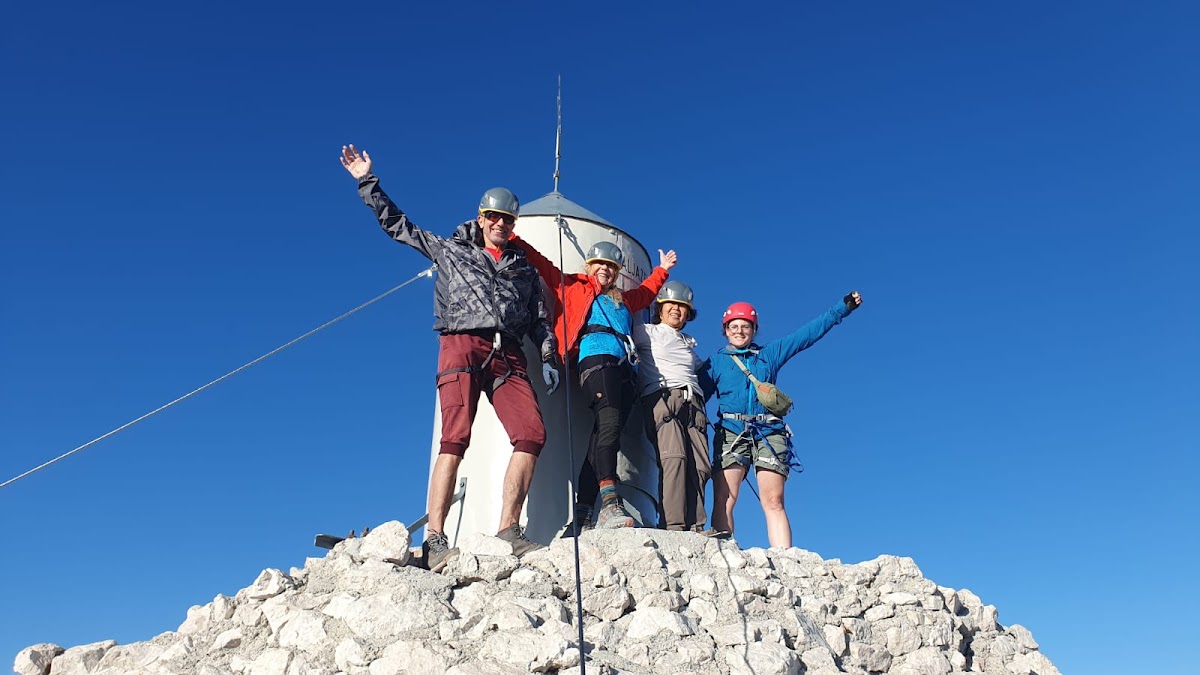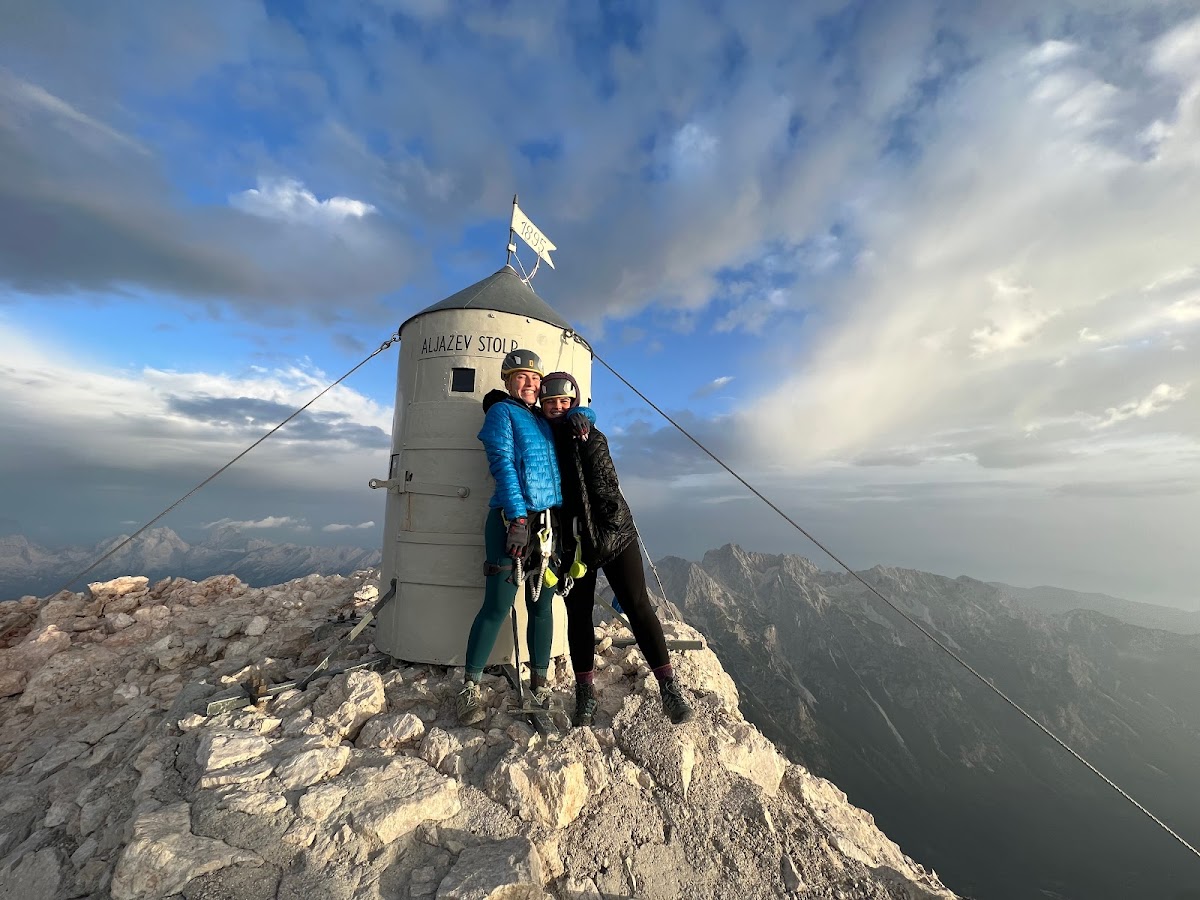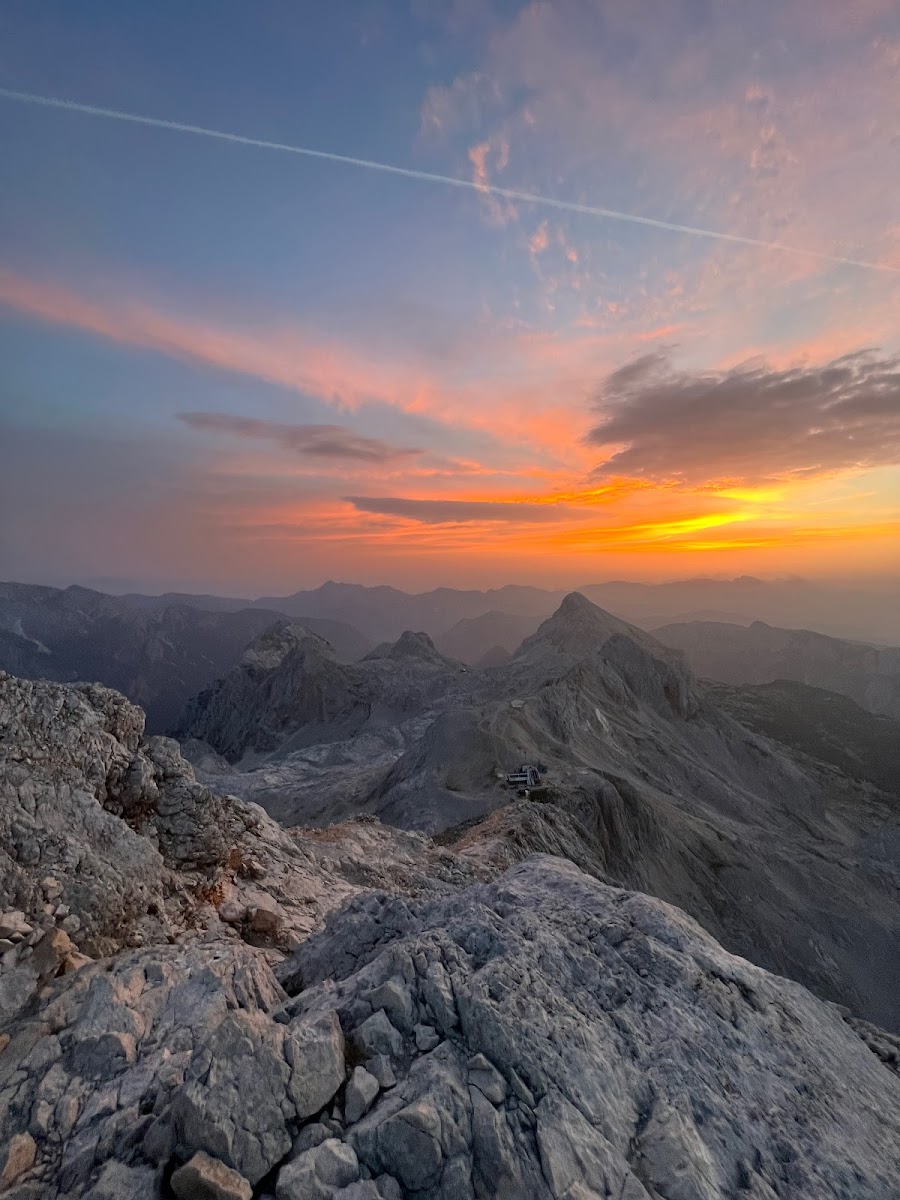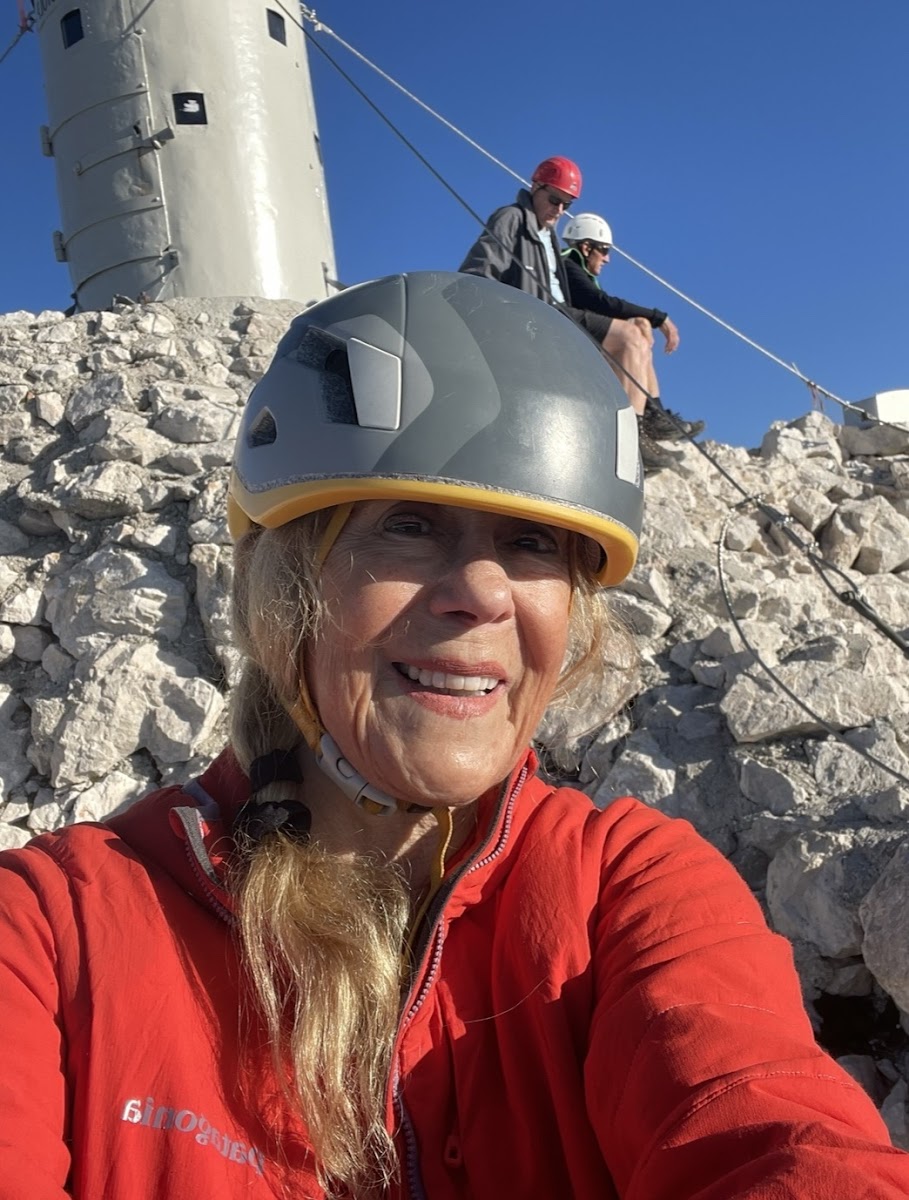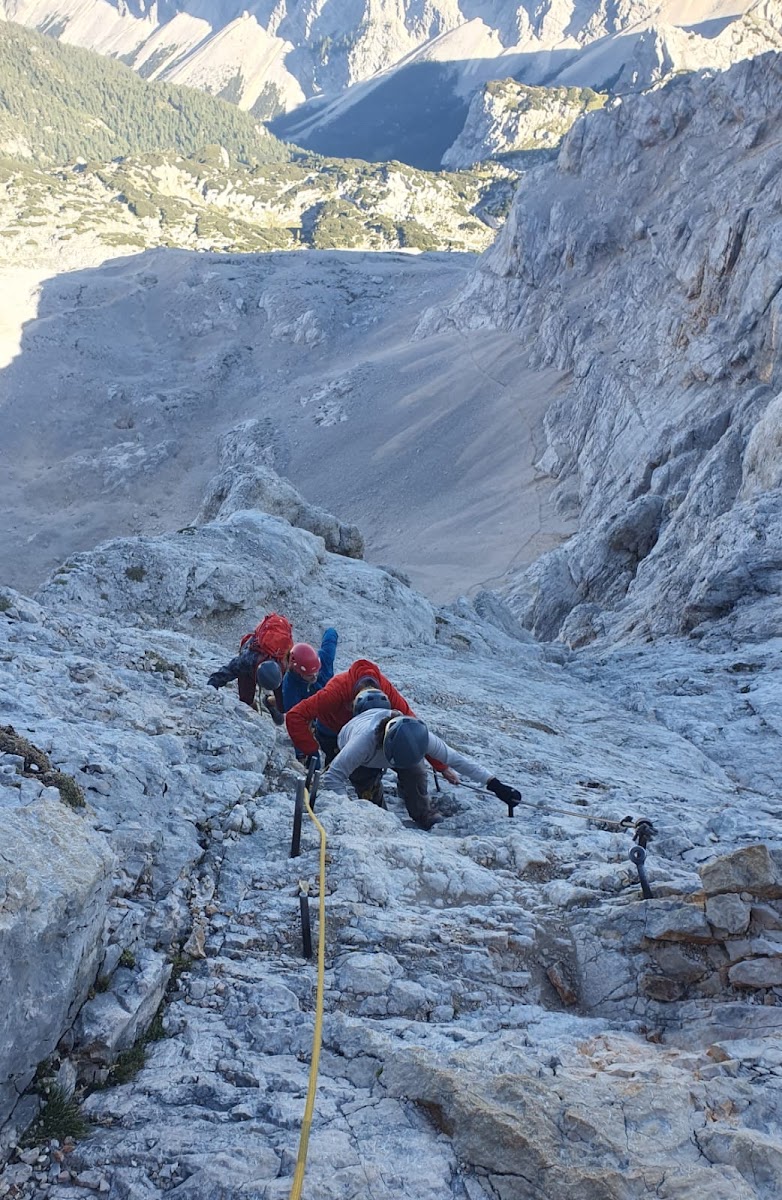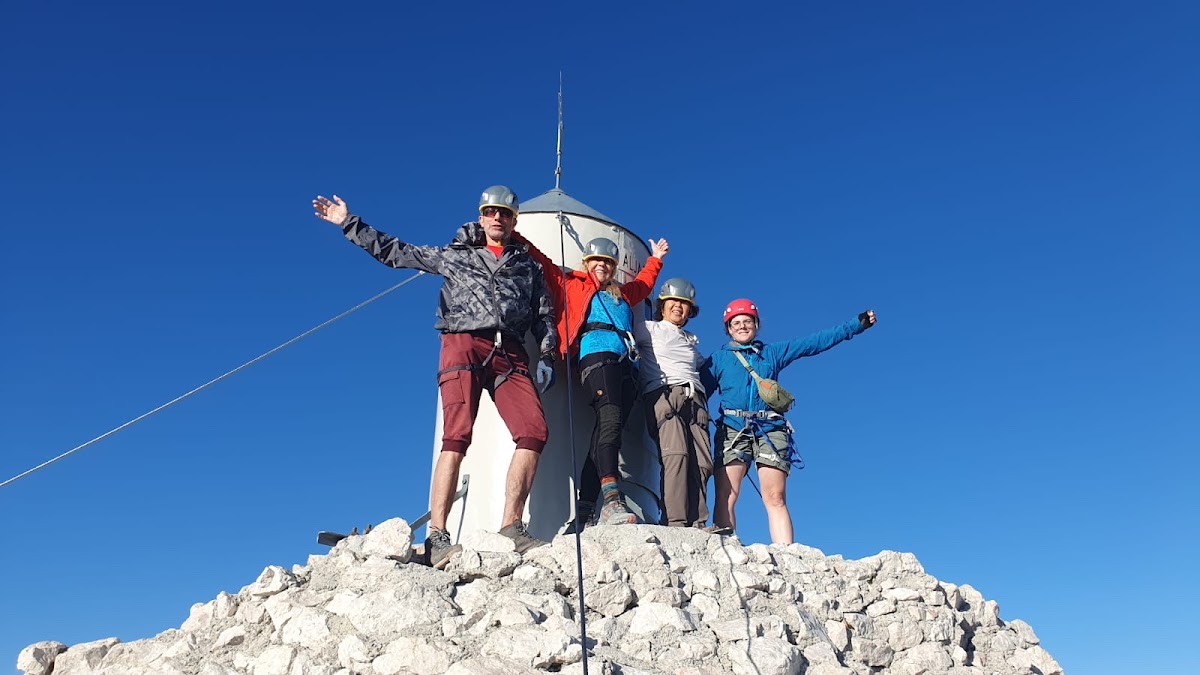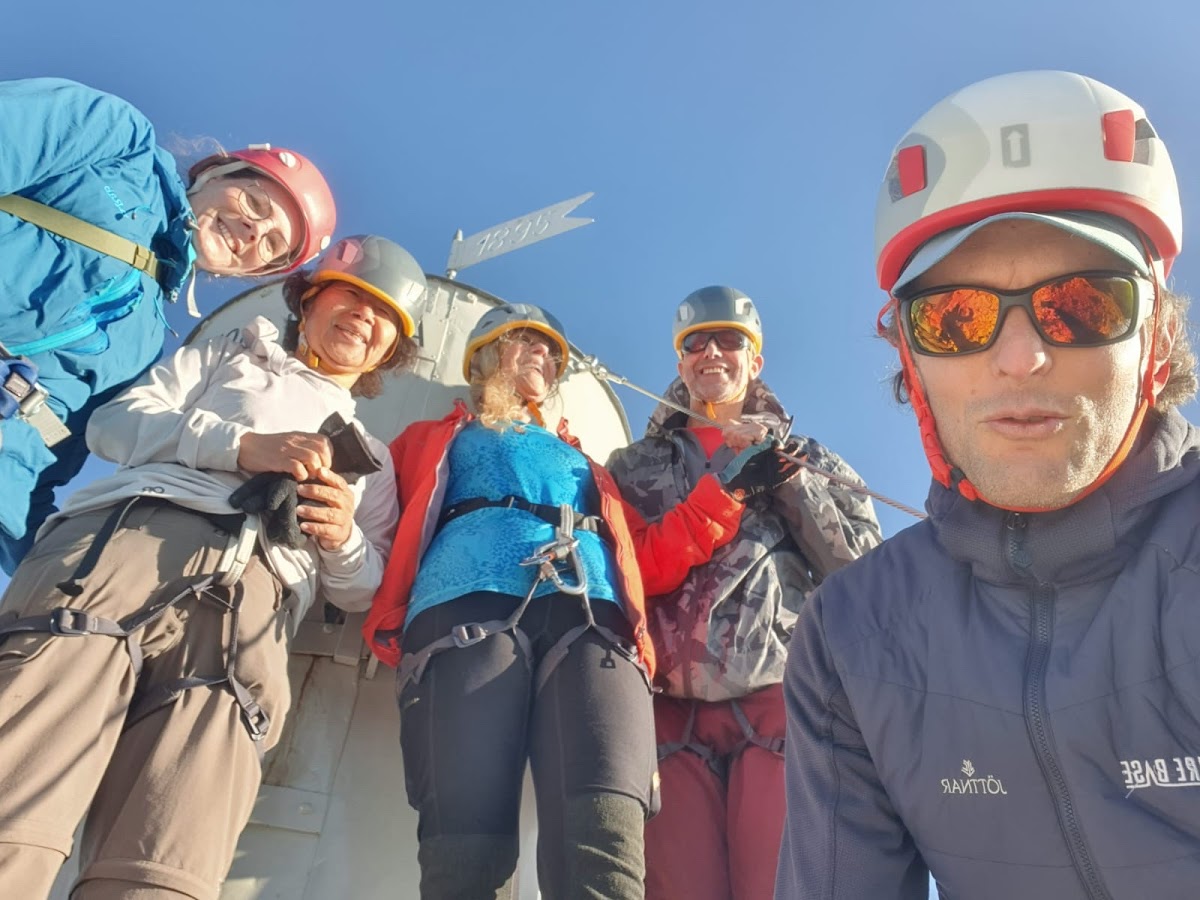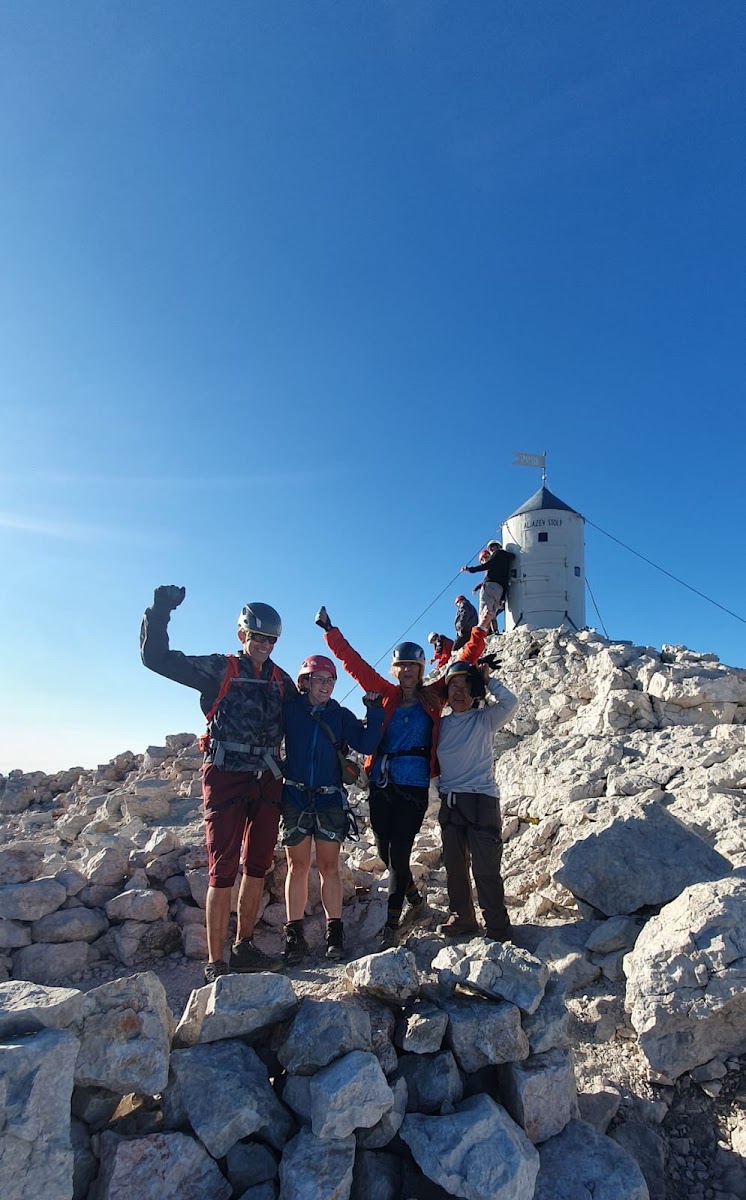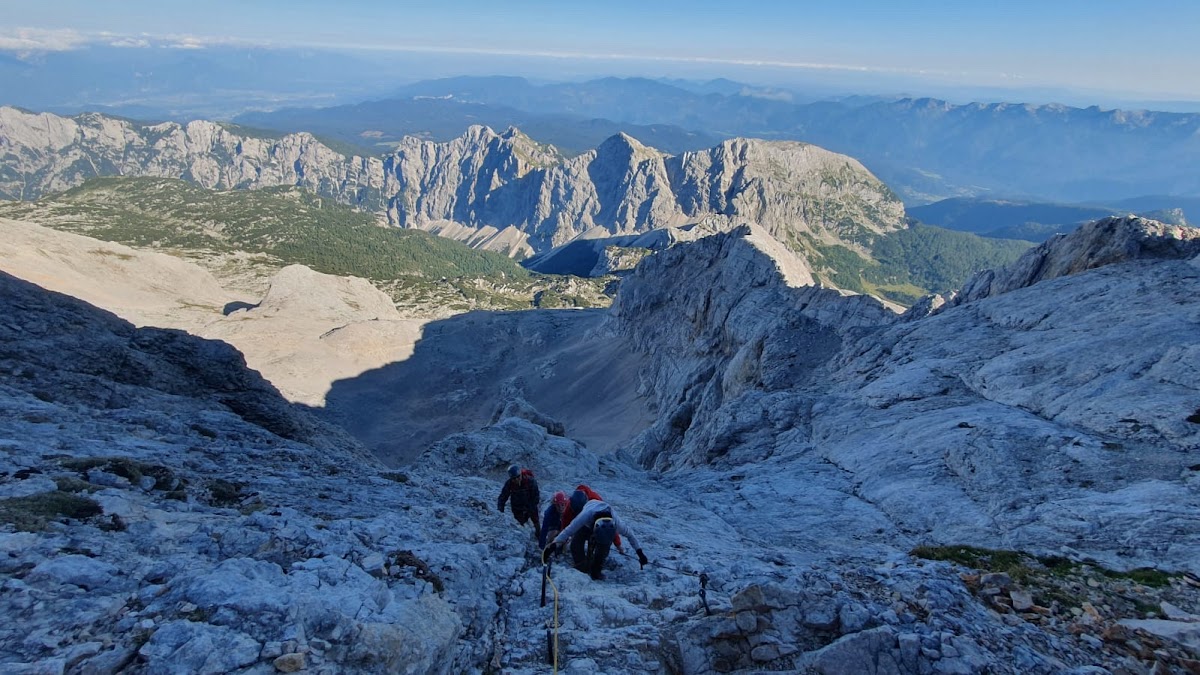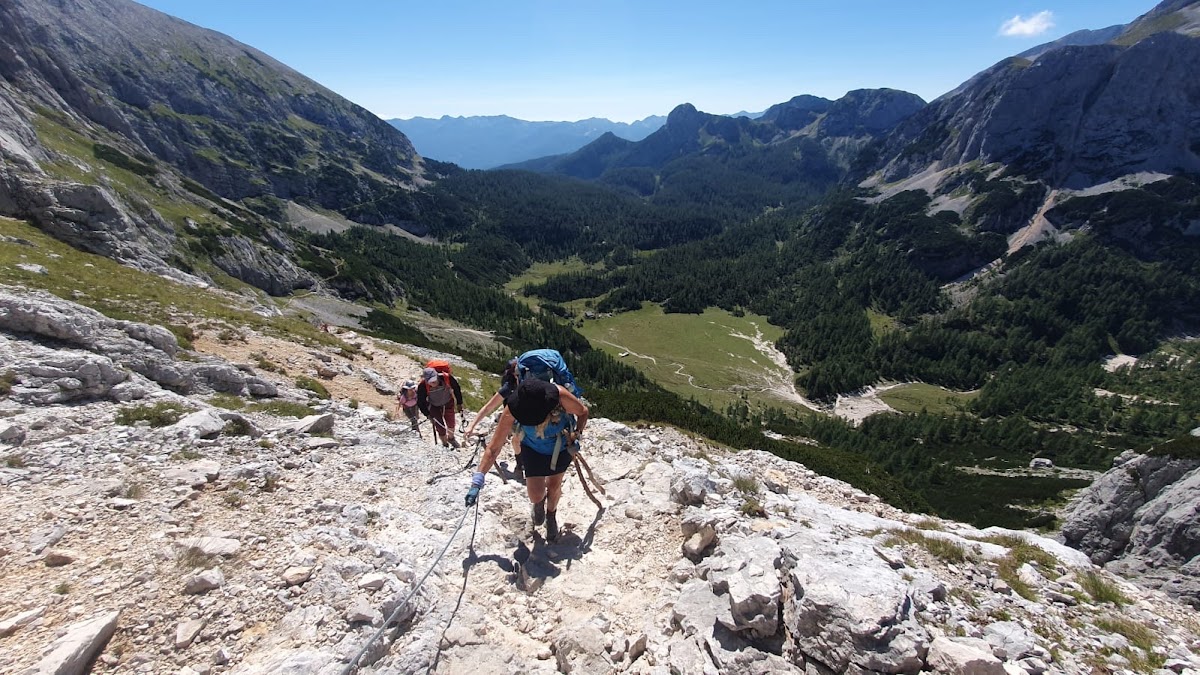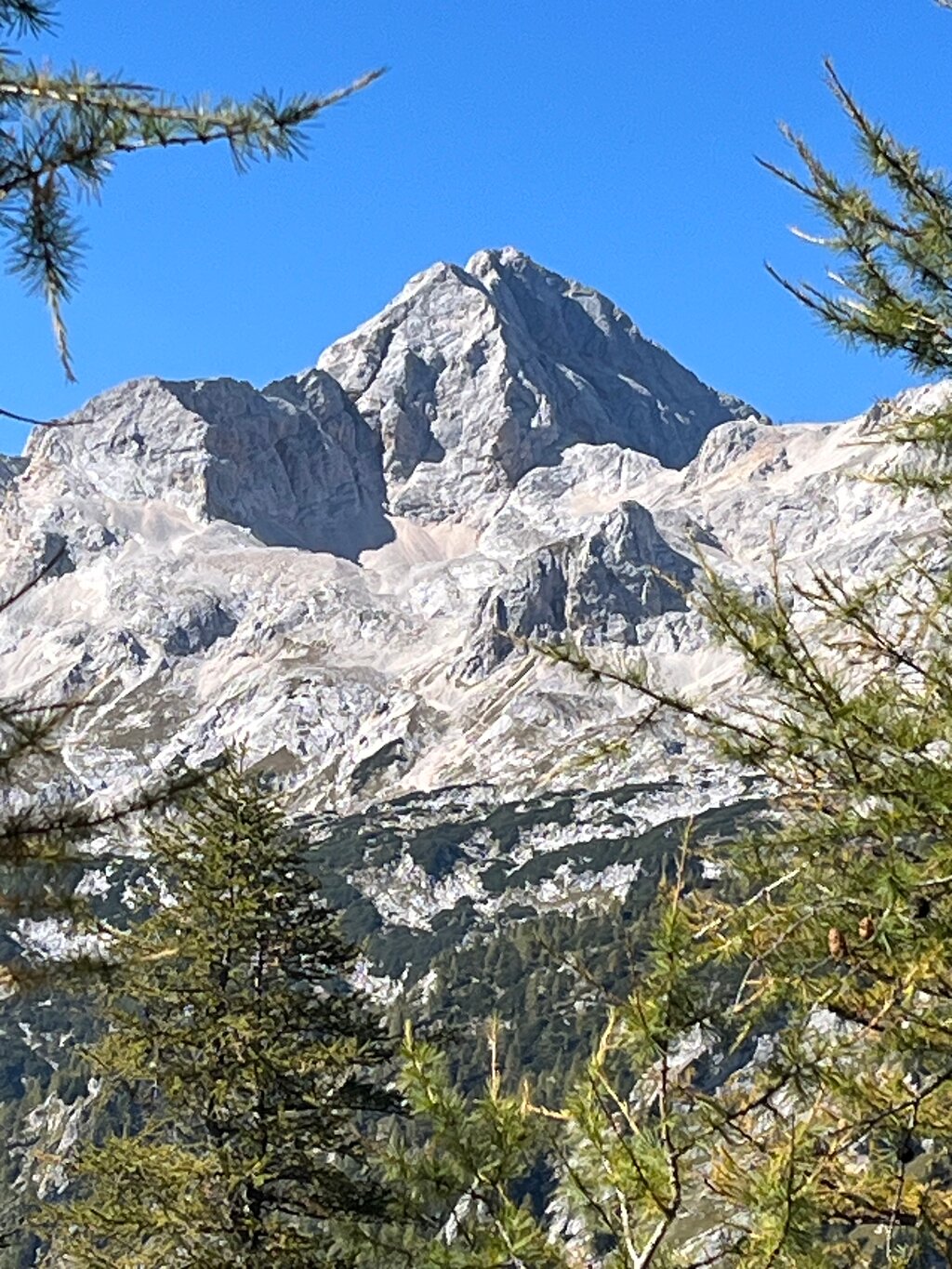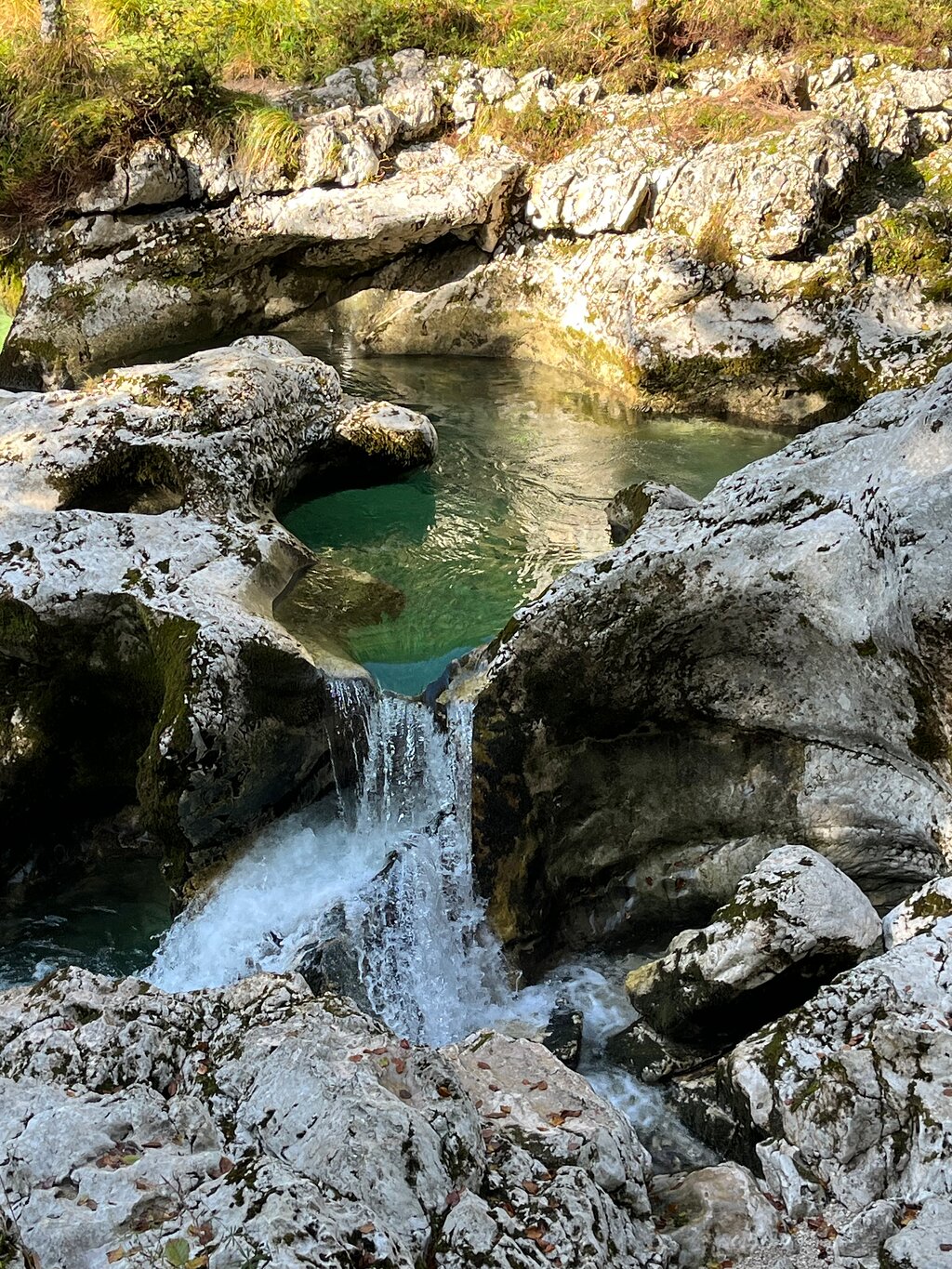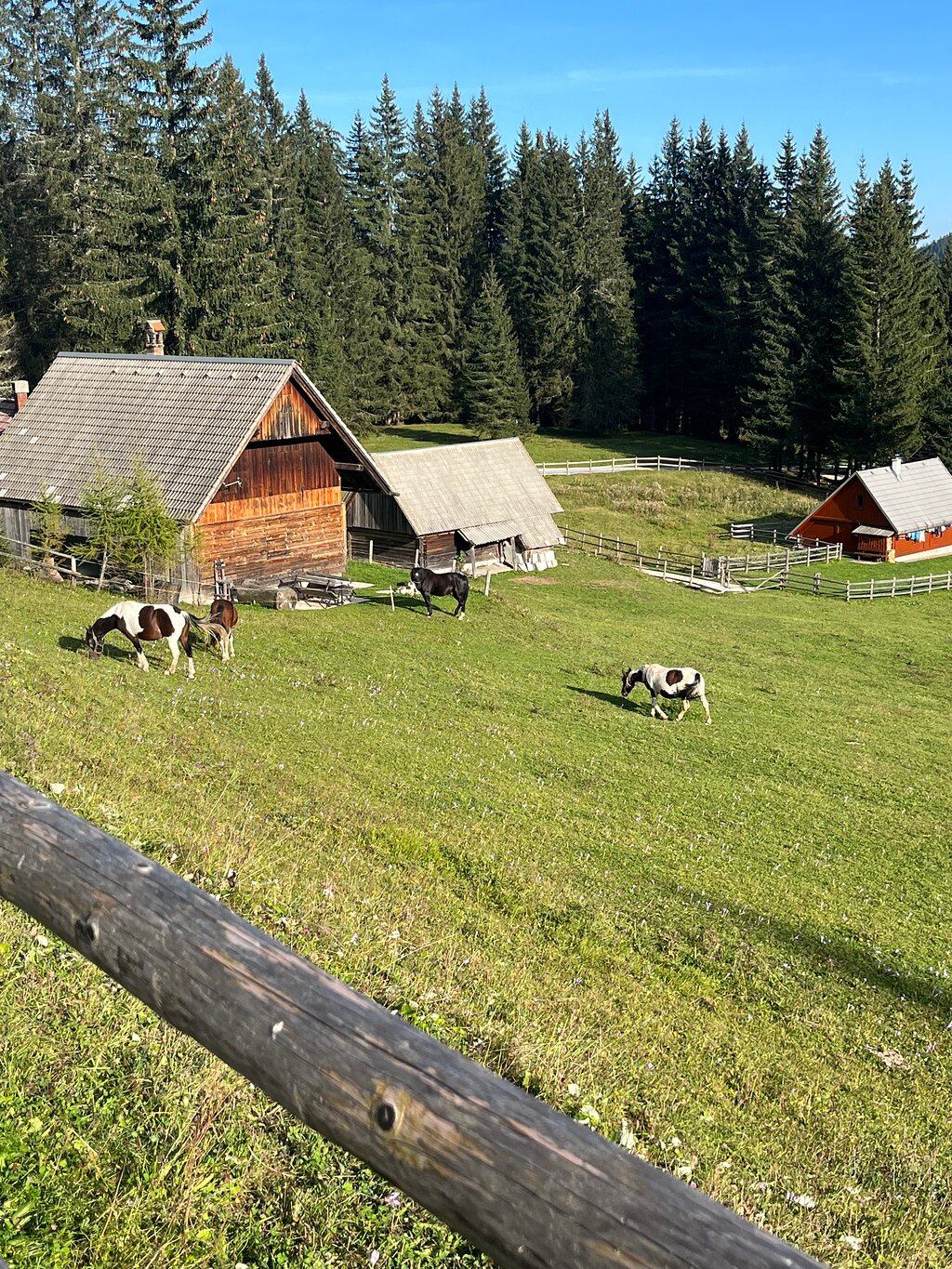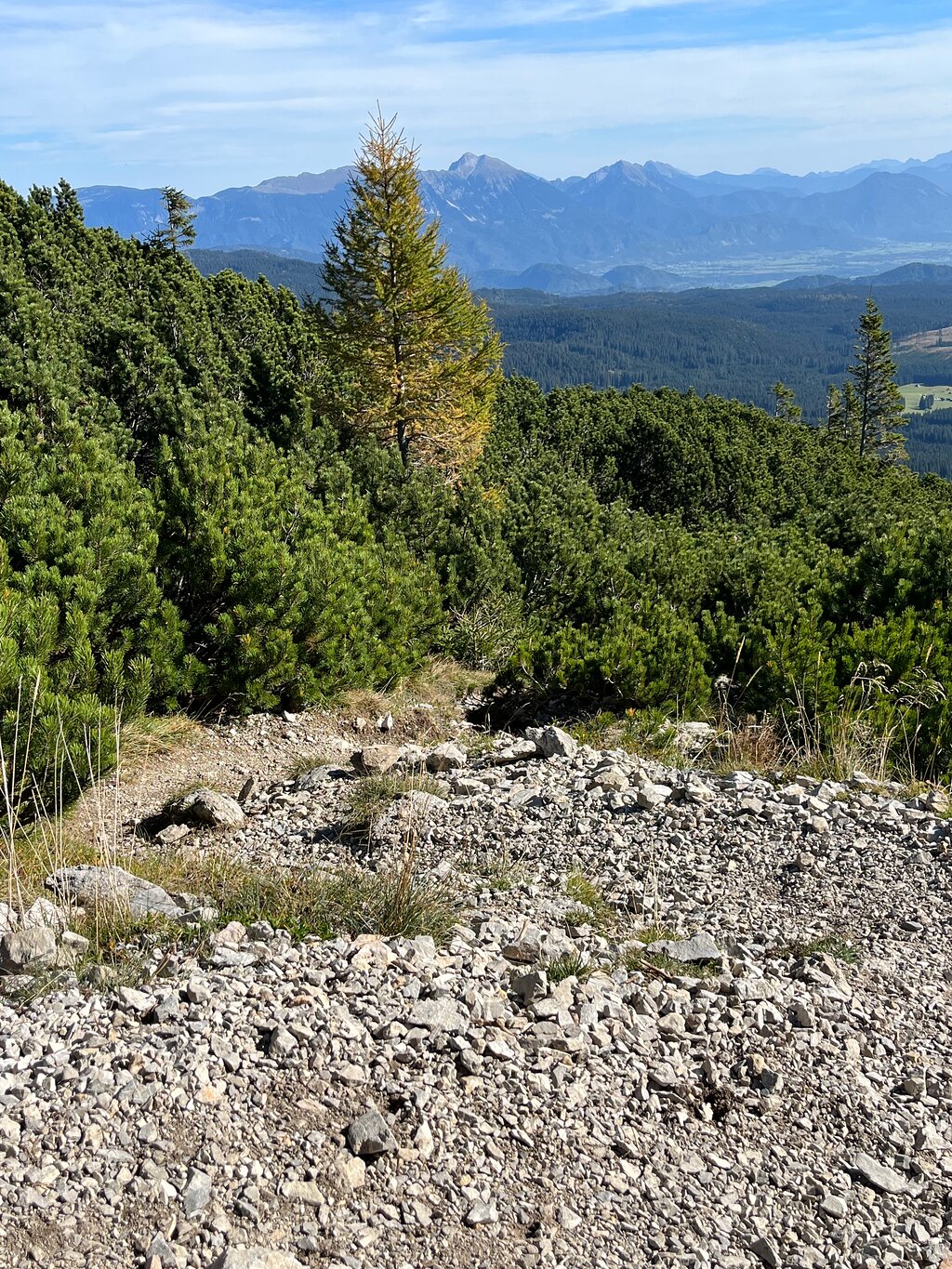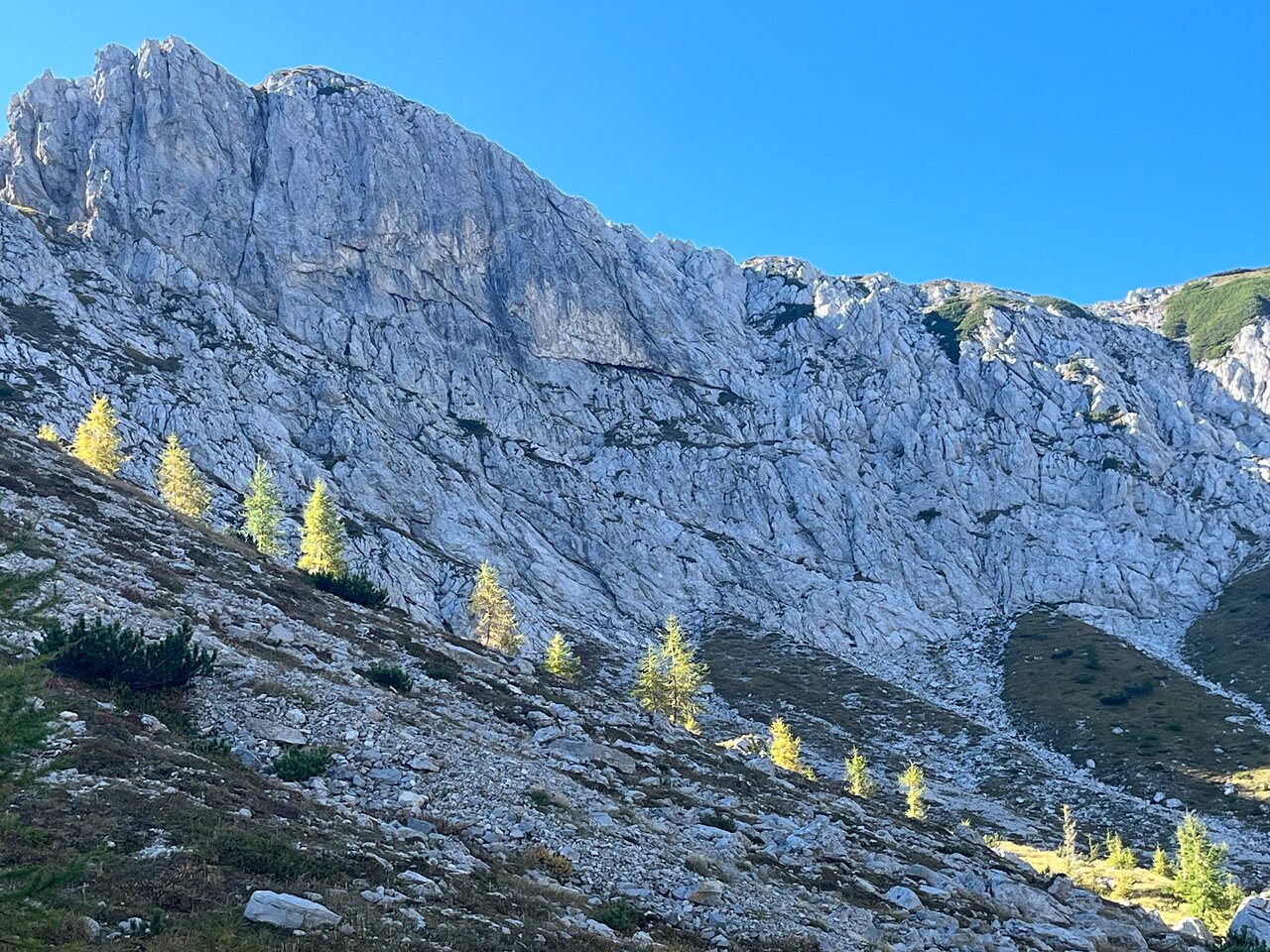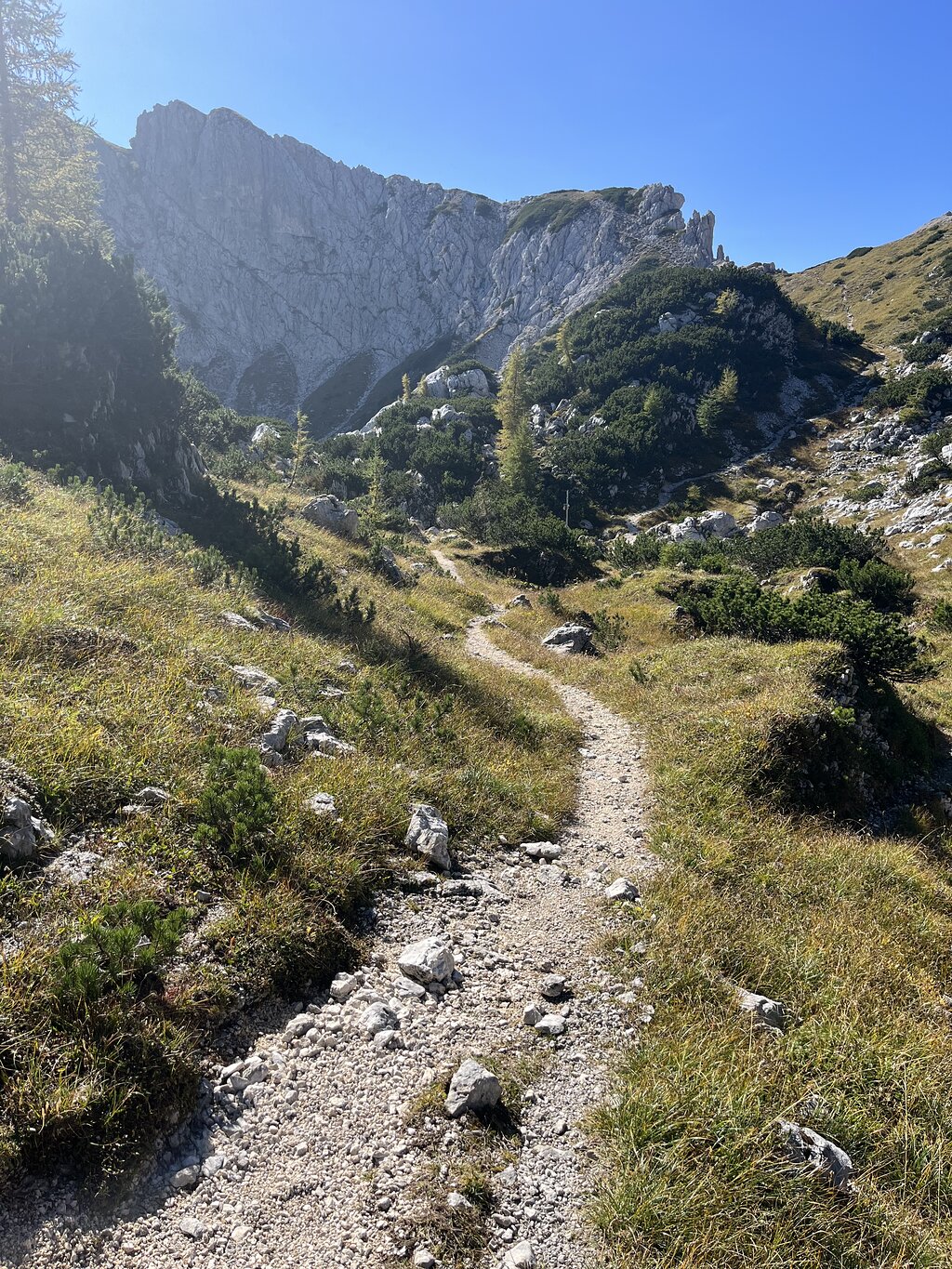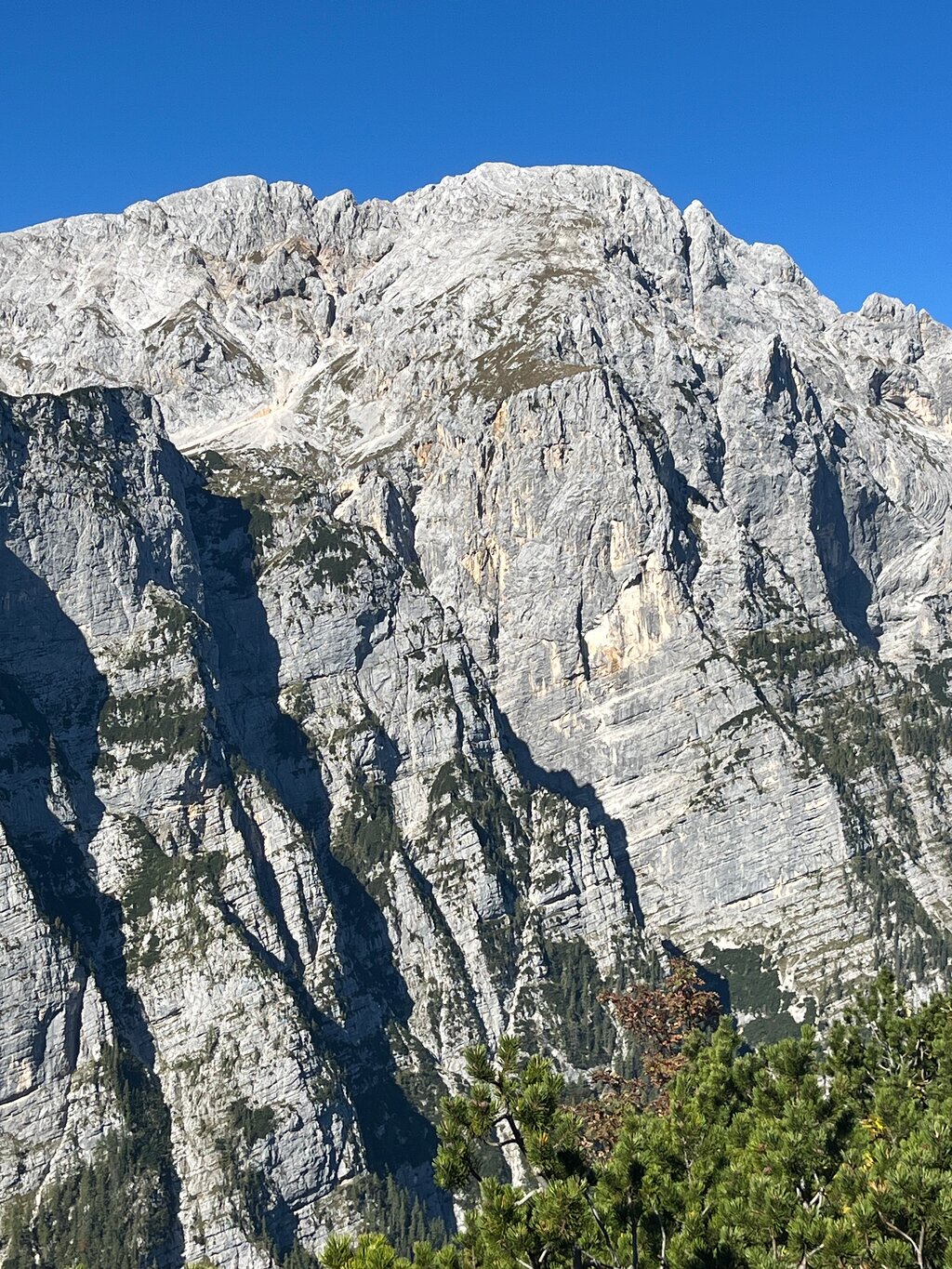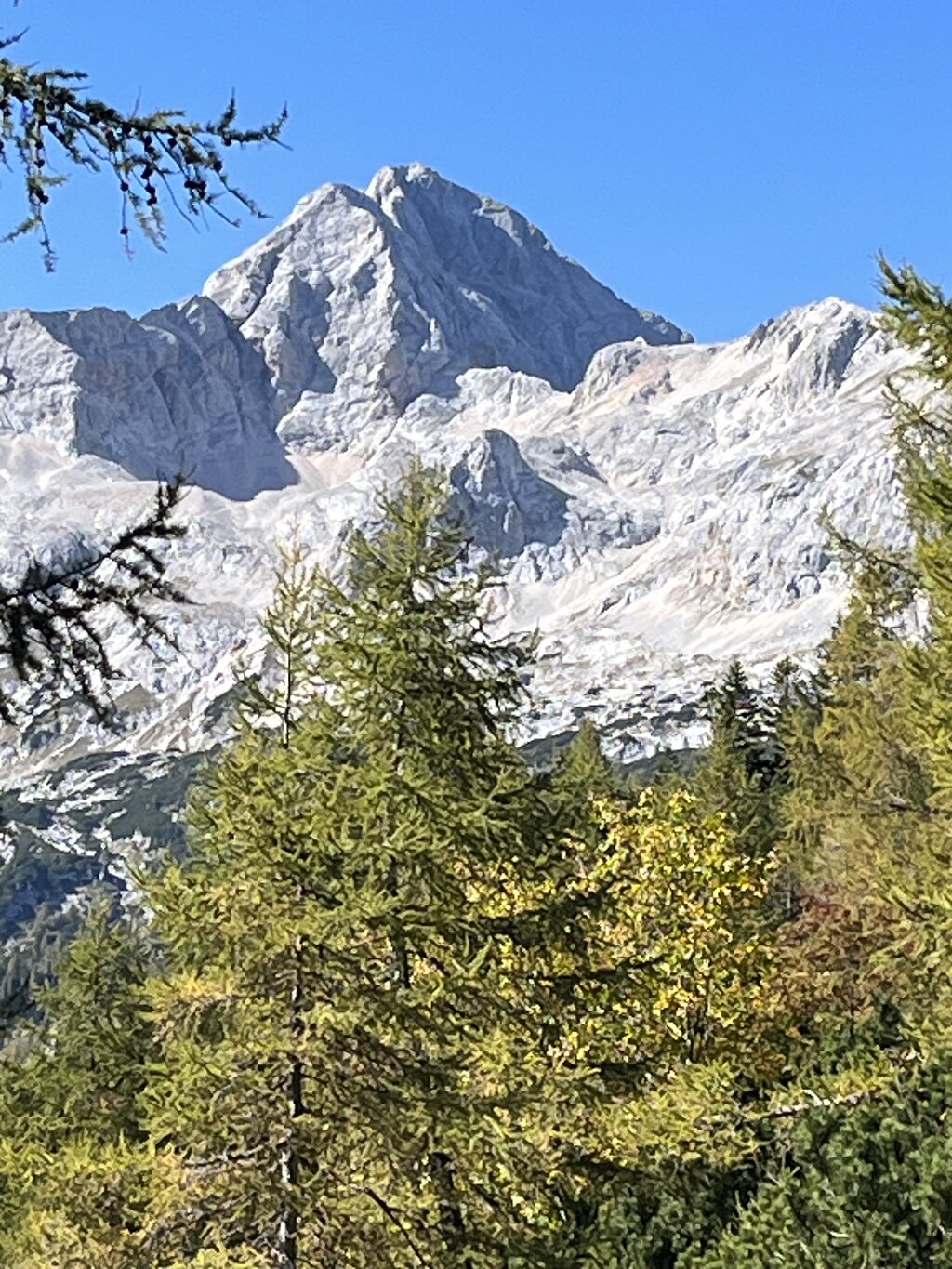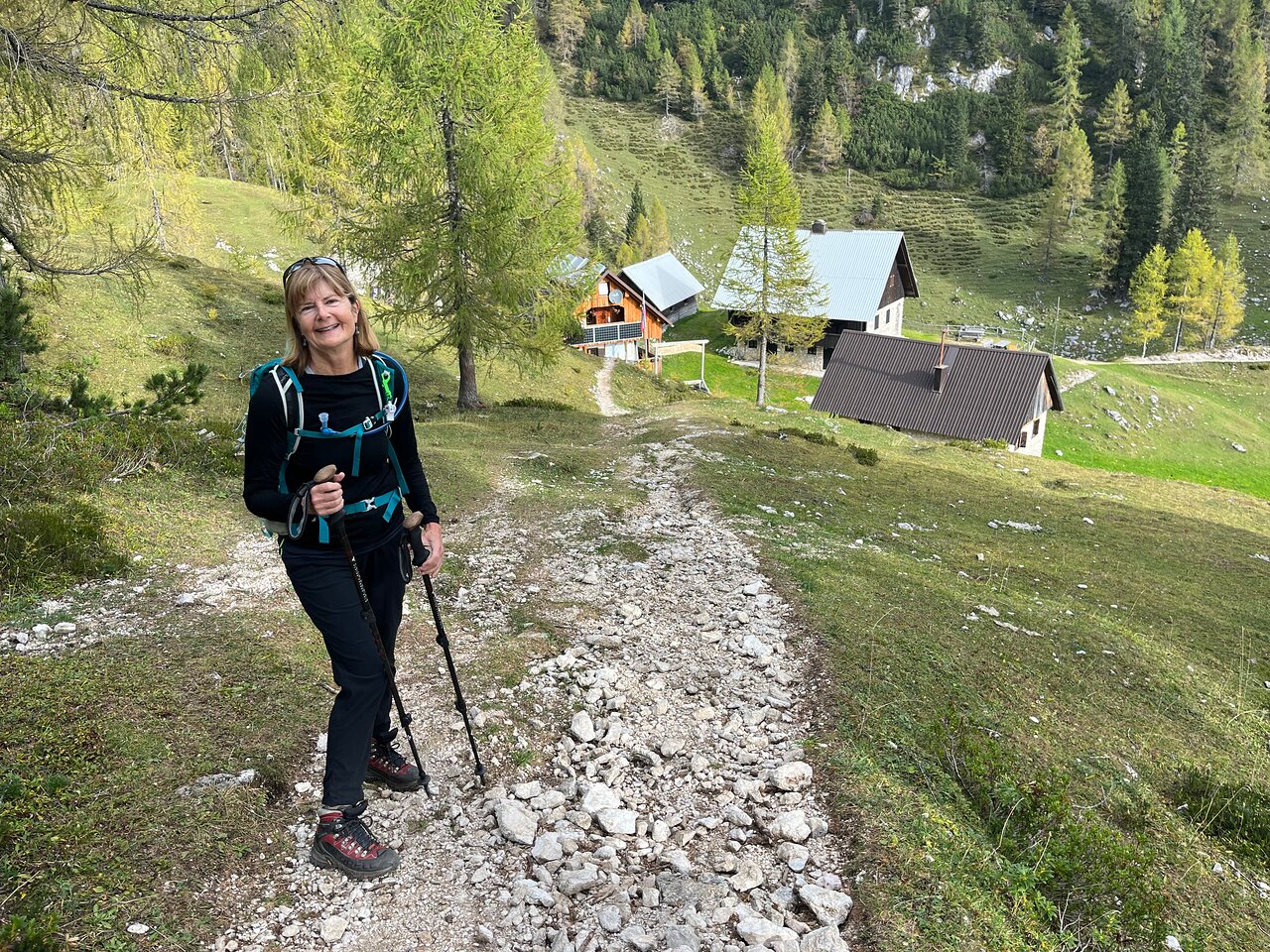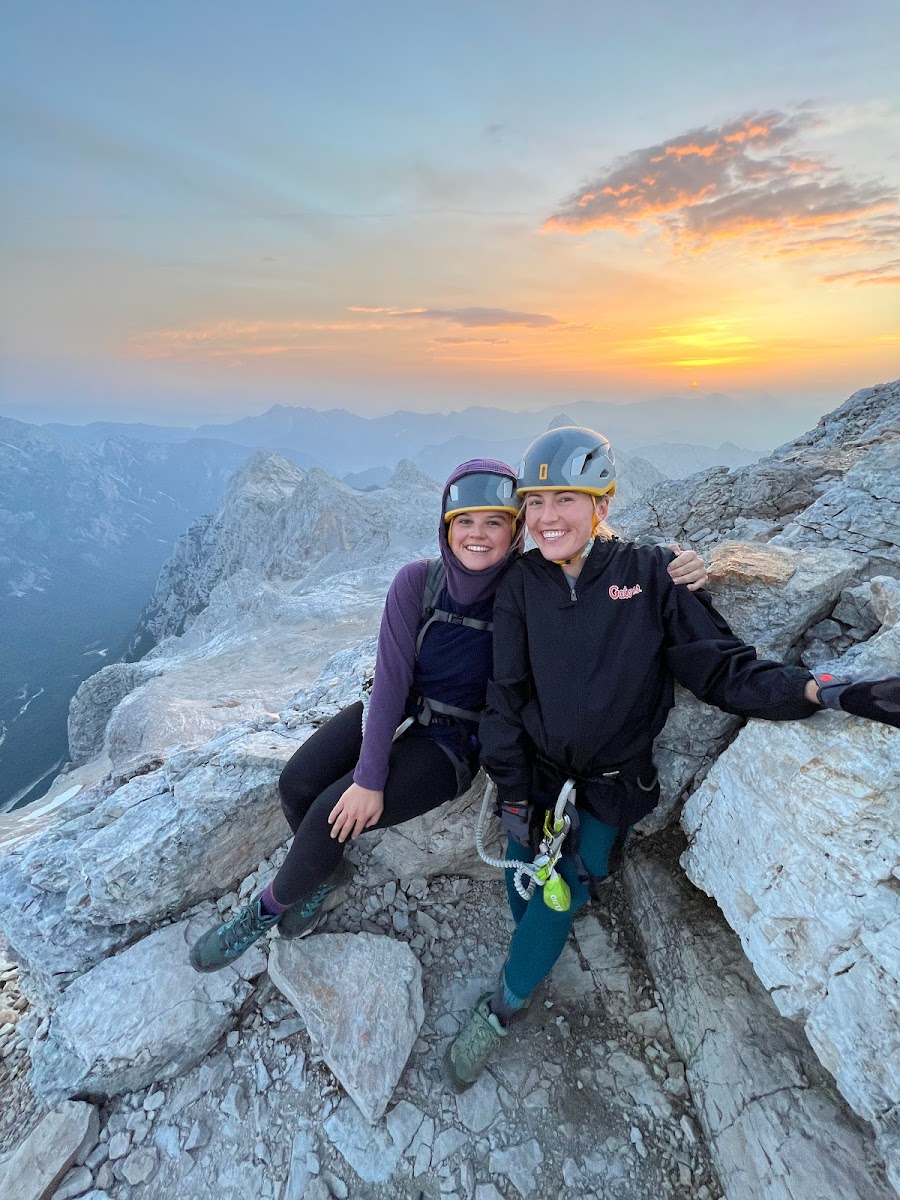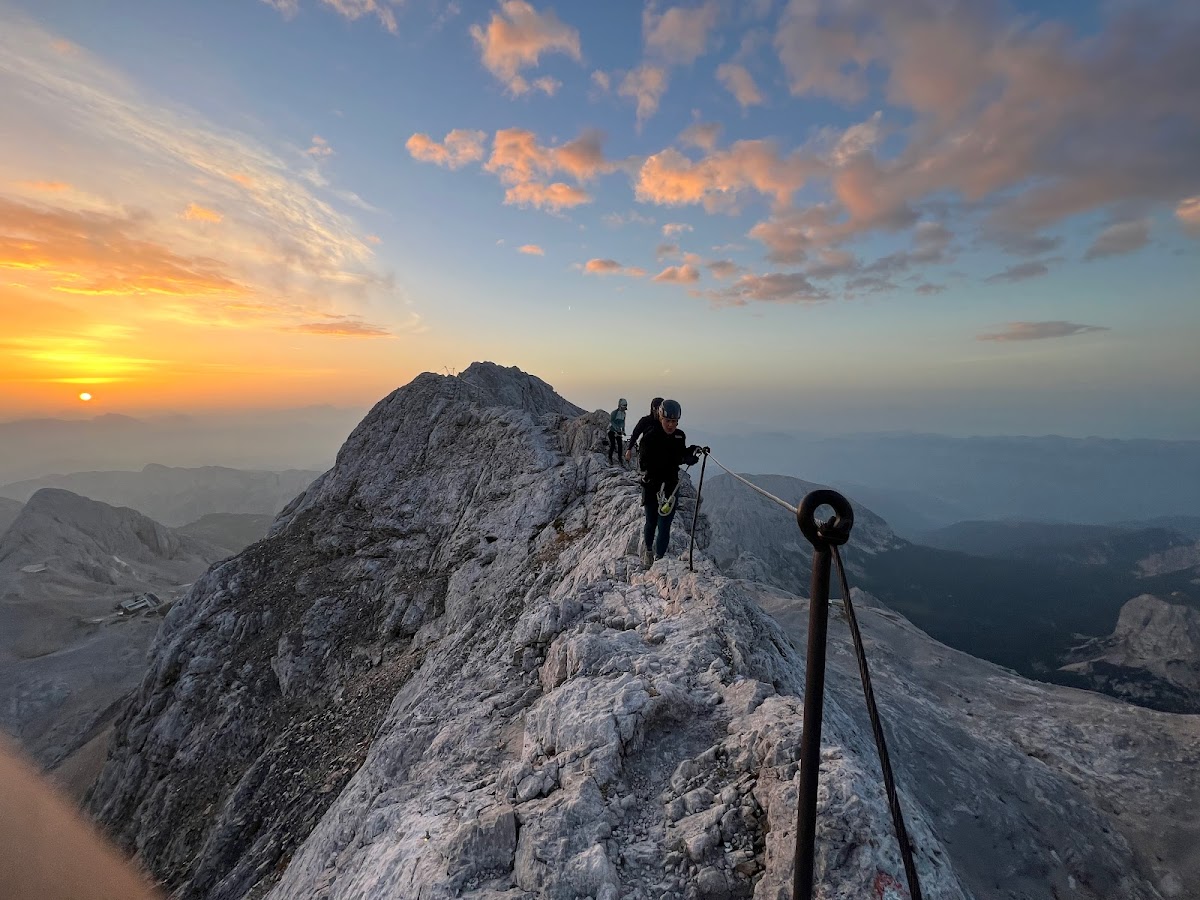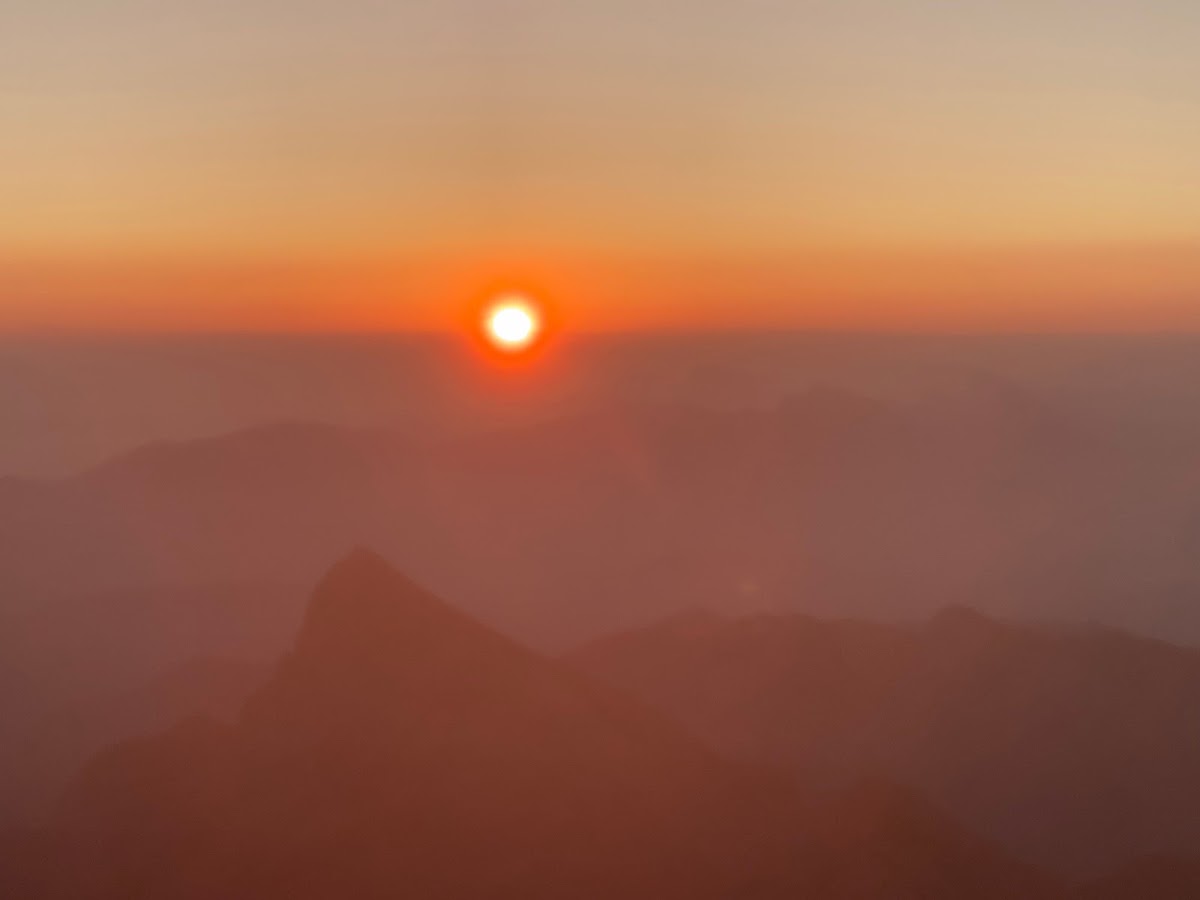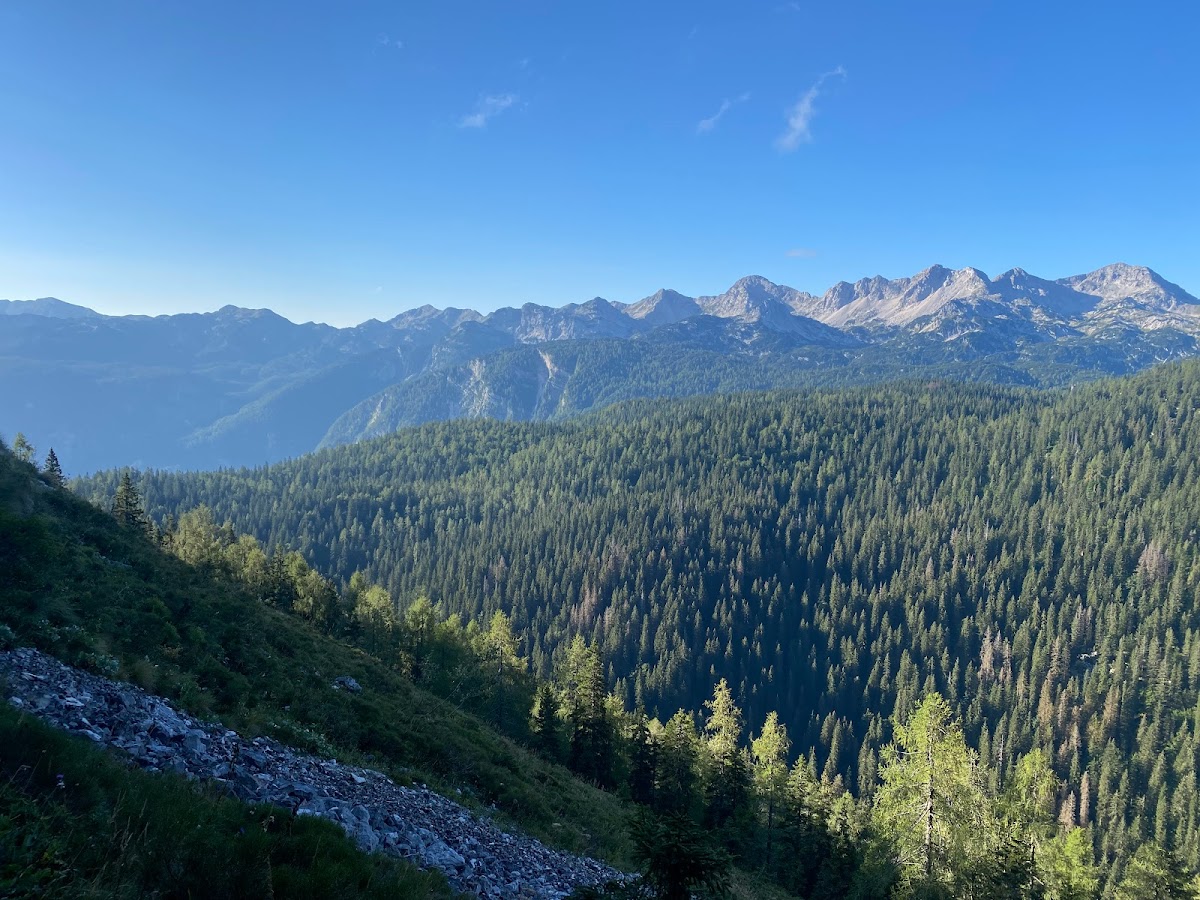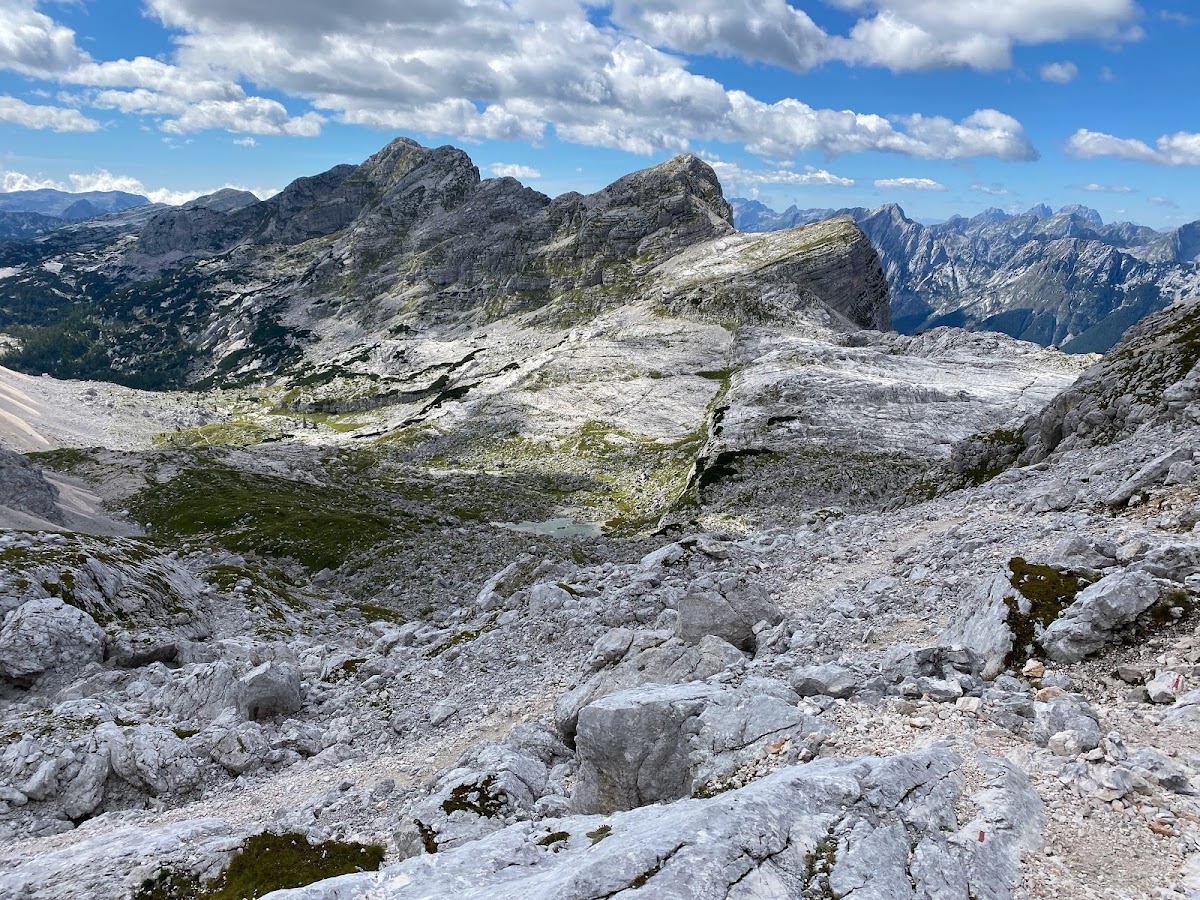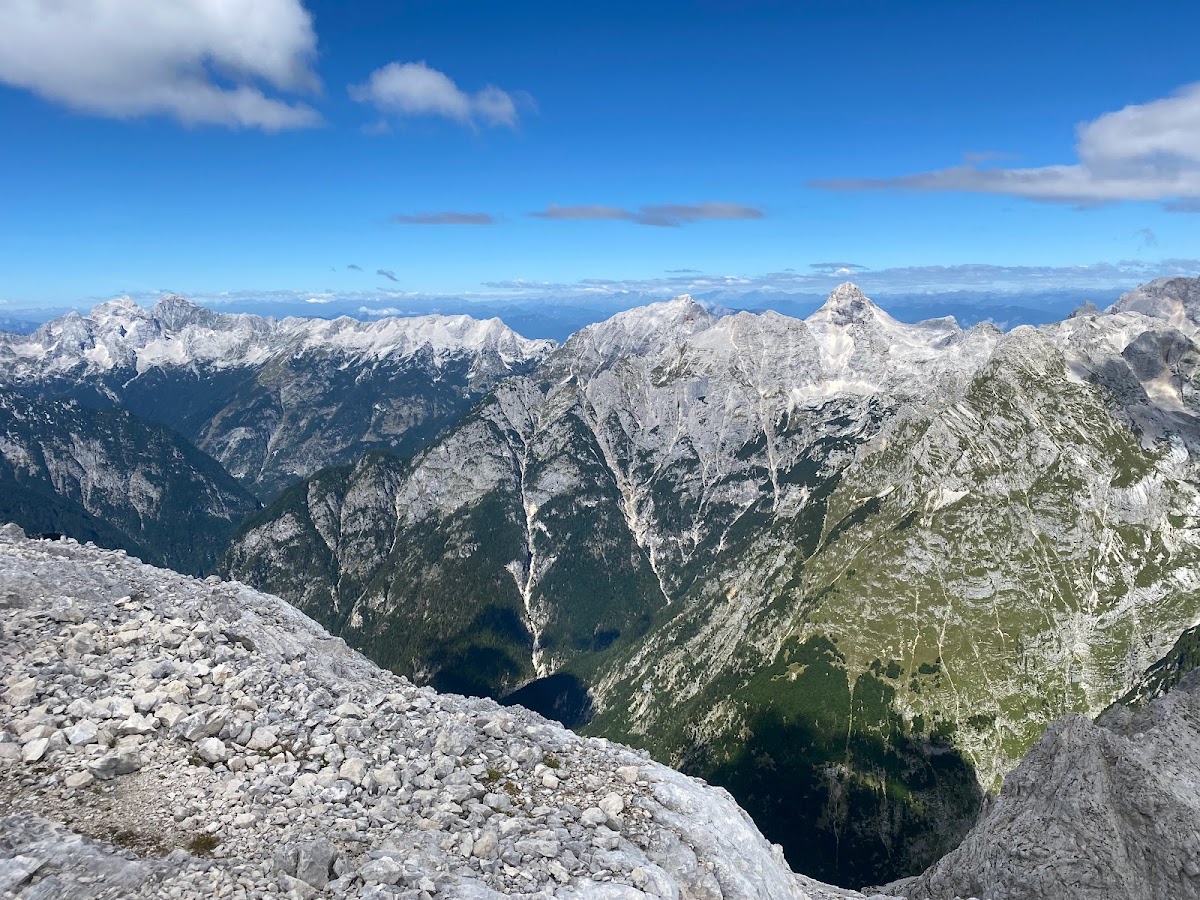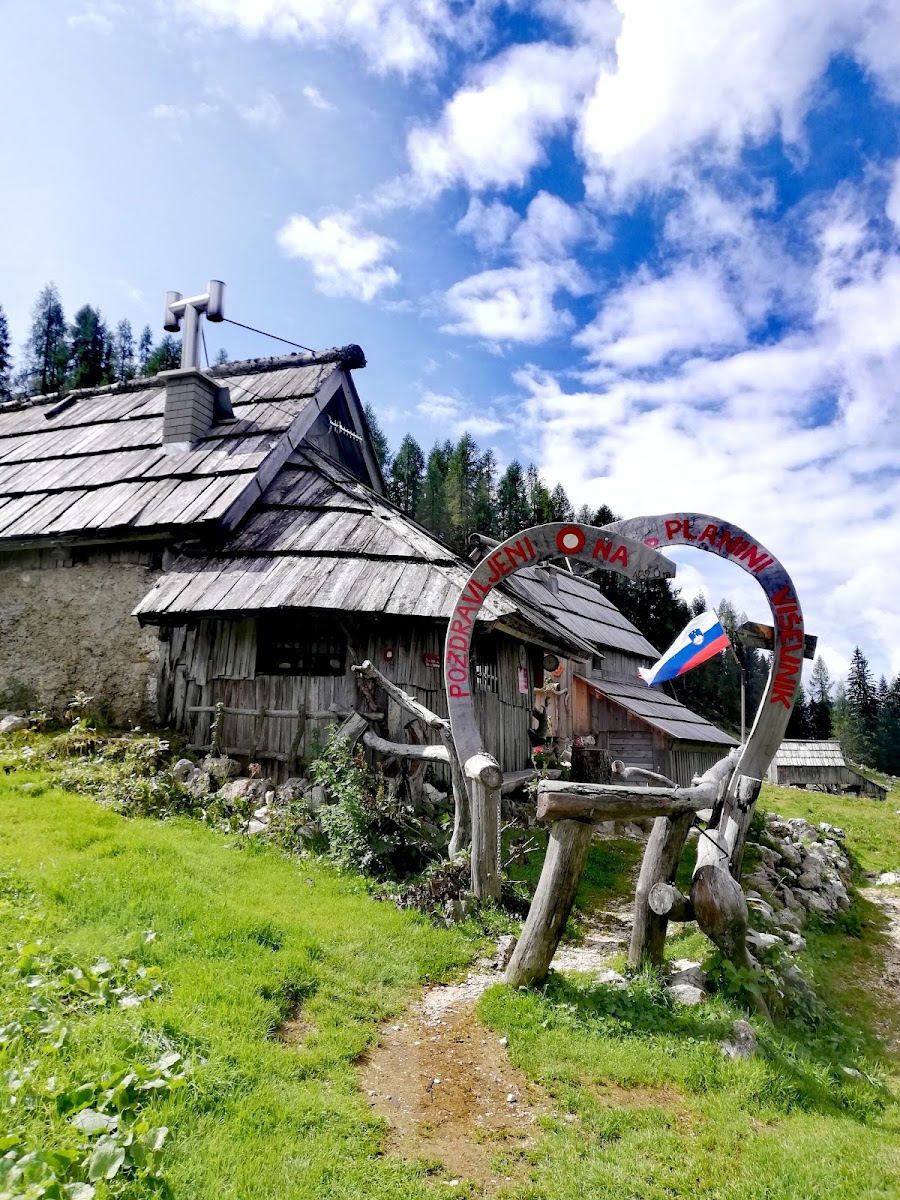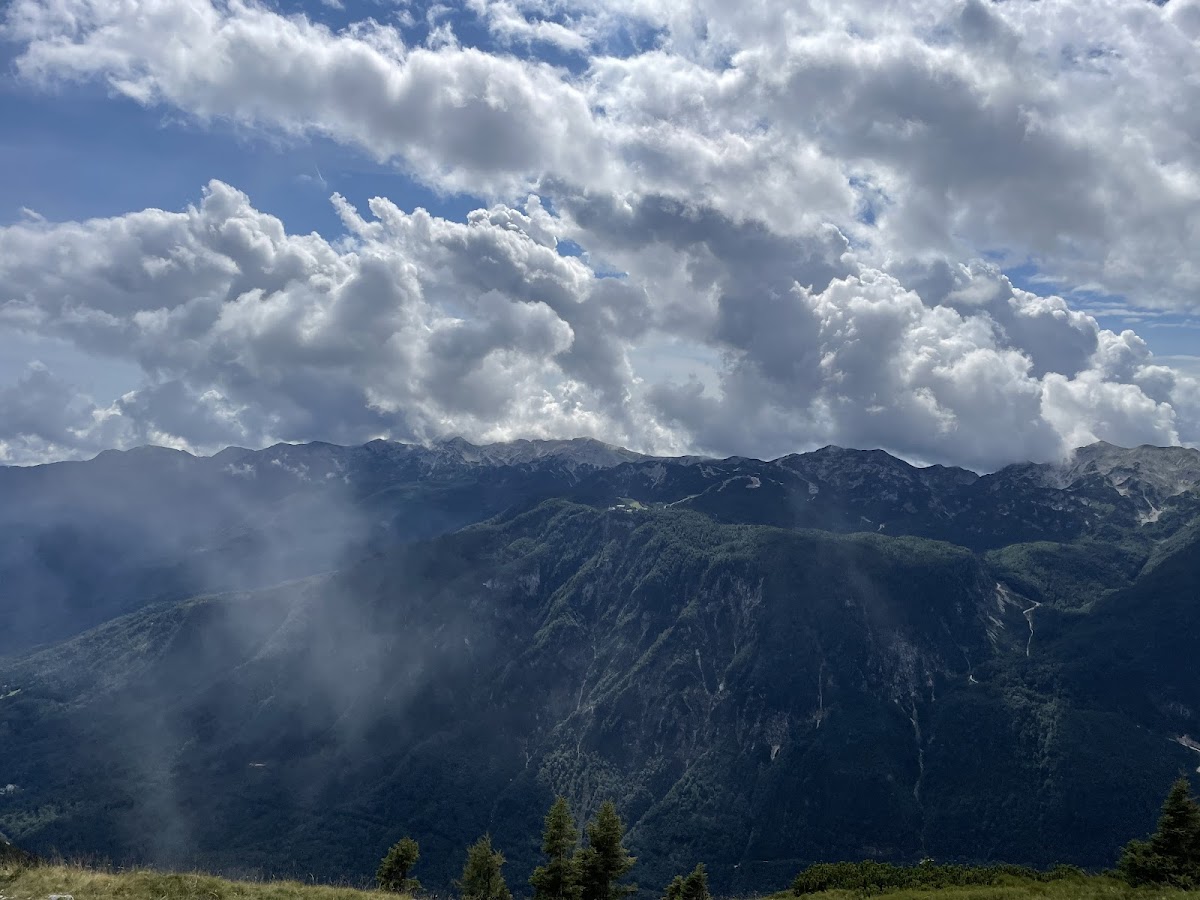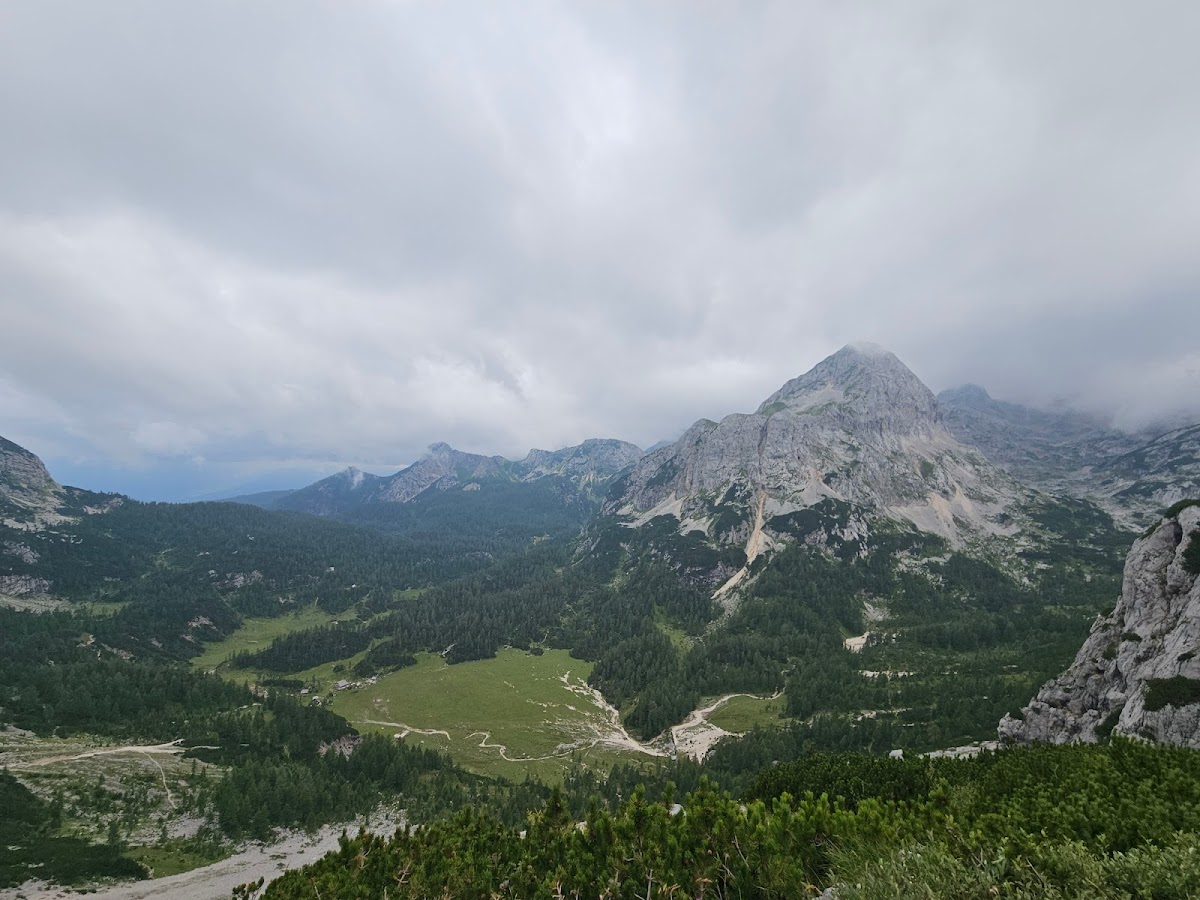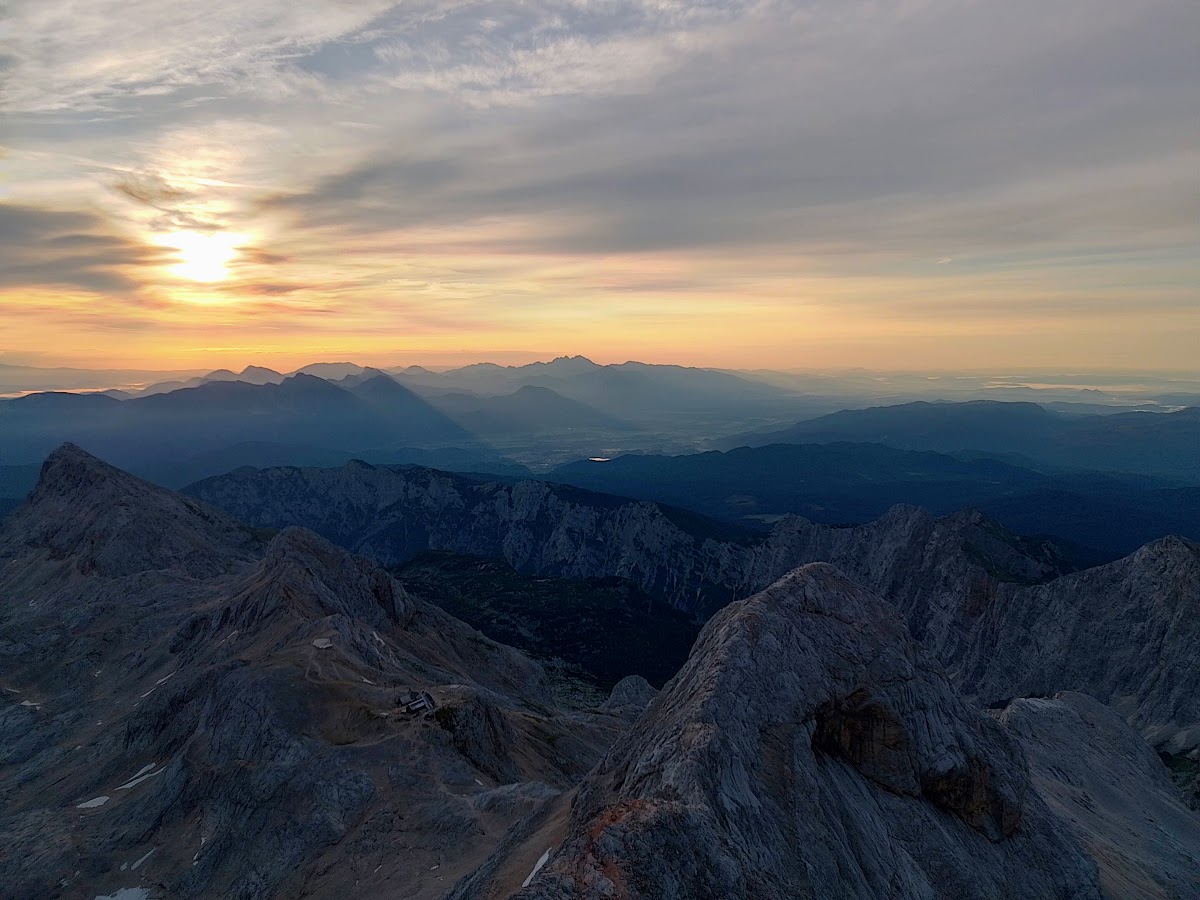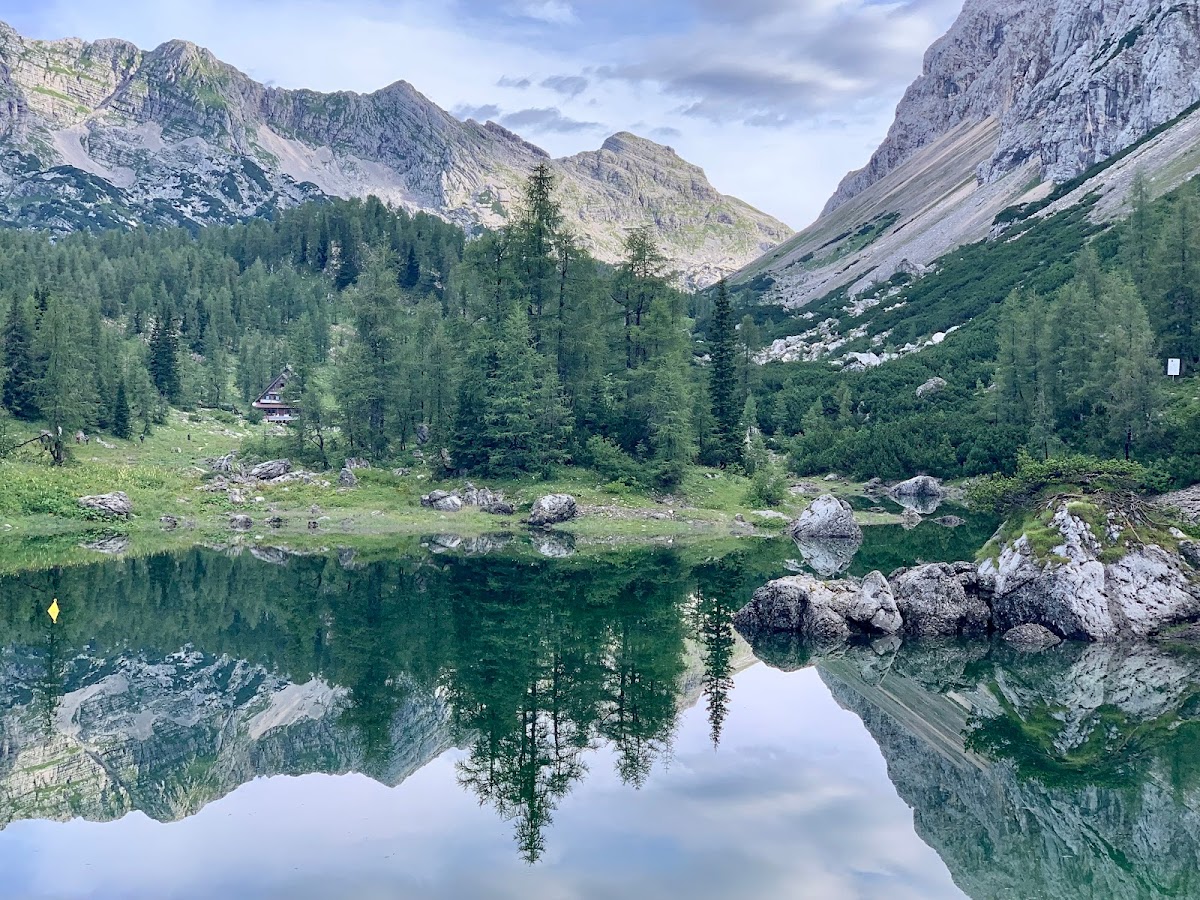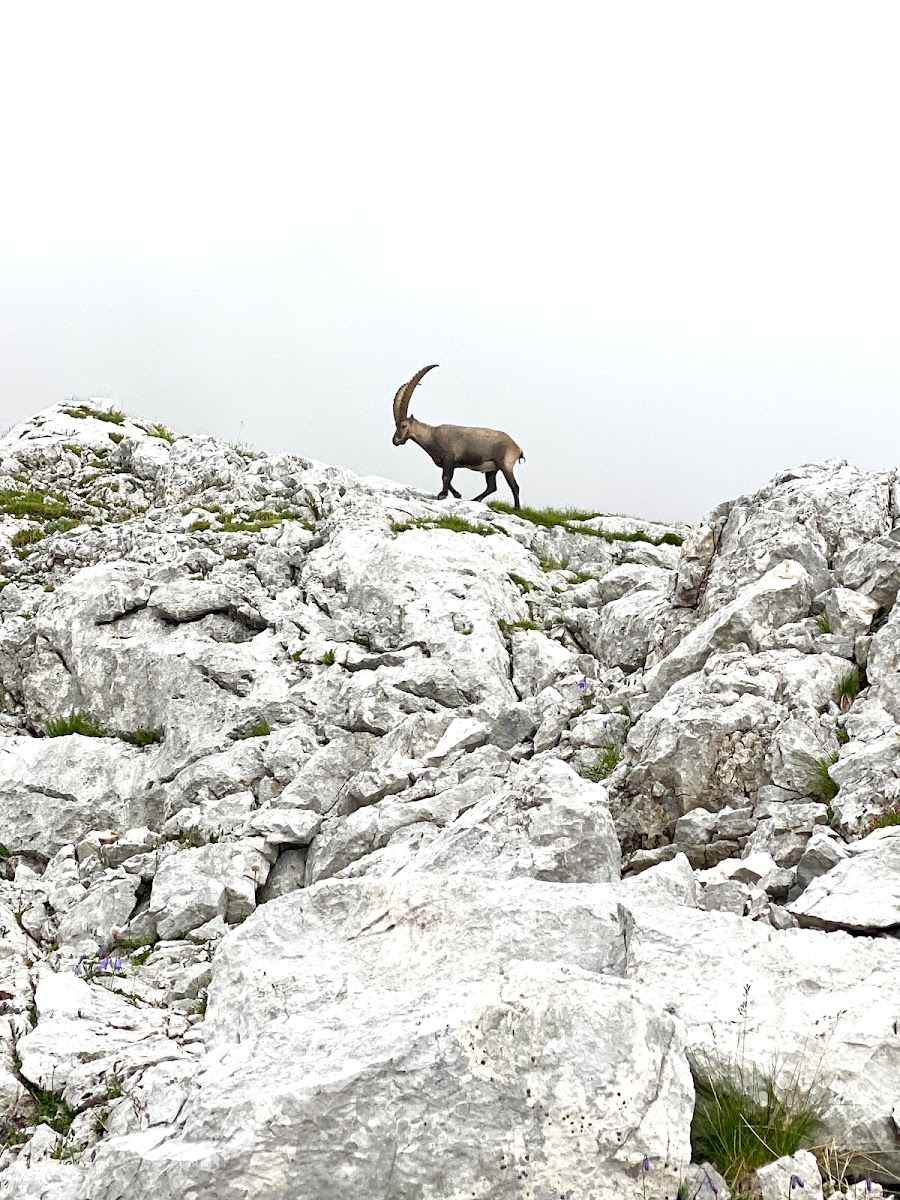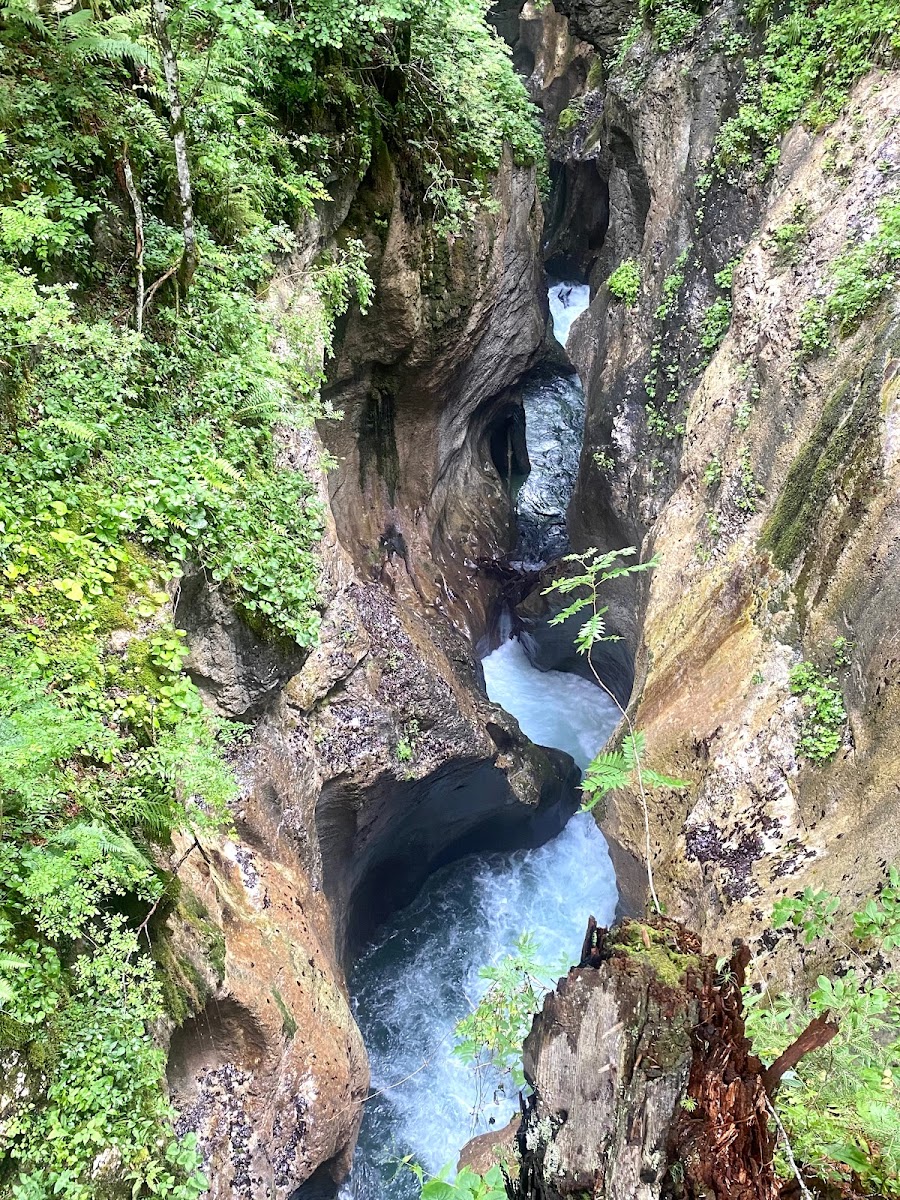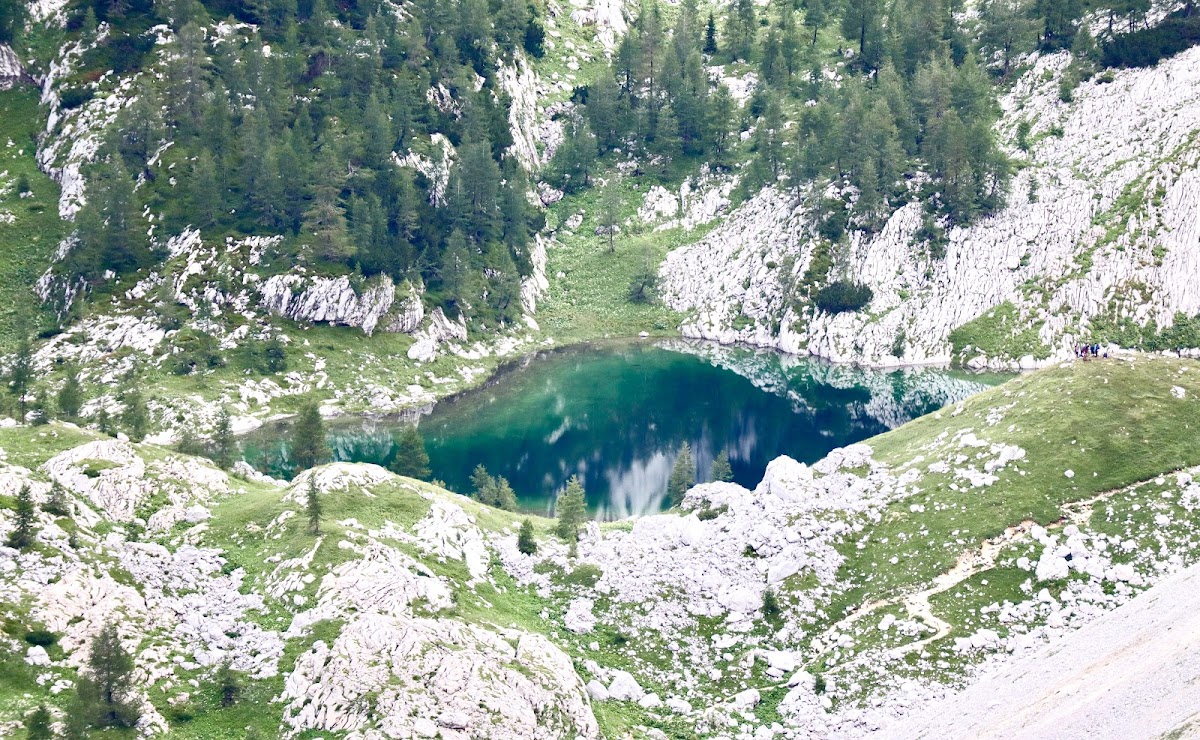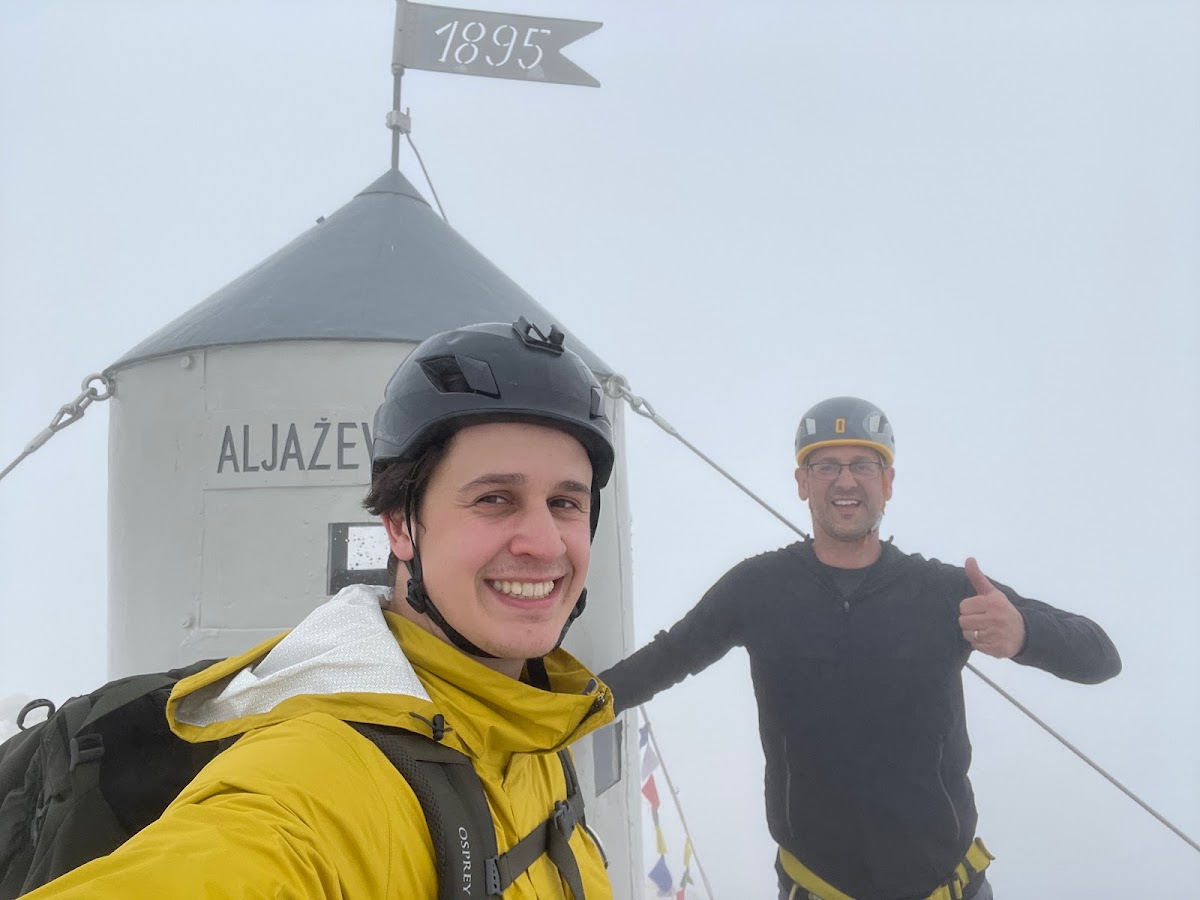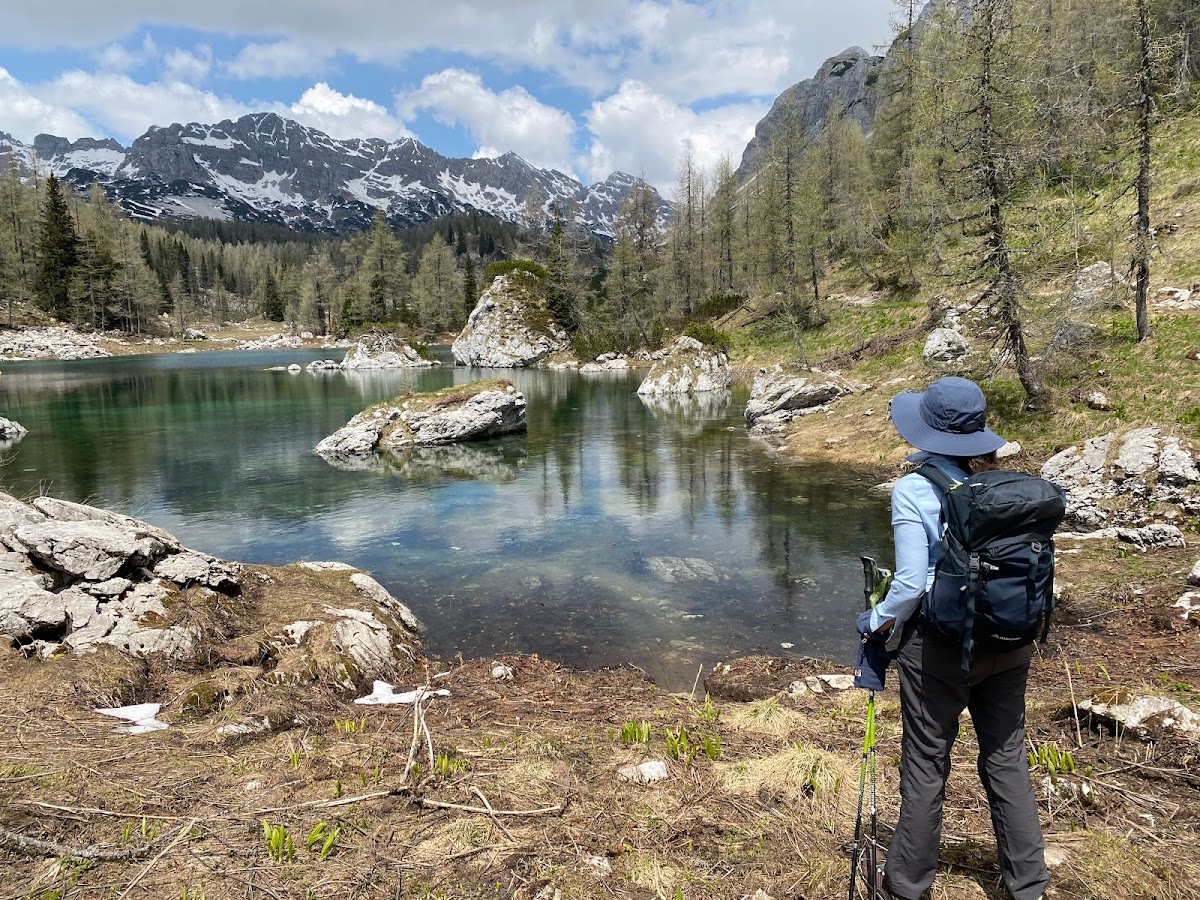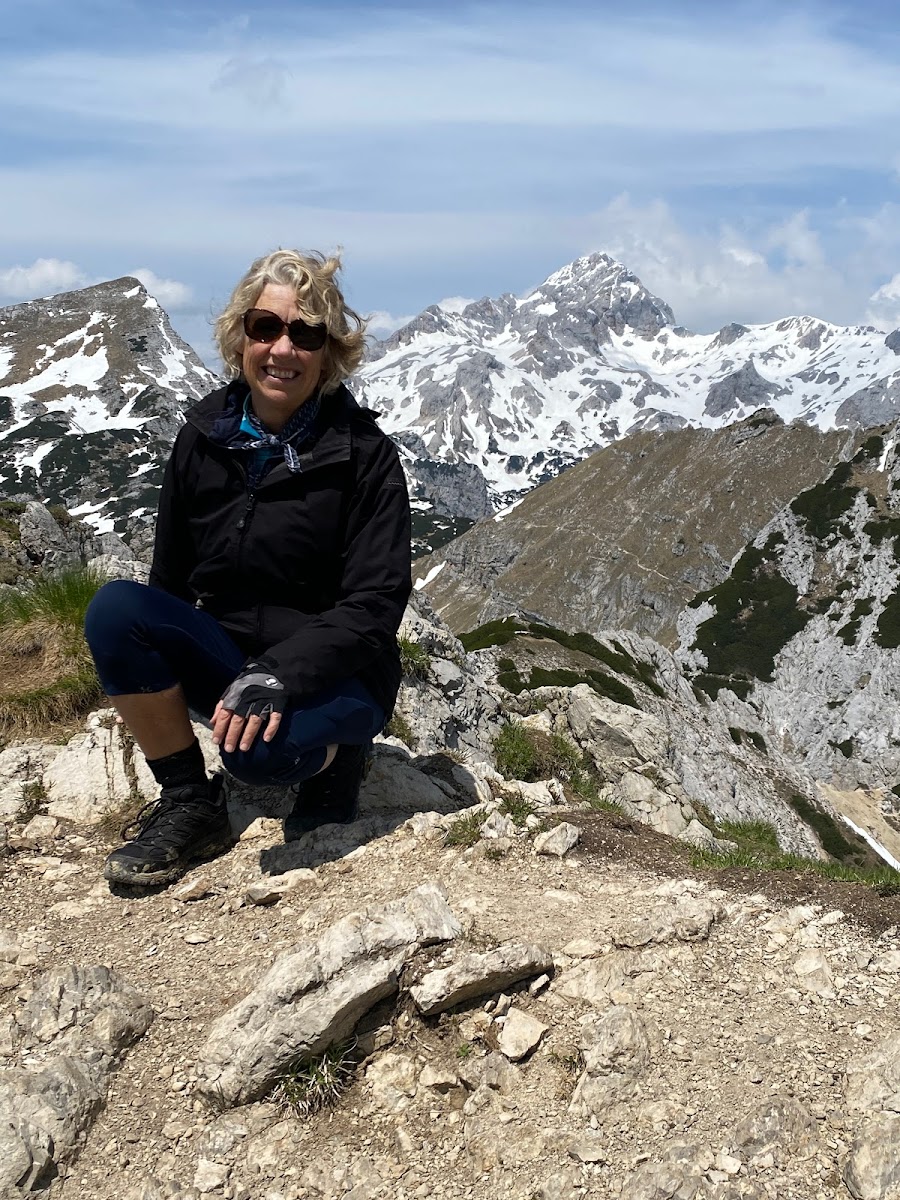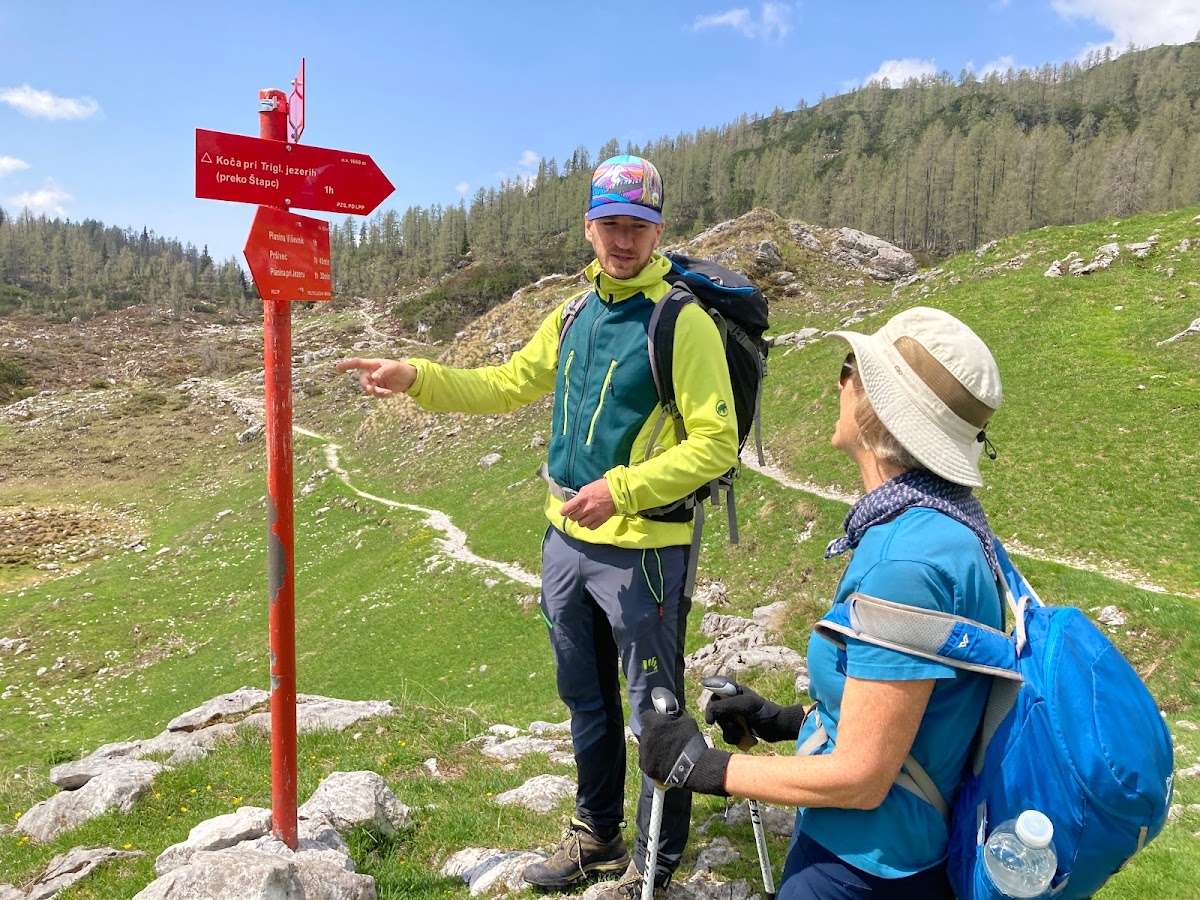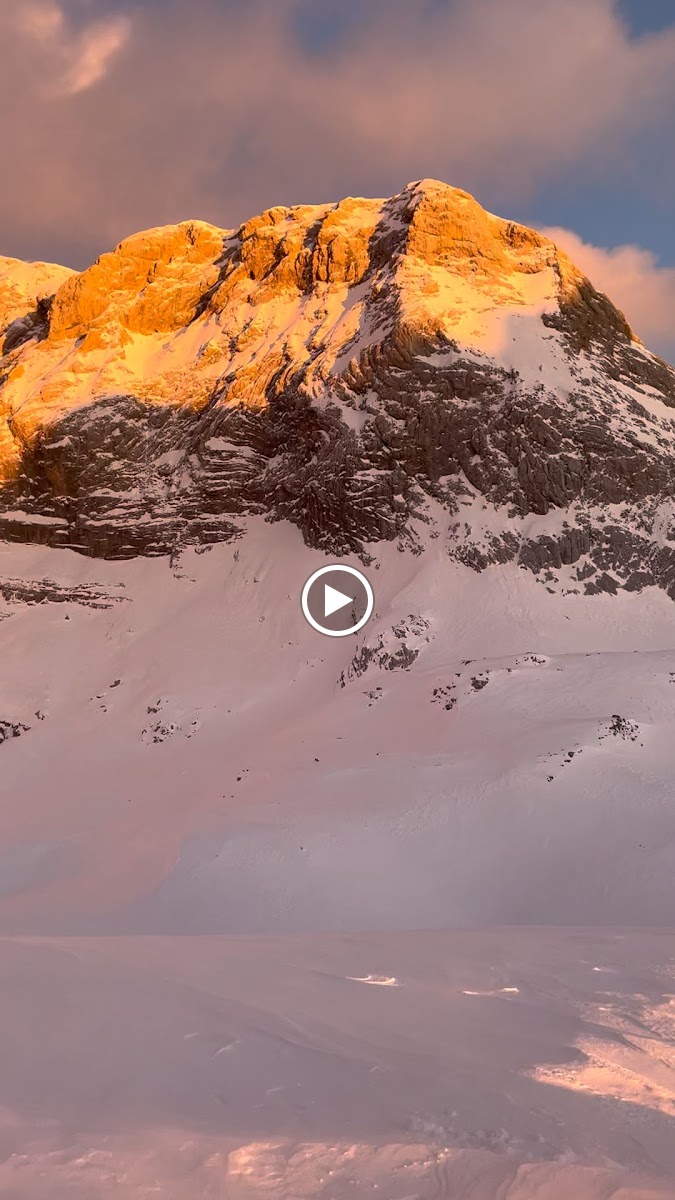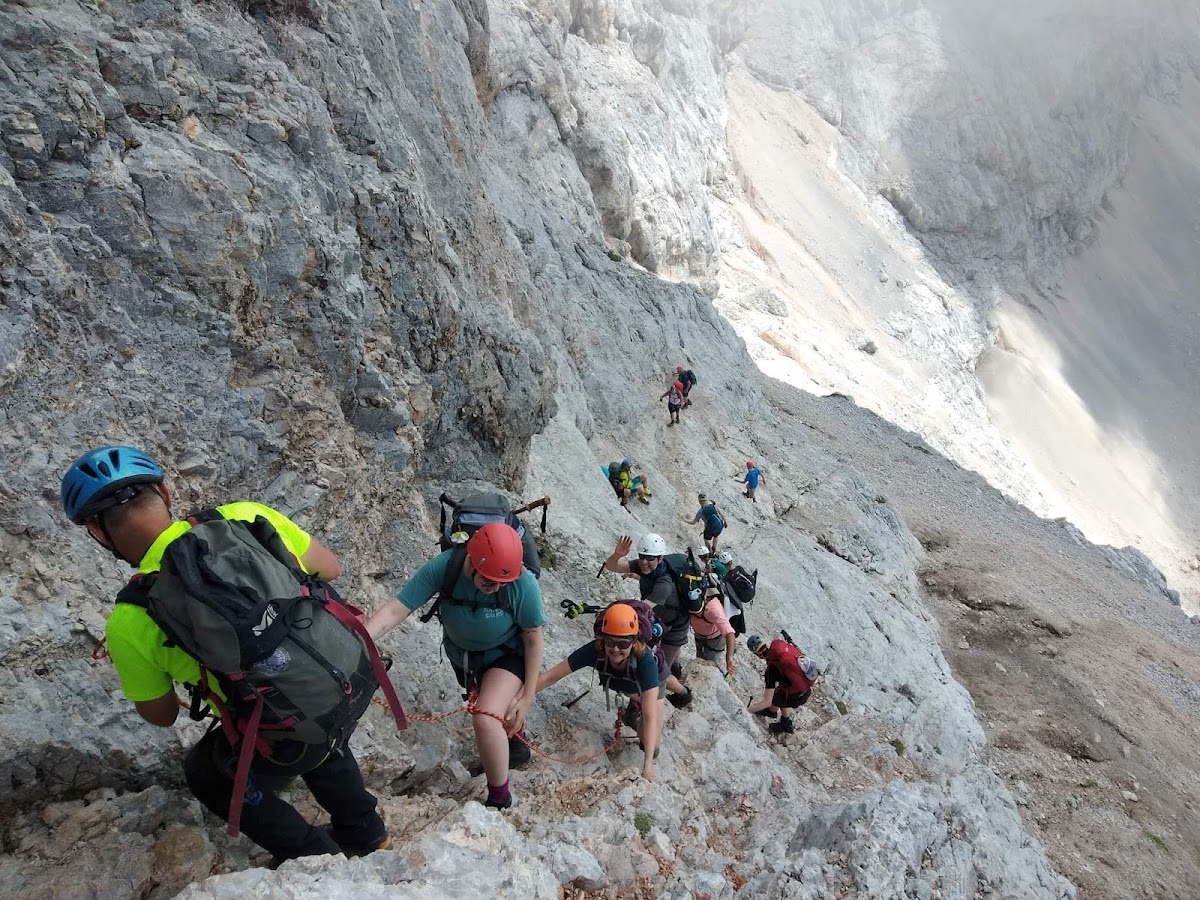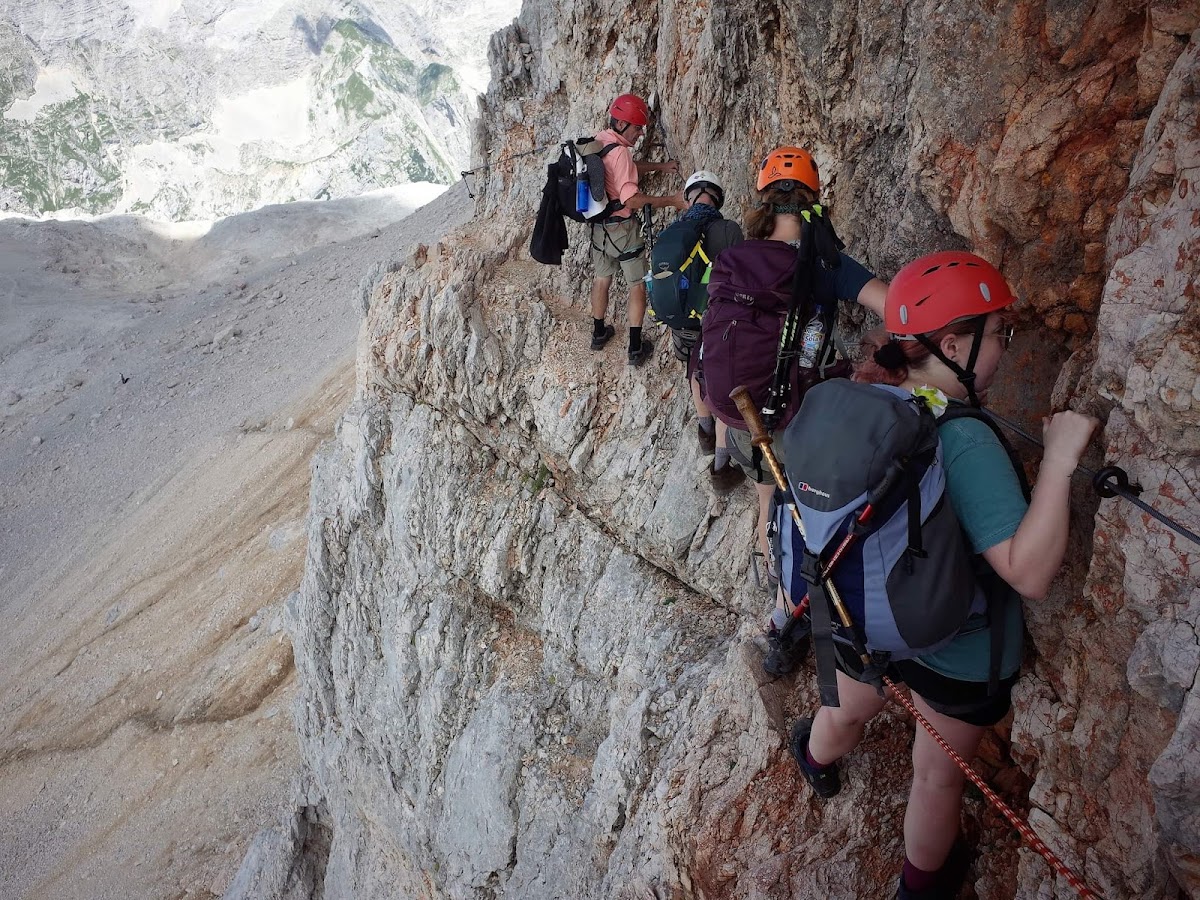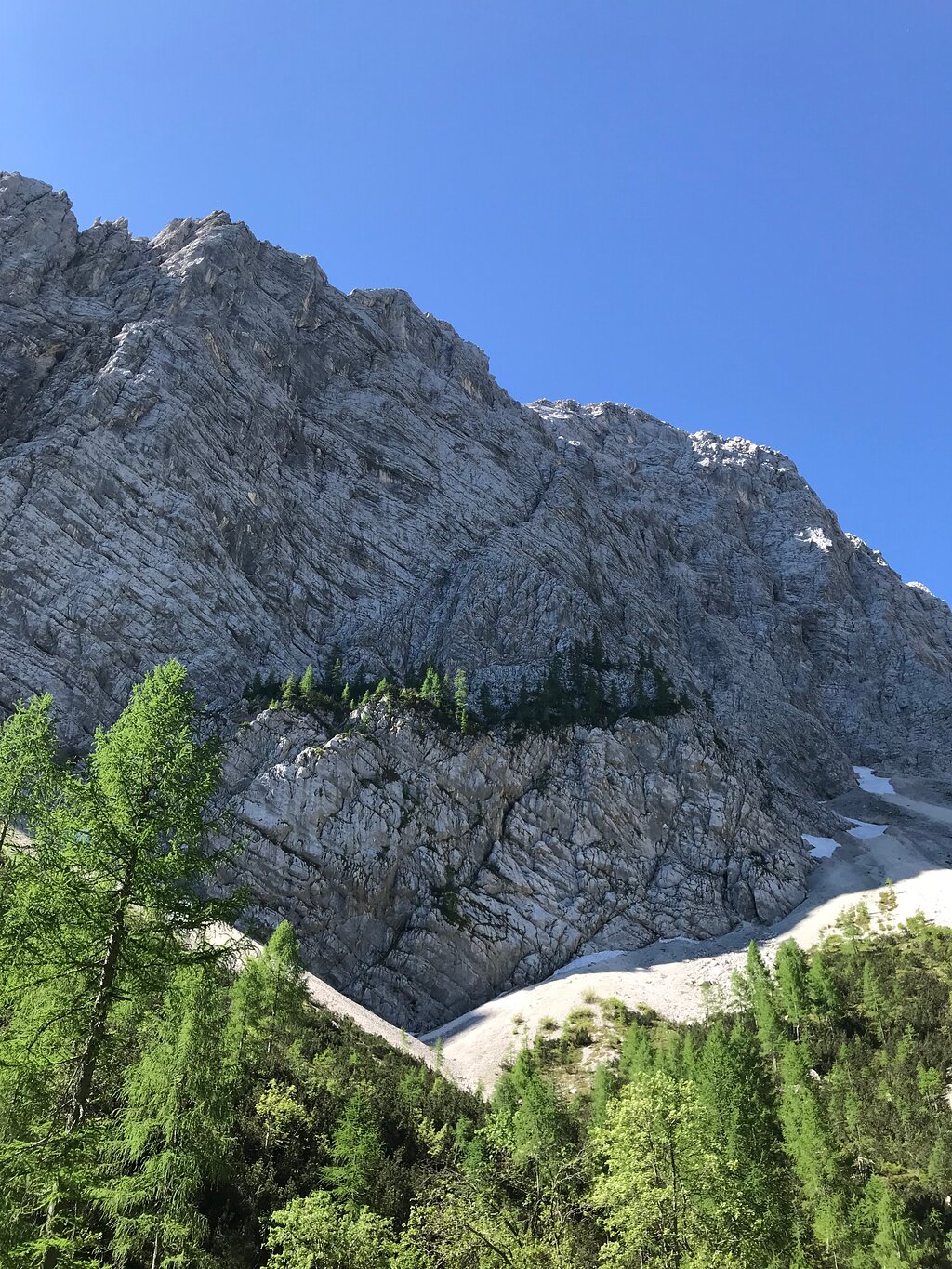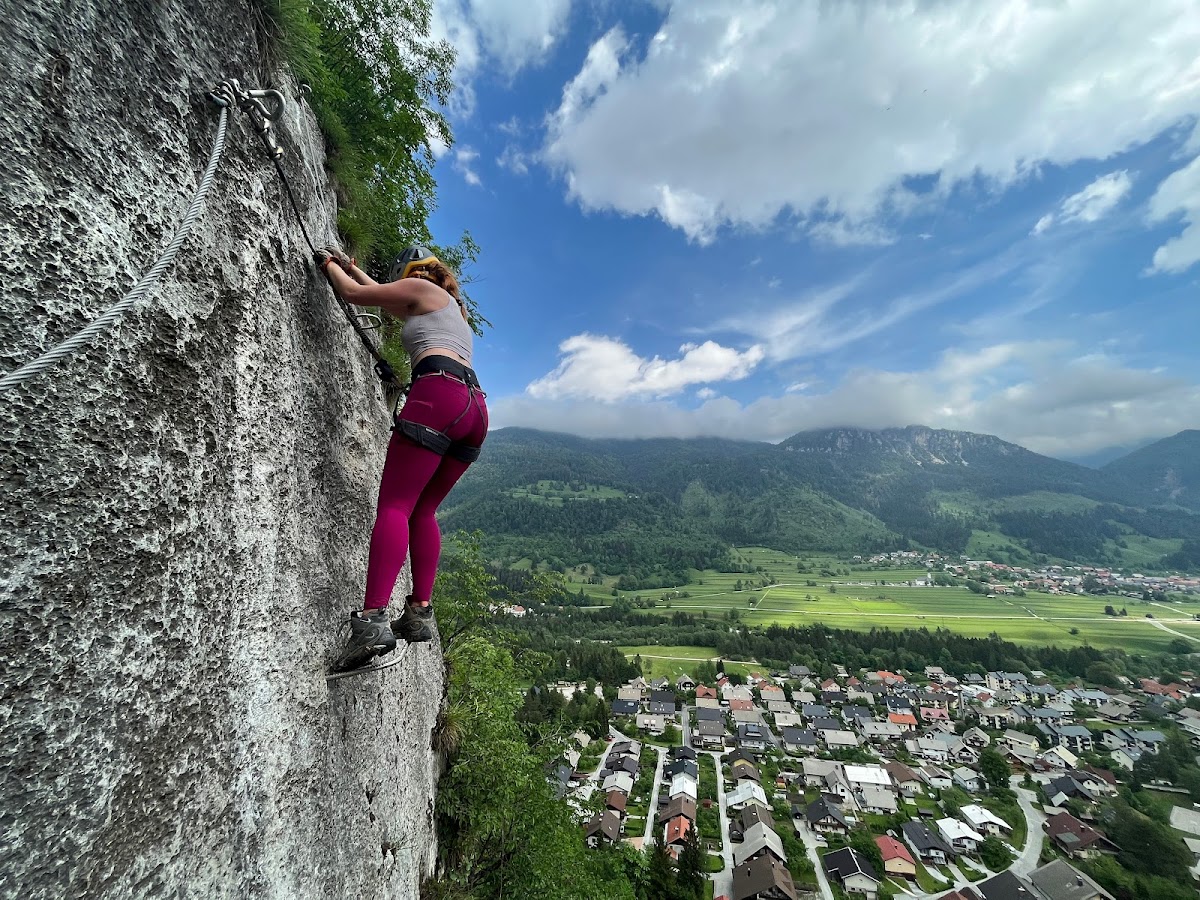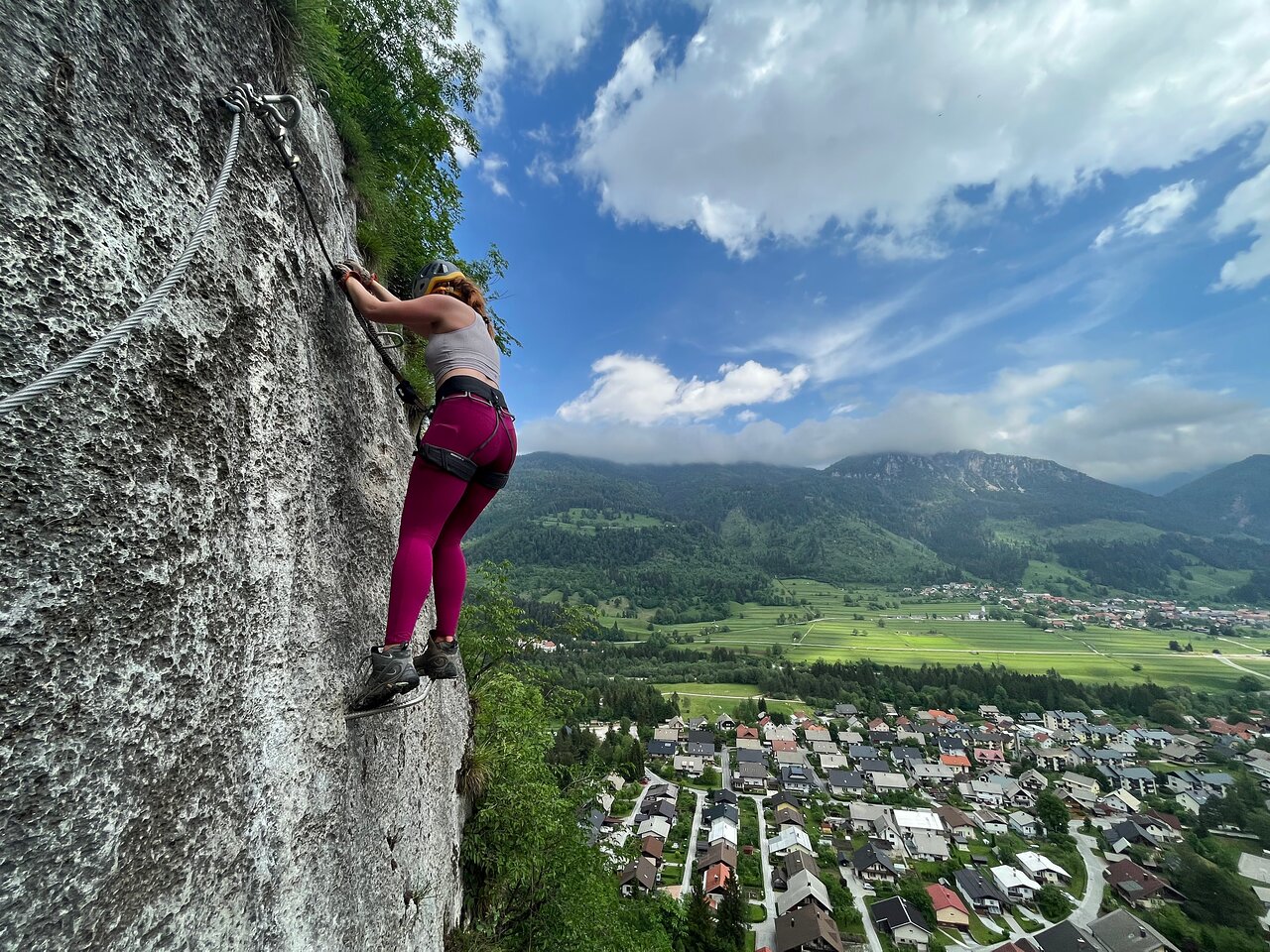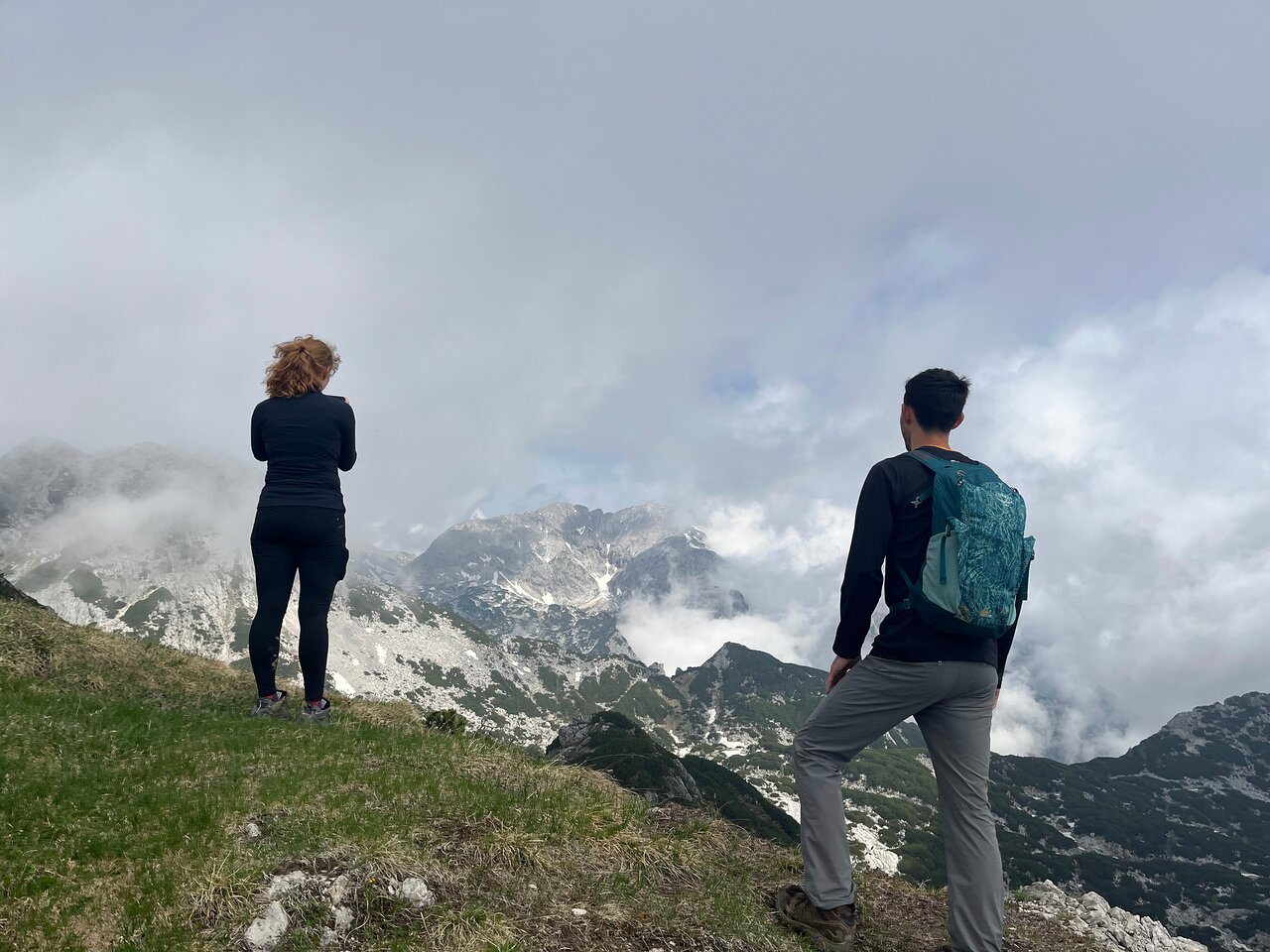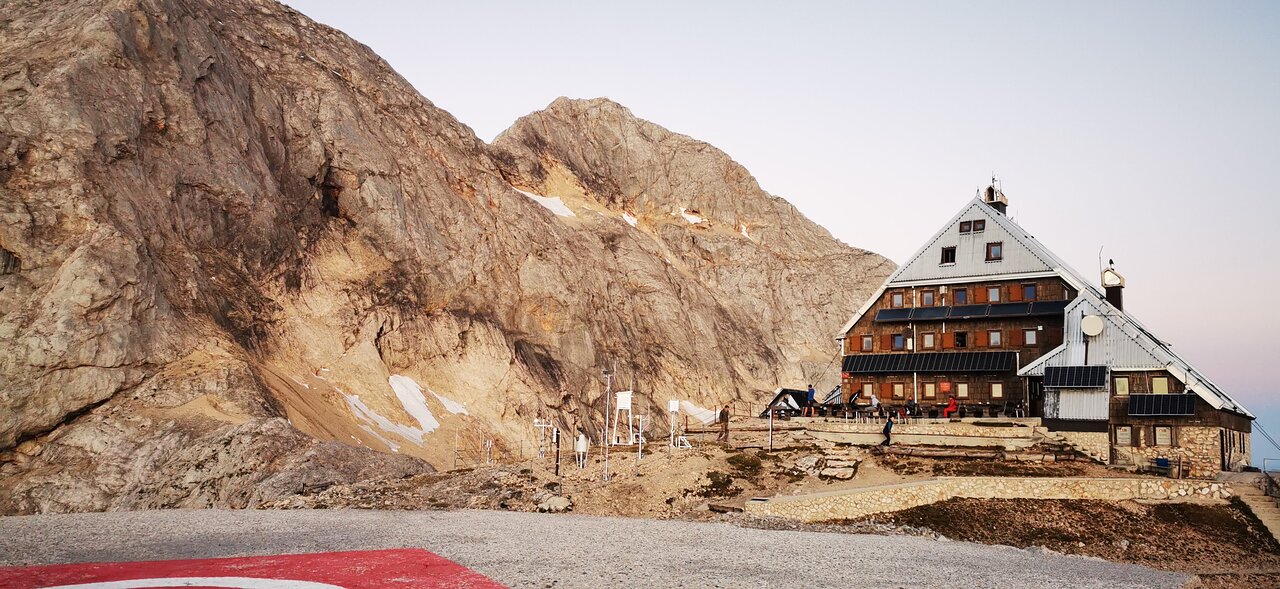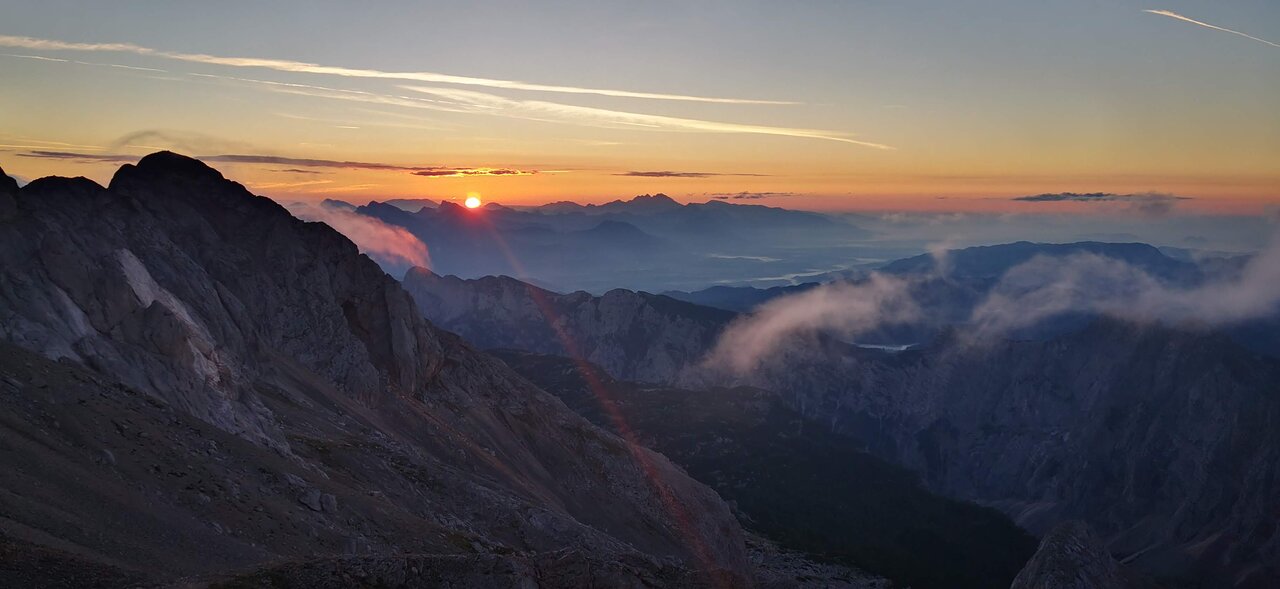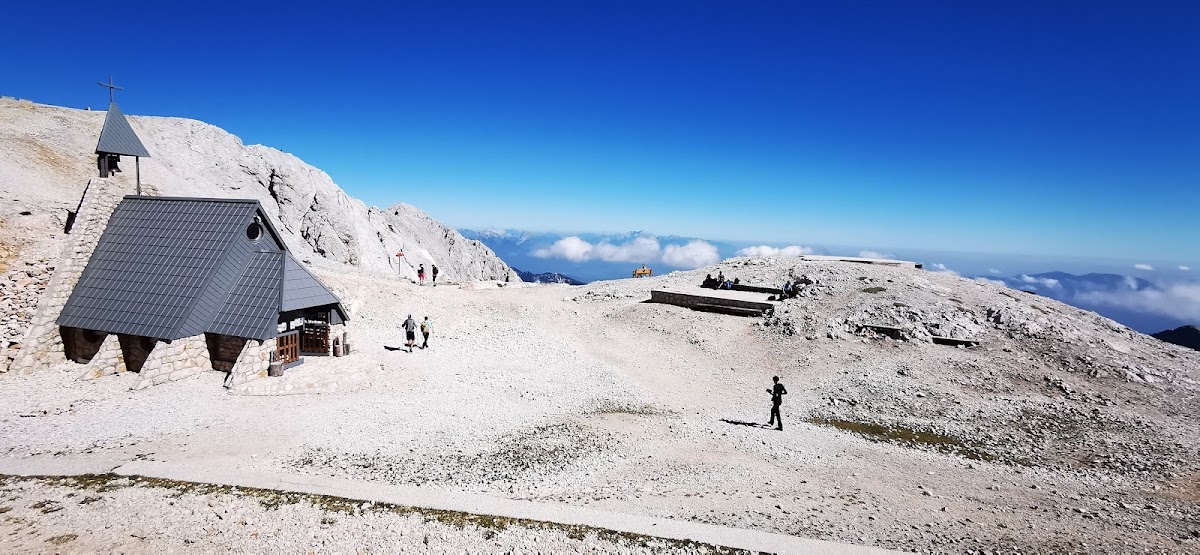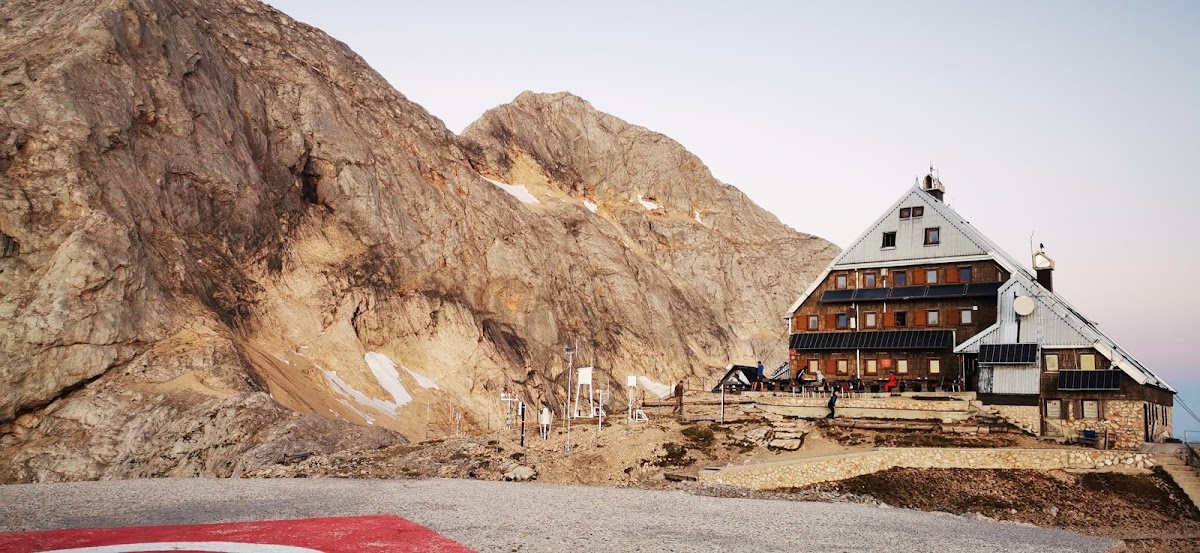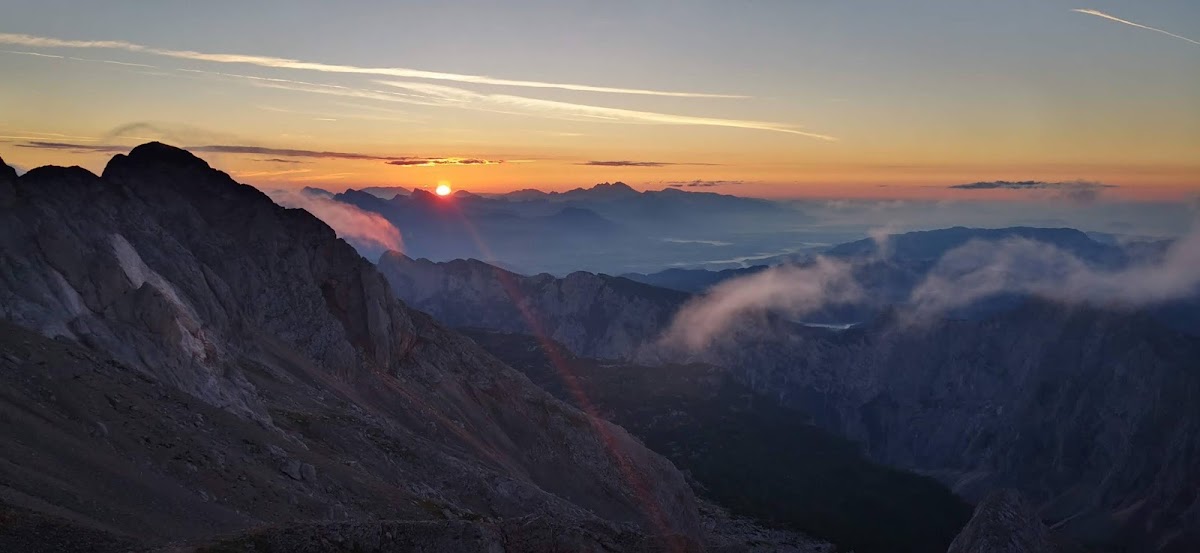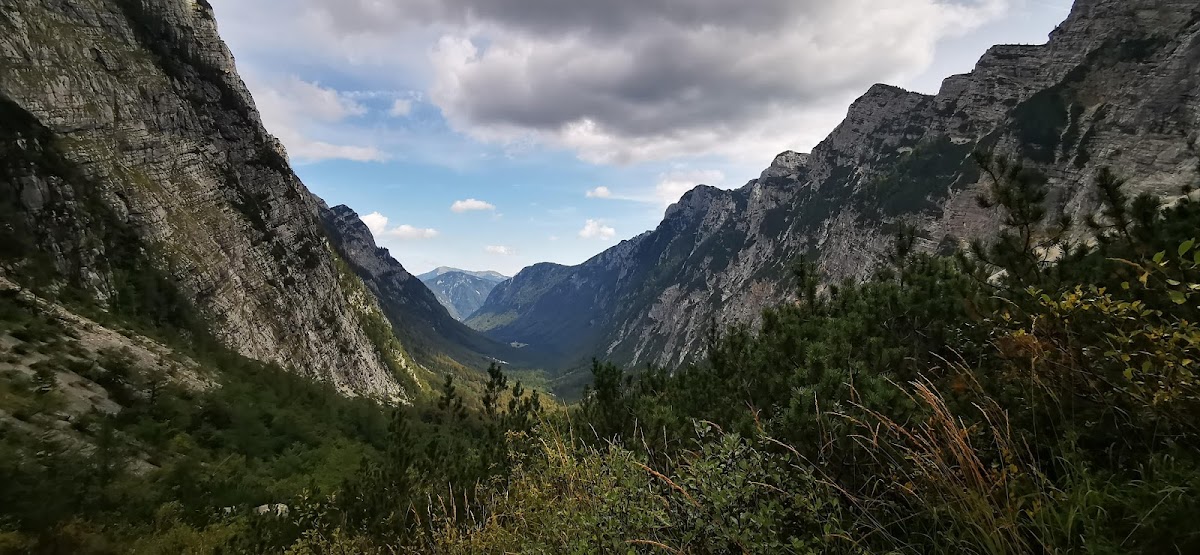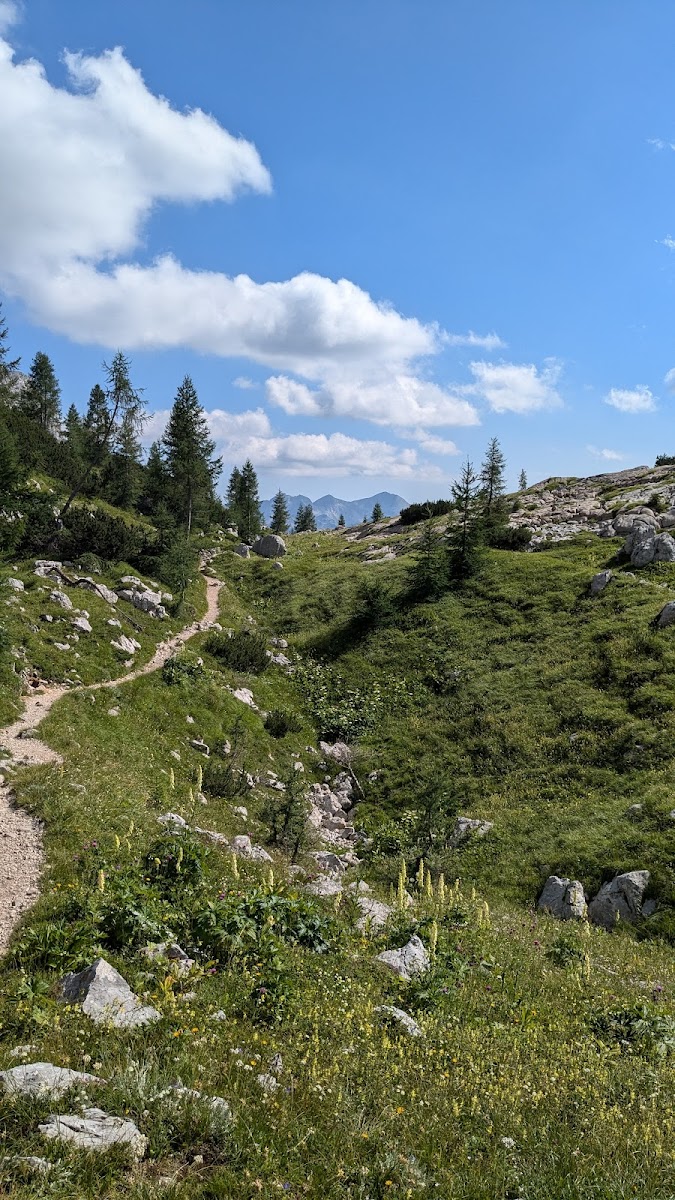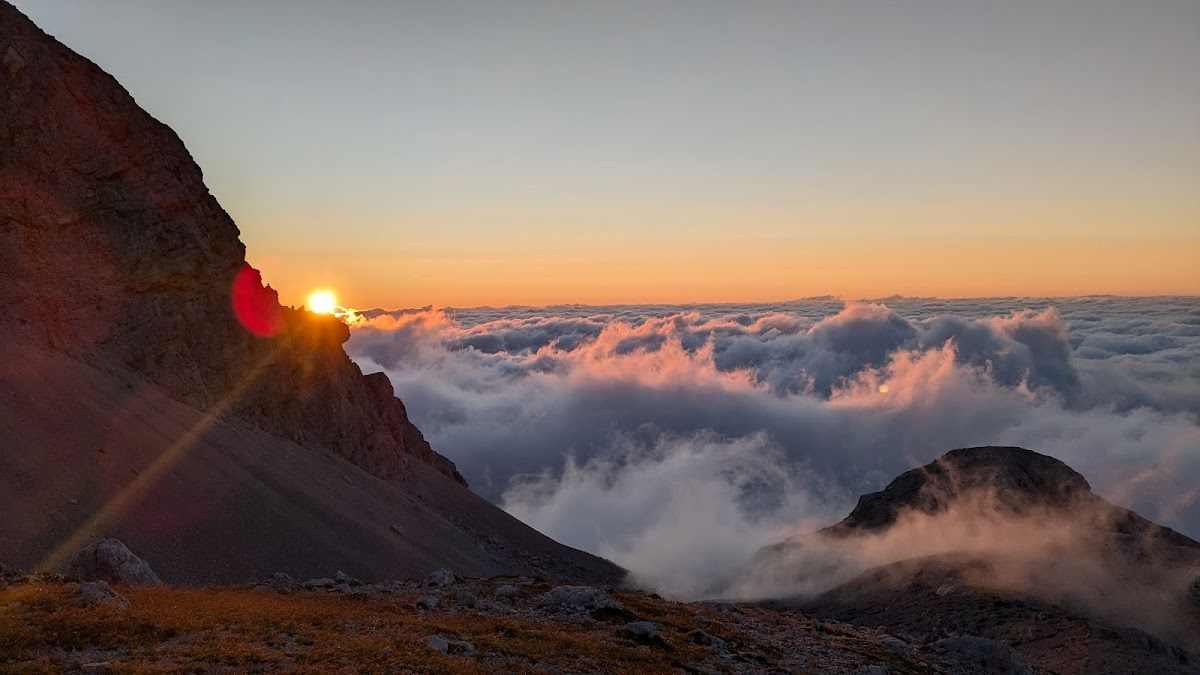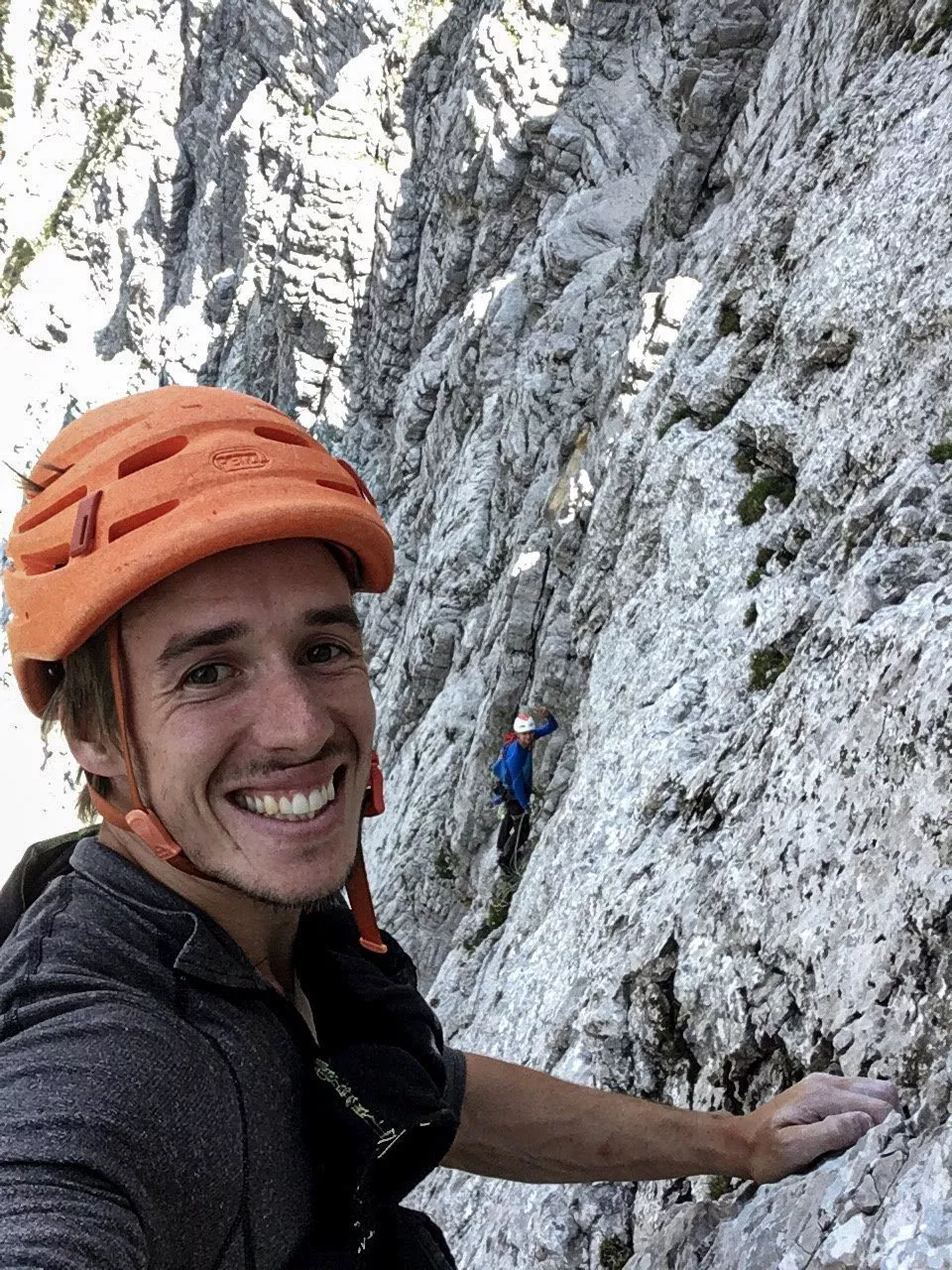Triglav is the highest mountain in Slovenia and the Julian Alps. With its 2864 metres of height, it is seen almost everywhere in Slovenia, always inviting people to climb it.

For most people from Slovenia, climbing Triglav is a right of passage that makes them a true Slovenian. Although not the easiest hike, we believe everyone can do it — you just need to be prepared and know the best ways to tackle the summit.
It was first climbed in 1778 when a group of four brave men found a way to its top from Bohinj. At that time, the climb was extremely difficult, as the final ridge before the top was so sharp they had to ride it like a horse. Later on, that ridge was flattened to allow more people to climb Triglav and enjoy the view from the rooftop of Slovenia.

And when in 1895 Jakob Aljaž bought a piece of land on the summit and built there a small shelter, it made Triglav forever a Slovenian peak and a national symbol. Standing on its peak now and admiring the view from the Adriatic Sea to the Alps is a dream of many Slovenians and a wonderful experience for any hiking enthusiast.
Here is everything you need to know about climbing Triglav.
Hiking Triglav?
If you’ve landed on this page by searching for “hiking Triglav,” it’s important to clarify a key distinction: this guide is dedicated to climbing Mt. Triglav, the highest peak in Slovenia. Climbing Mt. Triglav is an adventurous endeavor that involves more than just a casual hike; it’s a climb that requires proper preparation, equipment, and a good level of physical fitness.
However, if you’re more interested in hiking experiences within Triglav National Park, we have another guide that will be more aligned with your interests: our comprehensive guide to hiking in Triglav National Park.
And if you’re interested in hiking tours, you can check out Slovenia Hiking Tours.
How Difficult is it to Climb Mount Triglav?
Mount Triglav hike is widely considered an intermediate-level climb. However, although the most popular routes are not very technically demanding, they always include steep and exposed sections and should never be underestimated. Knowing your abilities is everything. Regardless of the chosen route, it is highly important that you are in good physical shape and have no fear of heights.
Climbing Triglav (along certain routes) is also suitable for families. Children must be over the age of 12 and should be able to walk for up to approx. 6 consecutive hours.
With some prior high-altitude hiking experience, reaching the summit of Triglav presents visitors with a challenging yet rewarding experience.
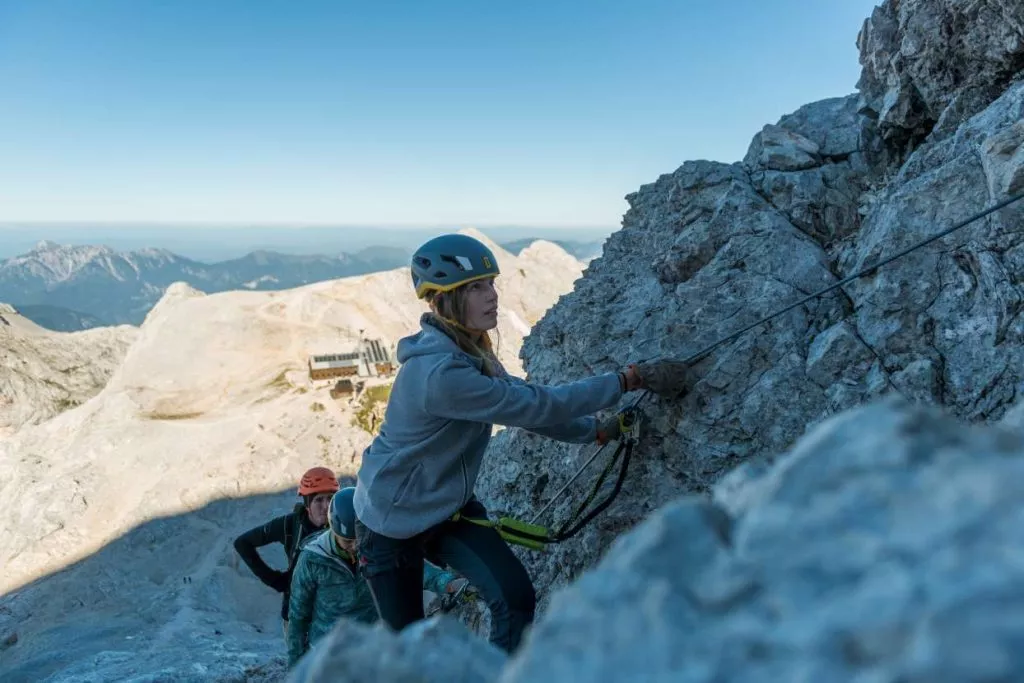
Triglav Hiking Routes – Which one to choose?
As should be expected for such a popular and accessible mountain, visitors to Triglav can reach the summit on a multitude of various routes of all difficulty levels.
Most starting points for a Mount Triglav Hike start in one of the valleys surrounding it. Because some valleys have multiple routes leading from them, you need to choose not only the right starting point but also the right route.
Although some routes are more technical, some longer, and some more scenic, you’ll have limited options on the final hour of the climb. That’s because all routes finally lead up to the summit in one of three ways: Either from one of the two huts right below the peak or through Triglavska Škrbina.
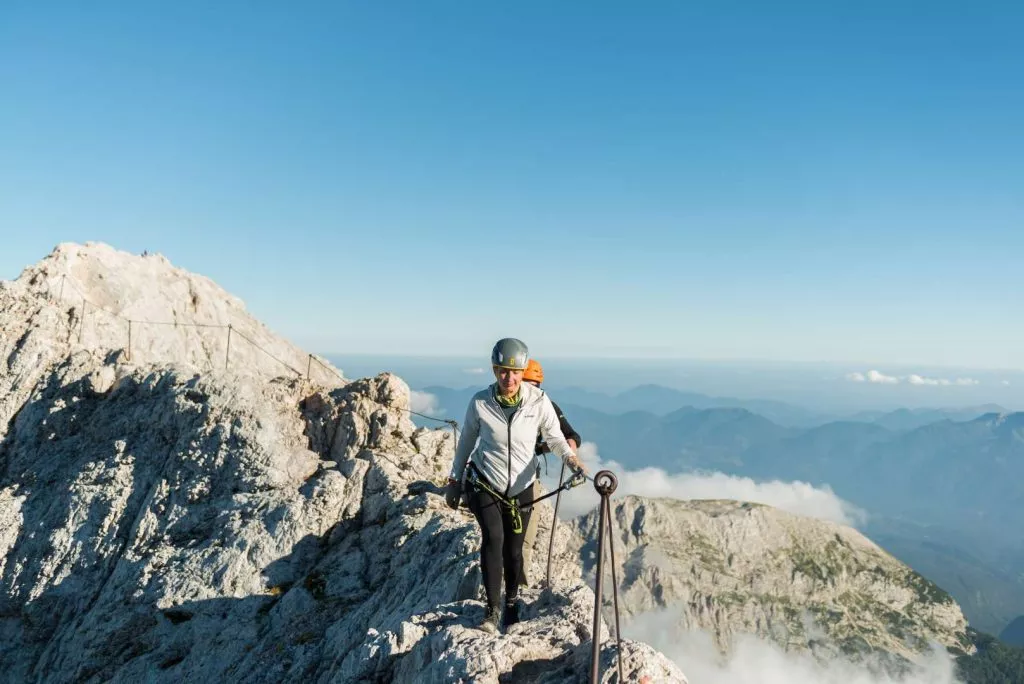
All three are secured Via Ferattas, which means the final section of every route to Triglav is steep and exposed. What that means is that having a great fear of heights is a no-go, because you can’t choose a route that skips one of these more difficult sections.
With that out of the way, let’s check out the best Triglav routes.
1. From Krma Valley
This is the most popular route to Triglav, as it is the most straightforward and without technical difficulty (except for the last part, about which we talked above). It is also the best option if you want to climb Triglav in one day.
The route starts in the Krma Valley, where the relatively easy incline takes you through the forests and Alpine pastures, surrounded by high mountain ridges on both sides. Don’t forget to look back to see the unique U-shape of the glacial valley.
The higher you hike, the more the landscape becomes Alpine. Surrounded by some of the highest peaks of the Julian Alps, you’ll slowly make your way towards the biggest one in front of you, Mt. Triglav.
On approximately half of the hike, you can decide which of the two huts below Triglav you want to go to — Planika or Kredarica. It is possible to do a circular route, where you climb to the peak from Kredarica Hut and descend down a slightly easier Via Ferrata towards the Planika Hut.
Route Facts (one way):
Distance: 11.5 km
Elevation gain: 1955 m
Walking time: 6h
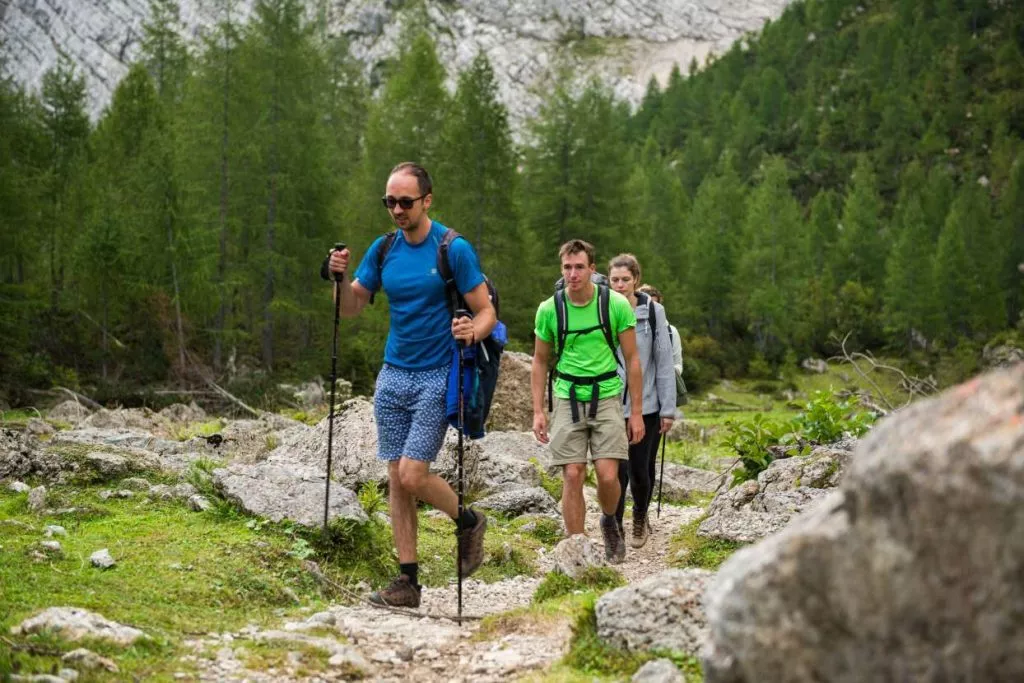
2. From Vrata Valley
The Vrata Valley extends towards the North Face of Triglav. Like many other northern approaches in the Alps, the routes from the Vrata Valley are steeper, rockier and more exposed. In that sense, they are also more fun for those who get bored by walking for too long.
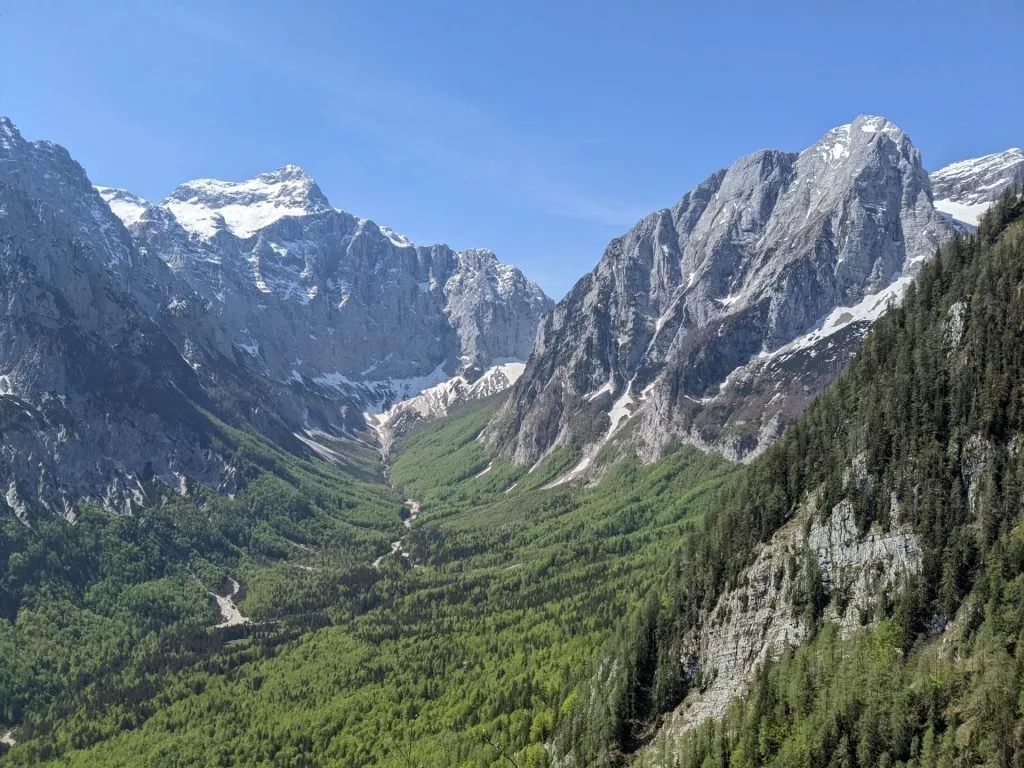
There are three marked routes for climbing Triglav from Vrata. They all start at the Aljaž Hut and then junction off at different points below the kilometre high north face of Triglav.
Let’s look at the three main routes from the Vrata Valley:
Čez Prag
This is the most popular route from Vrata. It is the easiest of the three, and takes you left from the North Face towards the eastern Triglav plateau, where you hike close to the Stanič Hut, and then continue towards Kredarica.
The route has quite a steep ascent from the Vrata Valley. There are some sections of Via Ferrata (steel cables and pegs), even an almost vertical 10-metre climb secured with a steel cable. After you arrive to the plateau, the path becomes less steep. You only have to watch out to not fall in one of the holes formed by water, a characteristic part of the high-altitude Karst.
After around 5 hours of walking, you will arrive at the Kredarica hut, where the path continues as a secured Via Ferrata to the summit of Triglav.
Route Facts (one way):
Distance: 8.2 km
Elevation gain: 1860 m
Walking time: 6h10min
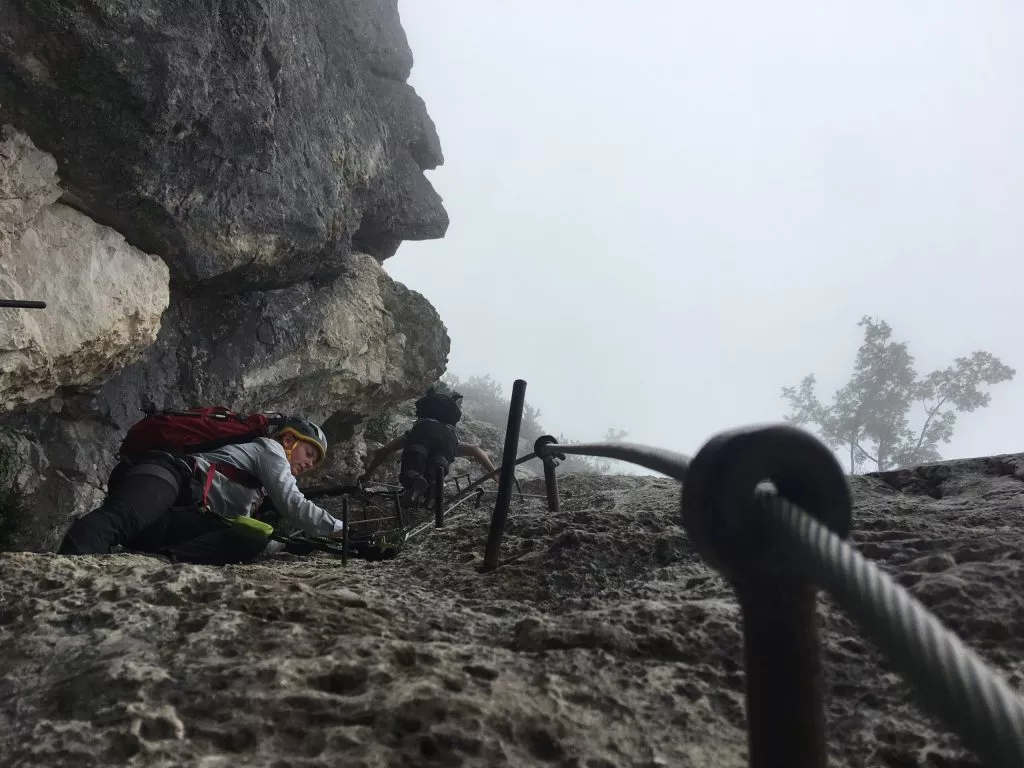
Tominškova
This path from Vrata takes you more to the left of the Prag route and meets with it at the plateau. It’s slightly harder than the former but takes about the same amount of time. Usually, people use it as a way of ascent but choose Prag for the descent.
Route Facts (one way):
Distance: 5.9 km
Elevation gain: 1860 m
Walking time: 6h
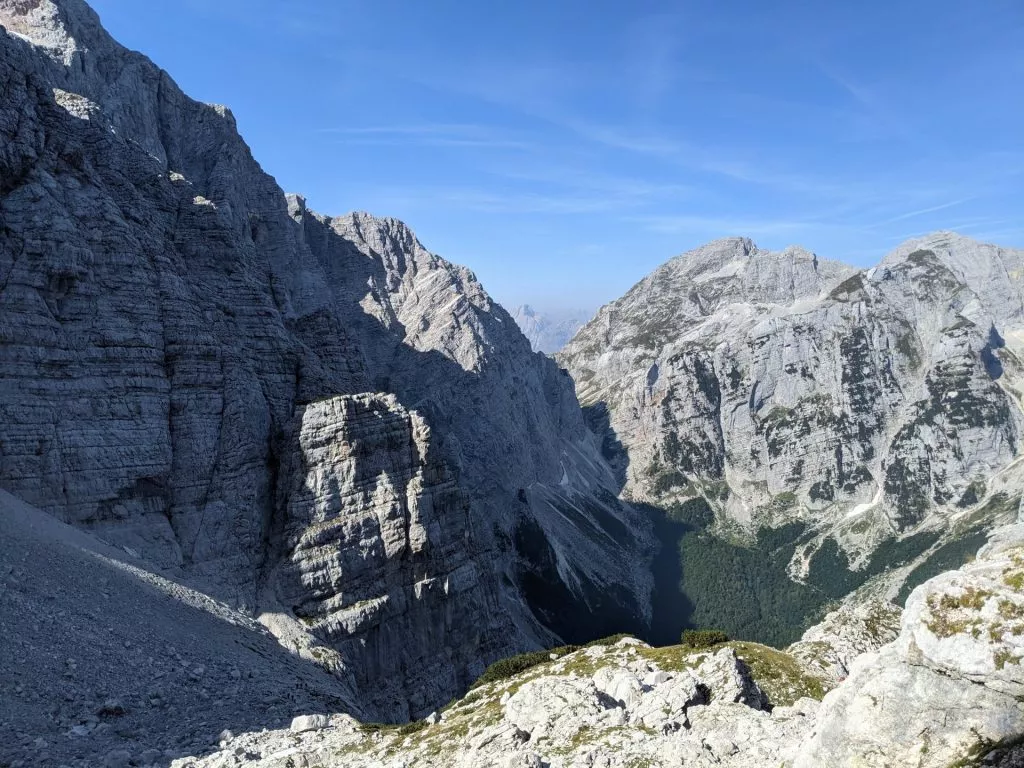
Čez Plemenice
This is the hardest and arguably the most scenic route to Triglav. It is the one that takes you the closest to the Triglav North Wall and where you can admire the epic Sphinx rock on the Wall.
Where the Prag and Tominškova routes go left, this one continues straight towards the end of the Vrata Valley. At the small “saddle” called Luknja (eng. hole), you put on your helmets and harnesses and tackle on the Via Ferrata towards the Western Triglav Plateau. After crossing that, ascend Triglav via the Triglavska Škrbina route.
Use one of the other two routes for going back down to the Vrata Valley.
Route Facts (one way):
Distance: 7.1 km
Elevation gain: 1849 m
Walking time: 6h30min
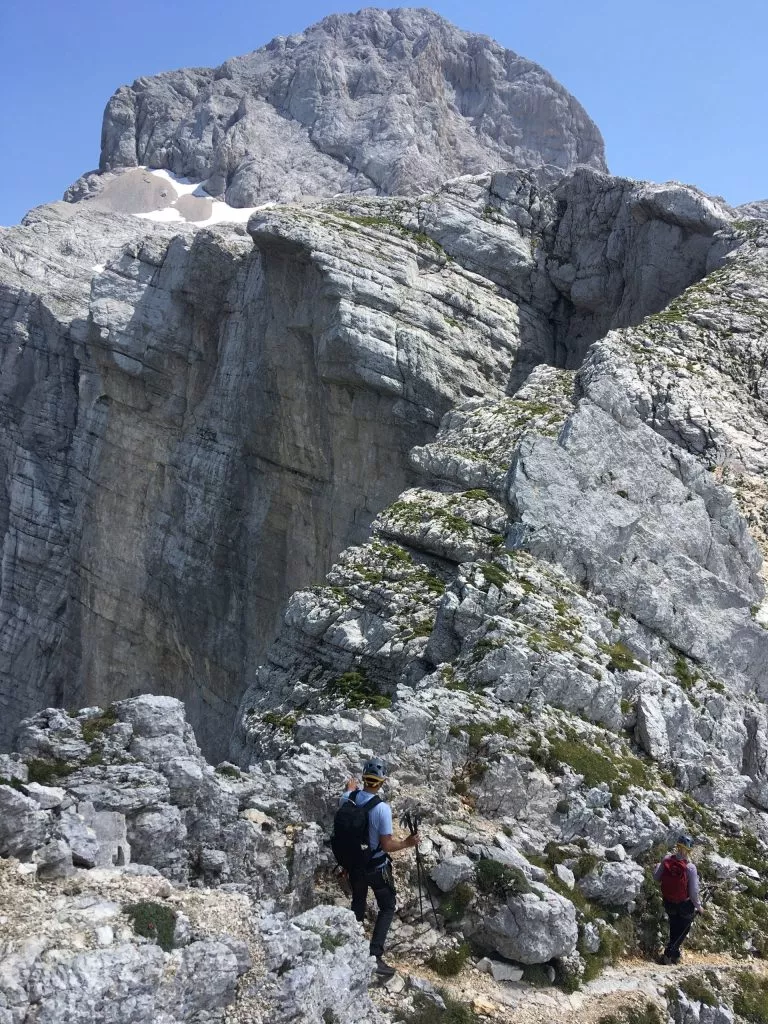
3. From Pokljuka
This is also one of the more popular routes to Triglav since it has a slightly lower elevation difference (though it is longer). It starts on the Pokljuka plateau, a popular starting point for various different hikes.
It takes you past mountain pastures, across saddles and many peaks towards the Vodnik Hut on Velo Polje. From there, it starts climbing up toward the Planika Hut, where you continue on the standard Via Ferrata to the summit.
Route Facts (one way):
Distance: 11.8 km
Elevation gain: 1650 m
Walking time: 6h
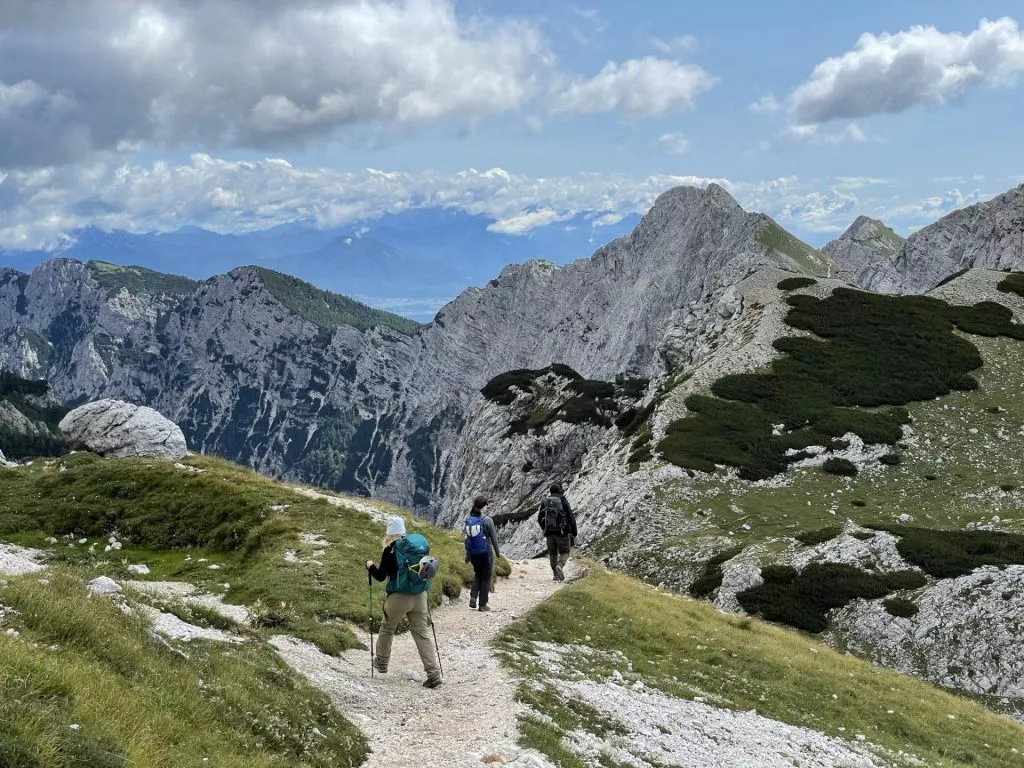
4. Through the Triglav Lakes Valley
If you have time and you really want to experience not just Triglav, but also the Triglav National Park, then you should definitely choose this route.
It starts at Lake Bohinj — either at the Savica Hut or higher up at Planina Blato. From there it takes you toward the magnificent Triglav Lakes Valley. There you follow the valley to its end, past the Prehodavci Hut and across Hribarice to Dolič Hut. Most people choose to sleep here, and then continue the next day towards the Western Triglav Plateau (see Čez Plemenice), and then to the Triglav summit across Triglavska Škrbina.
Definitely, this route needs at least two days to complete. But if you want to increase the enjoyment, you can add a day to do a round trip past the Vodnik Hut and Planika for your perfect Triglav 3-day hut-to-hut tour.
Route Facts (one way):
Distance: 17.5 km
Elevation gain: 2530 m
Walking time: 8h45min
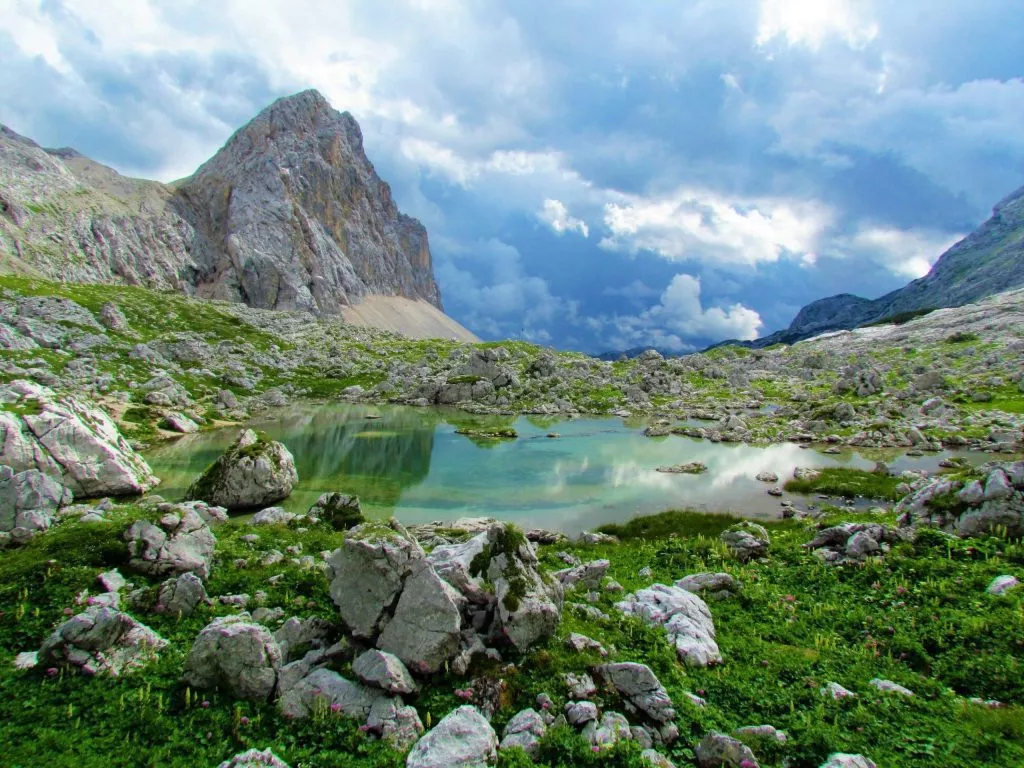
5. From Trenta
This path starts in the Trenta Valley, or more precisely, the Zadnjica Valley, very close to the amazing emerald Soča River.
The path leads you on a mule track (wide stone path built for military purposes between the world wars) towards the Dolič Hut. From there it takes the same route as the Triglav Lakes route towards the Western Triglav Plateau and across Triglavska Škrbina to the summit.
Because of the high elevation difference, it is recommended to stay the night in the Dolič Hut.
Route Facts (one way):
Distance: 13.9 km
Elevation gain: 2215 m
Walking time: 7h15min
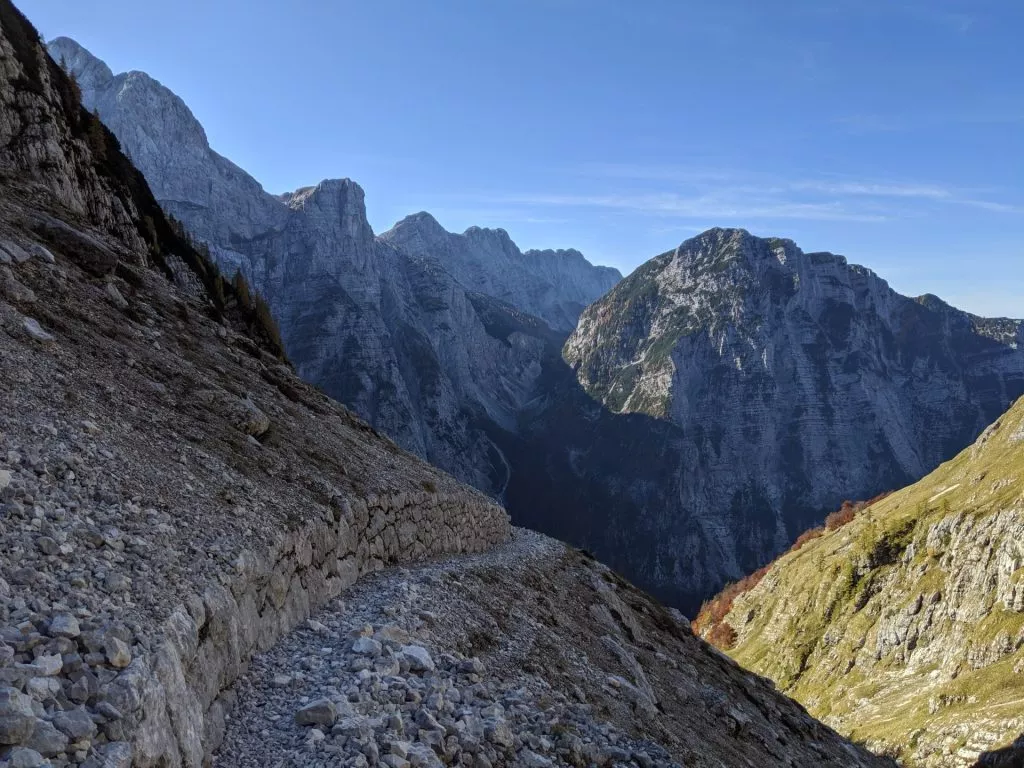
6. From Kot Valley
This is the third and the smallest of the Triglav Valleys (besides Vrata and Krma). It is also the least visited, and so is this route.
From Kot, the route ascends (with some help from iron pegs and steel cables) towards the Stanič Hut under Triglav. From there it continues to the Eastern Triglav Plateau and to Kredarica Hut. It is good to sleep at any of these two huts, before taking on the Via Ferrata to the summit.
If you want to experience a little less visited path to Triglav this is the route to choose. But be prepared to meet many people at Kredarica either way.
Route Facts (one way):
Distance: 8.5 km
Elevation gain: 2050 m
Walking time: 6h10min
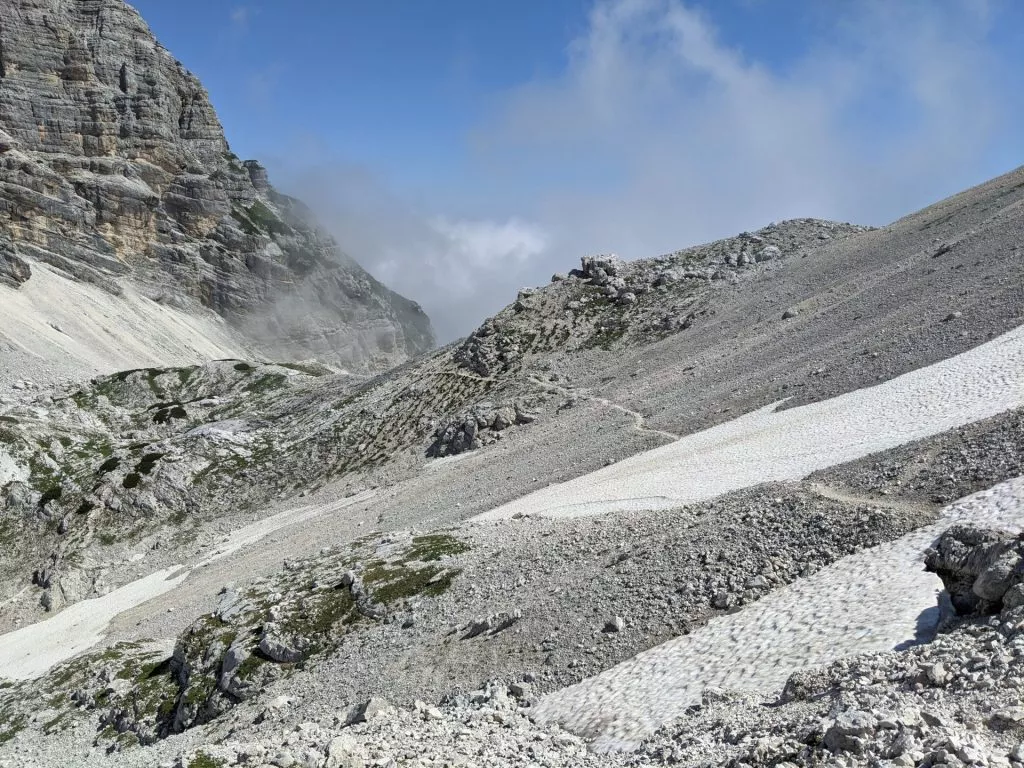
7. North Face of Triglav
The Triglav North Face or as the locals call it — The Wall — is a formidable wall of rock towering one kilometre above the Vrata Valley. It is the cradle of Slovenian alpinism and yes, it has many routes one could use to climb Triglav.
Of course, if you’re not an alpinist, these routes can only be done with a professional guide. And most of them you cannot even do with a guide, if you don’t have the necessary experience and skills to climb walls of such difficulty.
The easiest route up the Wall is the Slovenian Route — with the help of a professional guide, anyone can do it. Find out more about climbing the Triglav North Face here.
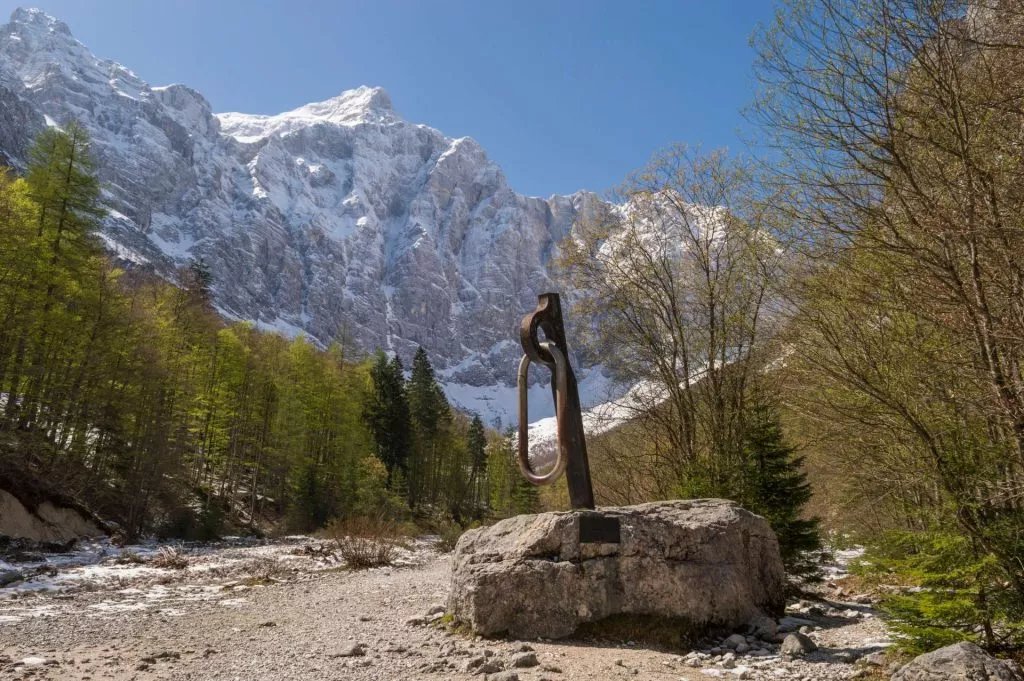
Map of All Triglav Hiking Routes
Triglav Mountain Huts
There’s a reason why mountain huts have become such an integral part of Slovenian Alpine tradition. They are the most welcome shelter a visitor to the mountains could ever wish for.
Cosy yet simple, these high-altitude havens also line the routes leading up to Triglav. Tasting scrumptious authentic dishes and waking up above the world is an unforgettable experience in itself.
Except for Kredarica, which doubles as a meteorological outpost during winter, the mountain huts on the way to Triglav operate from June to September.
Booking in advance is a must. After all, Triglav is the most popular mountain in Slovenia, so accommodations up there are scarce. It’s advisable that you book up to half a year ahead, especially for the weekends of August and September.
Triglavski dom na Kredarici (Kredarica Hut)
This is the highest mountain hut in the country, situated on the Kredarica Plateau, 2515 m above sea level. Although it can accommodate larger numbers, this very fact hints at overcrowdedness. It is indeed the most popular mountain hut under Triglav.
Altitude: 2515 m
Season: June – September (unofficially also in the winter)
Capacity: 341
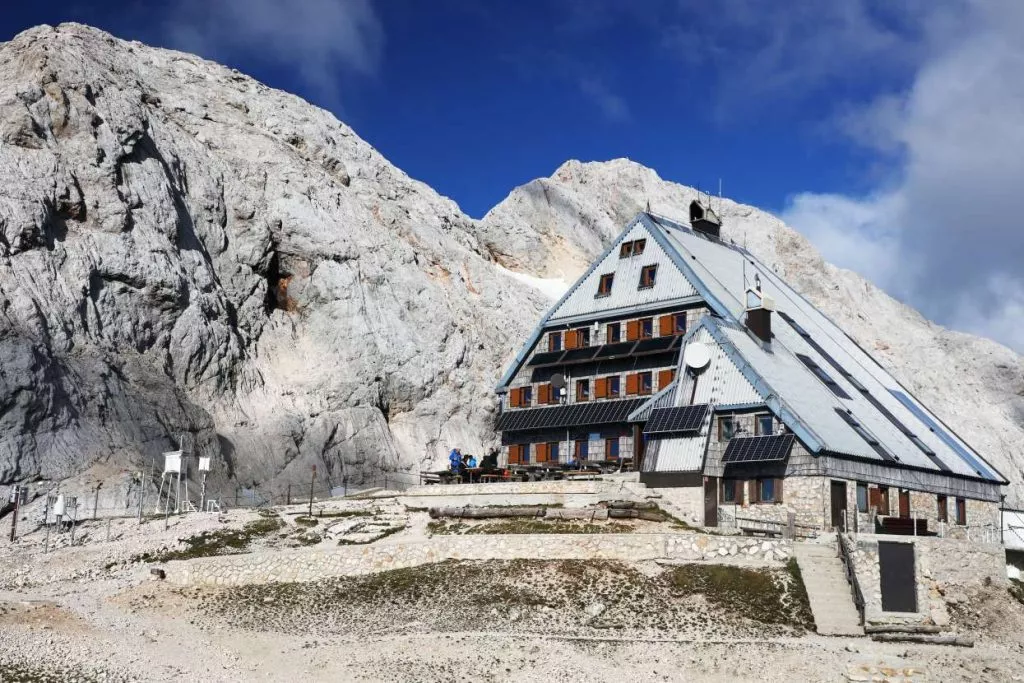
Dom Planika pod Triglavom (Planika Hut)
Based on the southern side of Triglav, the Planika hut is only approx. 1.5 hours from the summit. This means you can recharge your batteries nicely for the final step, before descending into the lowlands the next day. It also allows you to choose from more routes up to the summit.
Altitude: 2401 m
Season: July – September
Capacity: 143
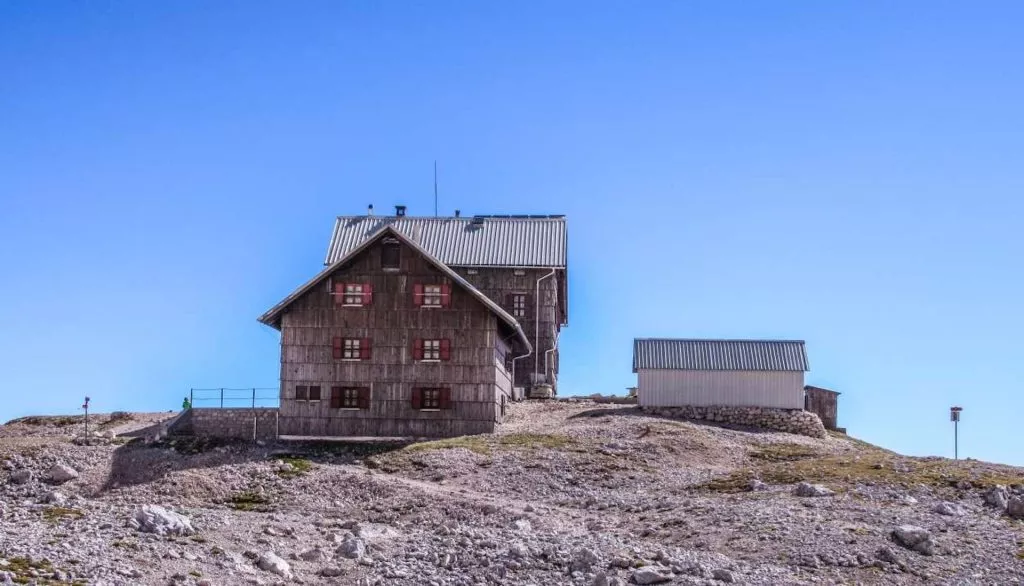
Tržaška koča na Doliču (Dolič Hut)
This rather small hut only accommodates 80 climbers. And that’s actually a plus, as it truly preserved and emphasises the Alpine vibe. The location above the Trenta Valley is stunning and is optimal for anyone hiking more from the west side of Triglav.
Altitude: 2151 m
Season: July – September
Capacity: 74

Vodnikov dom na Velem Polju (Vodnik Hut)
Although not many people stay in this hut on their way to Triglav, it is one of the most conveniently located huts for any adventure in the Triglav National Park. As it is at a slightly lower altitude than the other huts, it also has its own drinking water source which is quite a rarity in high-mountain huts.
Altitude: 1817 m
Season: June – September
Capacity: 70
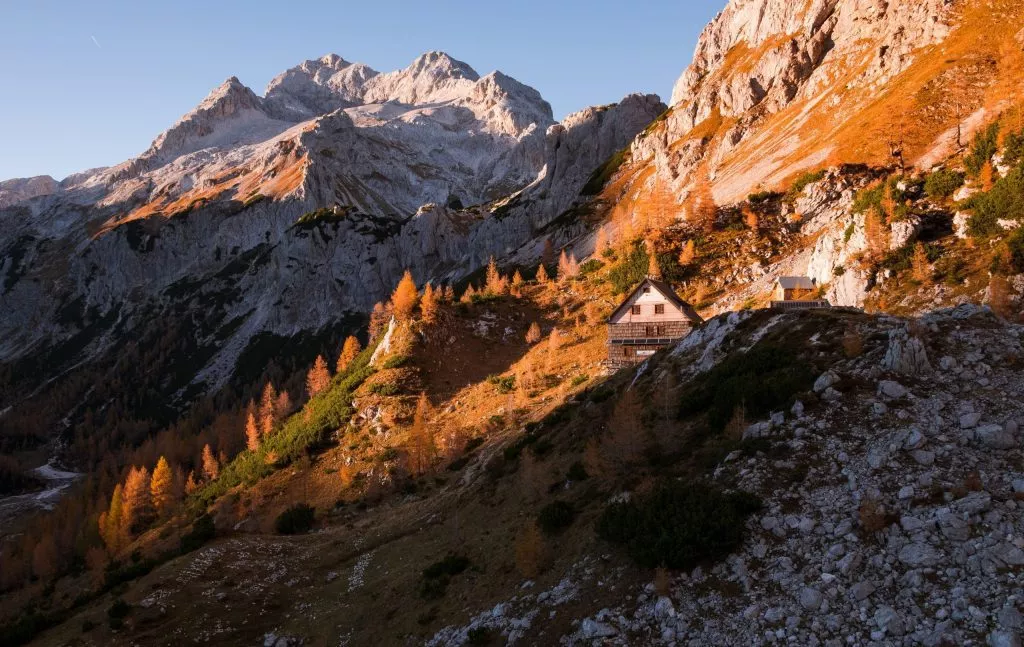
Dom Valentina Staniča pod Triglavom (Stanič Hut)
This hut is the least known one amongst foreigners, because it is a little farther from Triglav and so not as convenient for an early ascent the following day. Still, a lot of people stop at it on their way up from the Vrata Valley (Prag or Tominškova routes). If you like to stay away from the hustle and bustle of the Triglav Huts, stay at this hut.
Altitude: 2332 m
Season: July – September
Capacity: 97
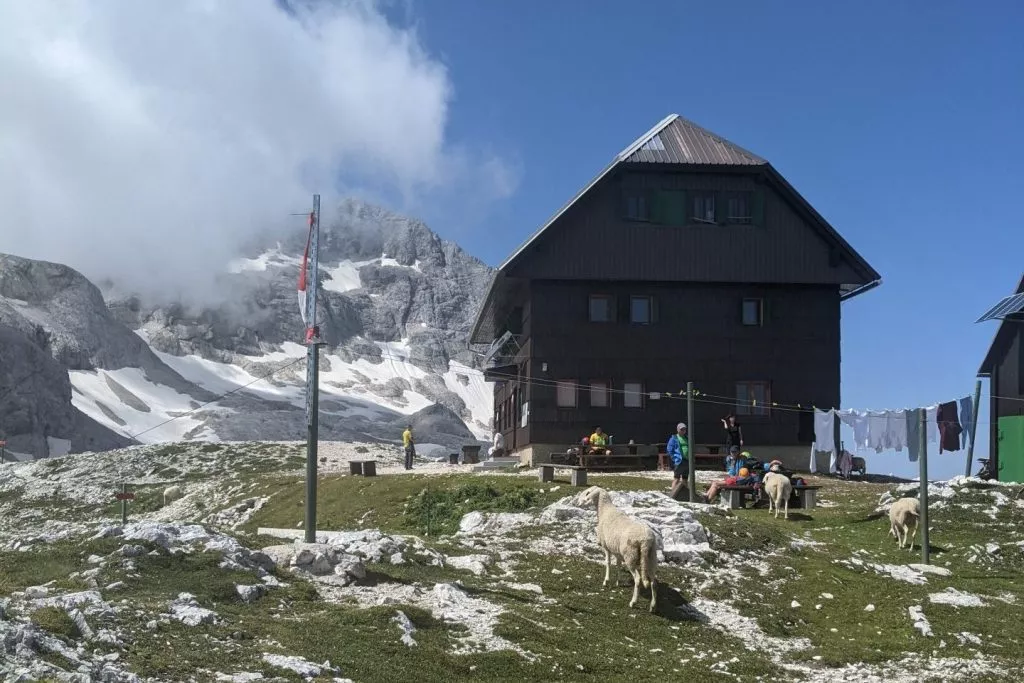
When to Climb Triglav?
The best time to climb is in the dry season, from June to October. The most favorable period is from late June to early July, as this is when the natural scenery is most vibrant, and there are fewer people.
The peak season occurs between August and September. In these months, Triglav experiences a surge in climbers, with more than 2,000 people ascending daily. If you must visit during this busy period, consider consulting a local guide for alternative, less frequented paths.
Winter ascents (November to early June) are also possible, but these are reserved for experienced climbers. It’s when the Julian Alps experience the harshest weather conditions and climbing becomes extremely unpredictable.
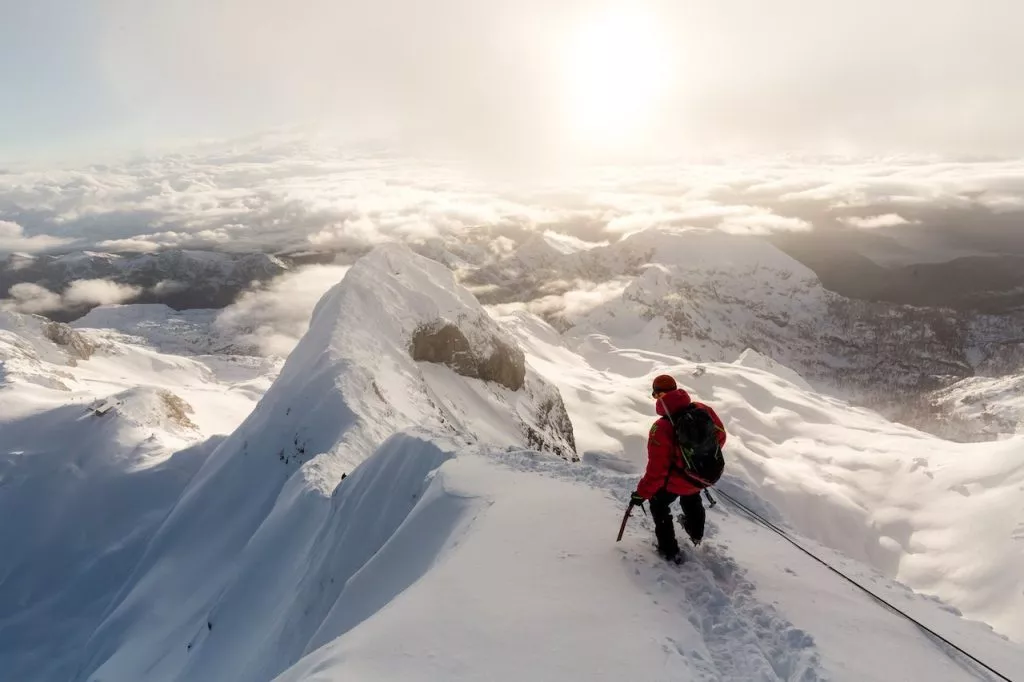
Weather
In the summer season, the average daily weather in the Julian Alps is warm and clear skies the first half of the day, and then a possibility of afternoon storms. That’s why hiking early in the morning is crucial for a safe hike.
But remember, weather in the mountains can change super-fast, which means that just a look up at the clouds might not be telling the whole story. That’s why you should definitely check the weather forecast a few days before you plan hiking Triglav.
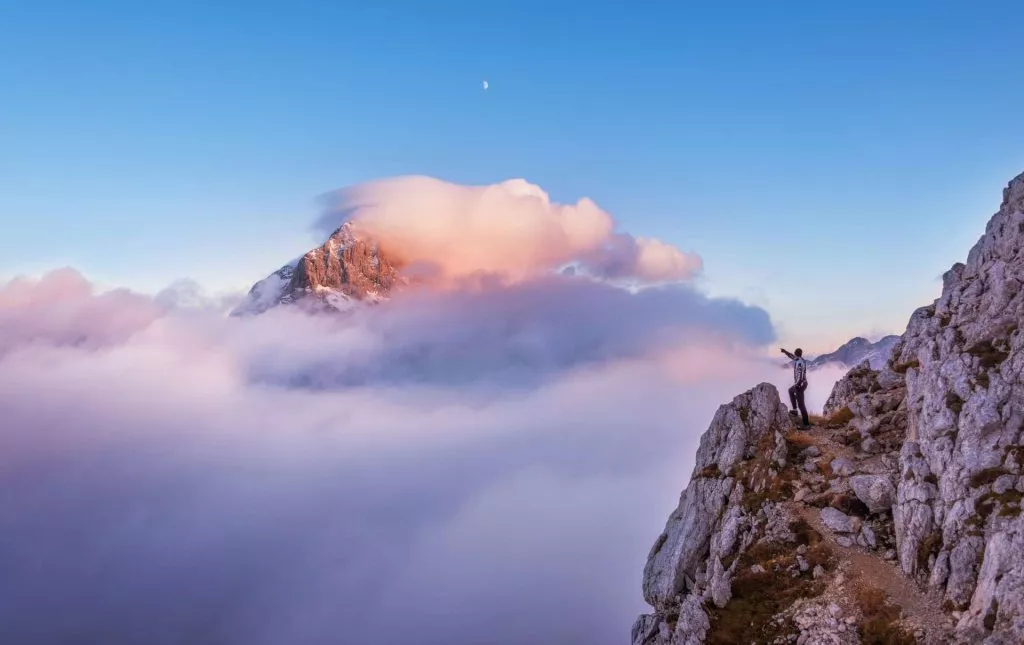
The best resource for doing that is at the website of the official Slovenian meteorological institution ARSO here, or on this mountain-specific forecast. Unfortunately, they still don’t have their text weather forecasts (the most useful and reliable) translated into English, which makes it quite difficult to understand.
Reading weather forecasts and reacting to the weather conditions on the ground is not as easy as it sounds. You don’t want to get caught in a storm at the Triglav peak. That’s why having an experienced guide beside you is still the safest option.
Equipment and food
Climbing Triglav demands special equipment and hiking gear, but minimalism is something to keep in mind because you don’t want to be heaving a heavy load all the way up there.
Remember, whenever in doubt about what to bring with you, a friendly local guide is your best source of information. Additionally, you can also hire equipment, so don’t worry if you didn’t bring your helmet with you on holiday.
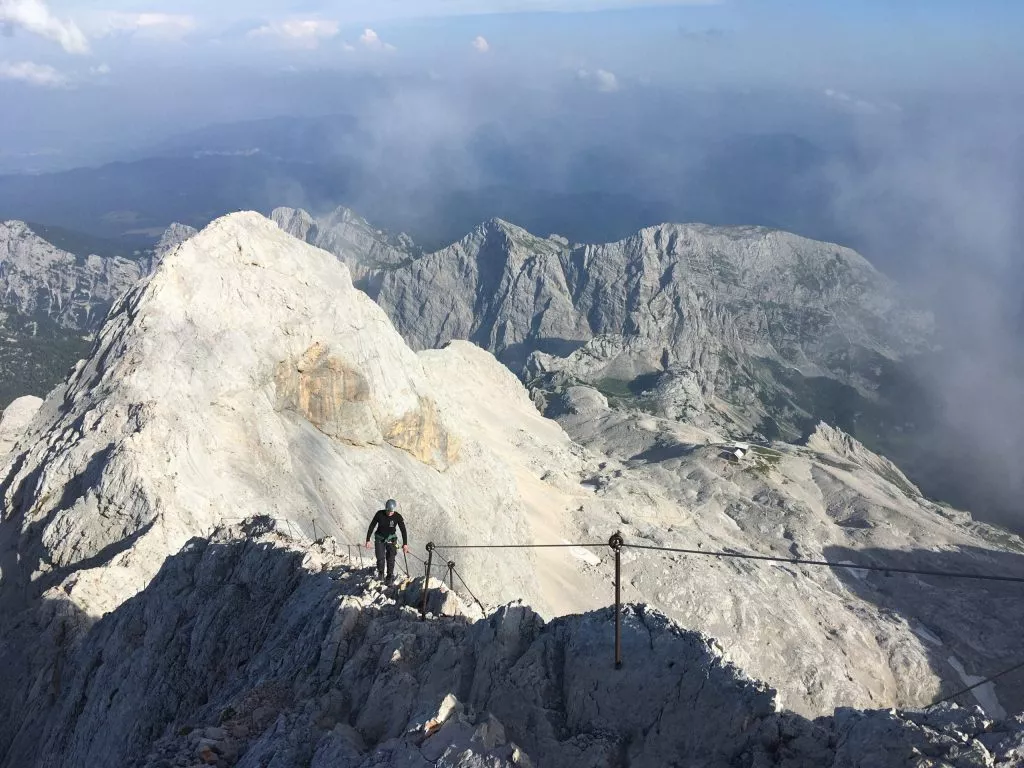
The most important piece of equipment are definitely the shoes, which need to be made for hiking. This means hiking boots, hiking shoes (not as high and stiff as the boots) or trail running shoes with extra protection. What you choose depends on what you are used to, and how much ankle protection you need.
As for food, it can be acquired at any of the huts around Triglav, warm meals, desserts and more. Still, don’t expect anything too fancy. You should also take some high-energy snacks with you for on the way, so you don’t arrive at the hut fully exhausted.
The same can be said for drinks — you can buy them at the hut, but should have at least 1,5 litres of liquids per person with you already. You can have only water, but even more preferable is to have some kind of isotonic drink to replenish your electrolytes.
Check out the list below for an easier time packing for your tour:
- Comfortable sports clothes
- Insulation jacket
- Spare socks, underwear and shirt
- Gloves
- Toilet paper
- Snacks
- Headlamp
- ID card
- Trekking poles if you are used to them
- An extra layer of clothing
- Rain jacket
- Headwear
- Sports shoes with good grip
- Water bottle
- Sunscreen
- Toothbrush
- Sleeping liner (disposable can be bought in the hut)
Additional Tips
Here is some additional advice that will help you when climbing Triglav.
- If you are planning to hike Triglav in one day, start earlier than 6 AM.
In summer, mornings usually have clear weather, while afternoons are usually potentially stormy. Wake up early, so you can reach the peak and be way on your way down before the first clouds. You’ll also have better views too.
- If you are hiking in the early season, be sure to check if there is snow.
In June, there might still be snowfields on your route, especially north-facing routes. Choose the route with no snow, because even a little requires extra equipment if you want to avoid dangerous situations.
- Look for the trail markers and hiking signs.
Trails in Slovenia are marked by a Knafeljc blaze, a red circle with a white dot inside. Routes can be also marked by red arrows or similar lines. Be sure to check if you are going the right way at every junction. Signposts usually signify the direction of peaks and huts. Some rocky paths might also be marked by piles of rocks called “možic”.
- Buy a physical map or download an app.
Blazes and signposts might sometimes be confusing. That’s why it’s very important to also have a map with you. That could be either physical or an app on the phone (Maps.me, GaiaGPS and more). Be sure to have your phone charged and also have a fully-charged powerbank with you in this case.
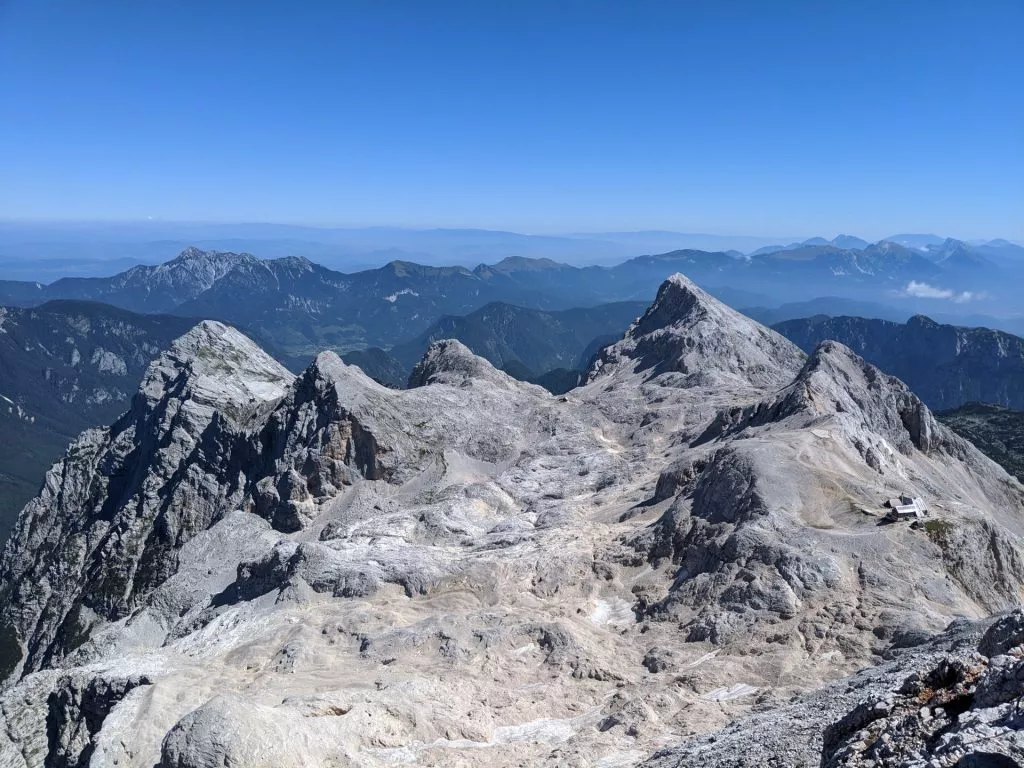
Where to stay before hiking Triglav?
First of all, this depends on where does your planned route start. You want to be as close to the start as possible. In some cases, this means you can stay in mountain huts that are in the valley, or in a nearby town or village.
Krma, Vrata or Kot routes
If you are hiking from any of these three Triglav valleys, it would be the most convenient to stay in Mojstrana or if you want a more high-level stay, Kranjska Gora.
Mojstrana is a small village at the start of all these trails, so you’ll have to drive to the start of the hike the next day. Kranjska Gora is further away but is a fully-fledged alpine resort, which means you have there all the amenities you need.
If you are hiking from Vrata Valley, you can also stay at the Aljaž Hut, which means you can go to hiking straight on the next morning.
From Pokljuka
In this case, you can stay at the Sport Hotel at Rudno Polje, Pokljuka. But if you want more comfort and luxury, stay in the nearby Lake Bled, the alpine pearl of Slovenia. Now that would be a full Julian Alps holiday!
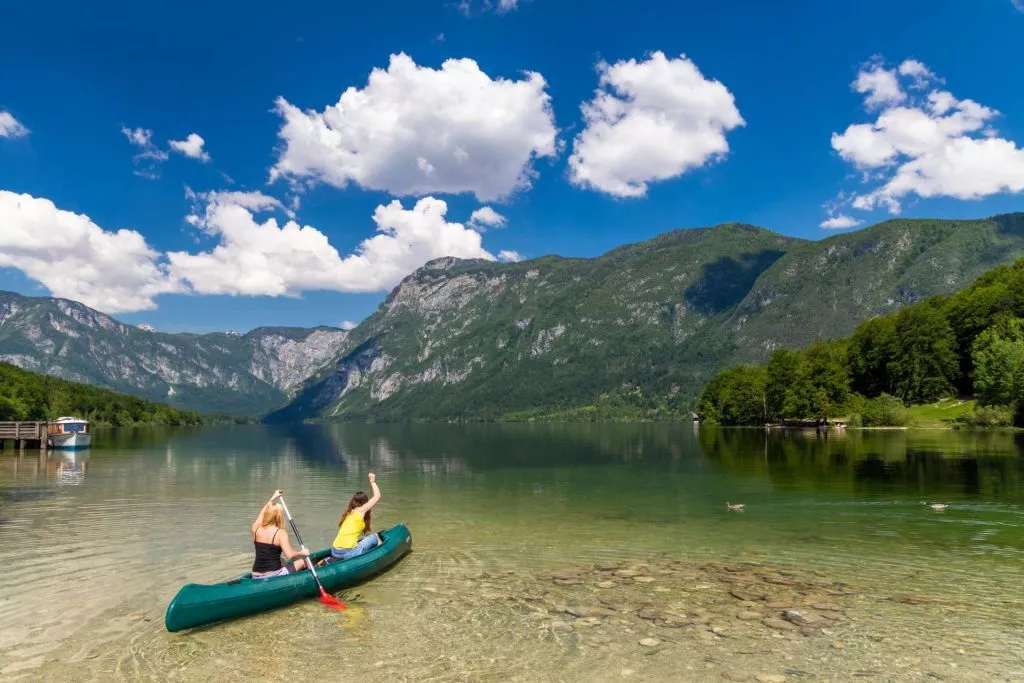
Through the Triglav Lakes Valley
As the route starts in Bohinj, it’s best if you stay in one of the many apartments or hotels around the lake. Alternatively, you could also stay at Bled, but then you would of course need to drive for about half an hour before starting the hike.
From Trenta
There are accommodations available in the Trenta valley, but not as plenty and as diverse as in the nearby town of Bovec. The adrenaline capital of Slovenia is the centre of the Soča Valley and offers many other adventurous activities that will make your vacation in Slovenia perfect.
Should I go with a guide?
Whatever Triglav mountain hike you end up choosing you will have an amazing time. This Slovenian giant is truly an experience on its own. Enjoy it, not struggle with it.
Guides are certified professionals with many years of experience in mountain climbing. They know the most optimal routes and possess all the necessary know-how that makes your journey easier, and above all, safer.
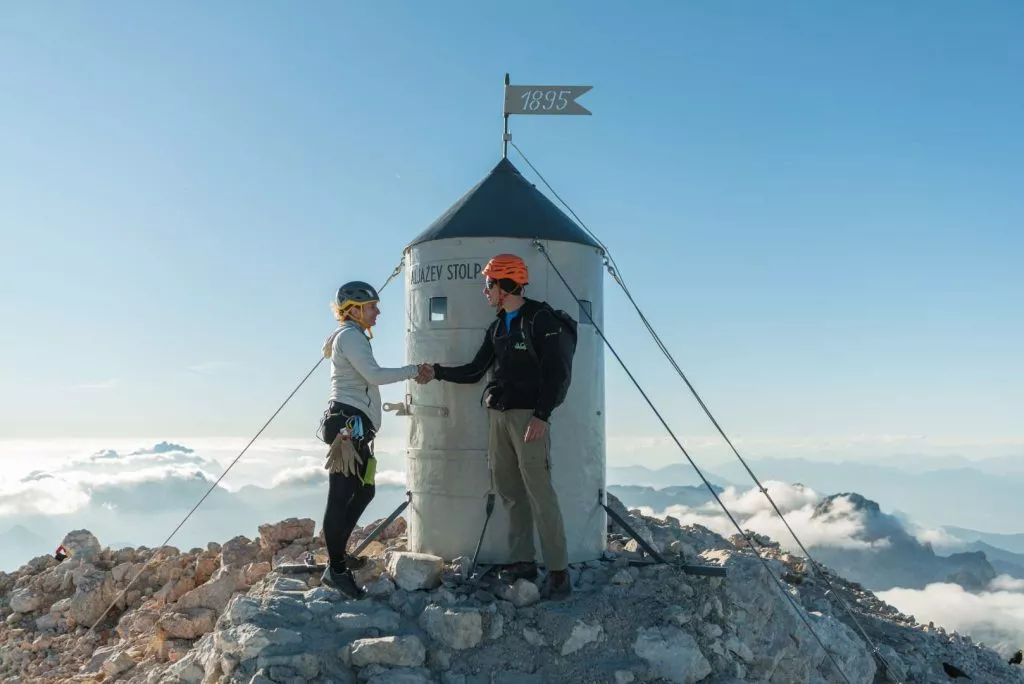
Local guides are also fluent in English and can share some amazing insights about the mountains, Triglav, the wildlife, the history of the place, fun trivia, etc. Their skills and knowledge will undoubtedly prove useful to have with you as a backup in case of any eventuality.
Whatever your choice in the end, explore our careful selection of guided Mt. Triglav tours.
